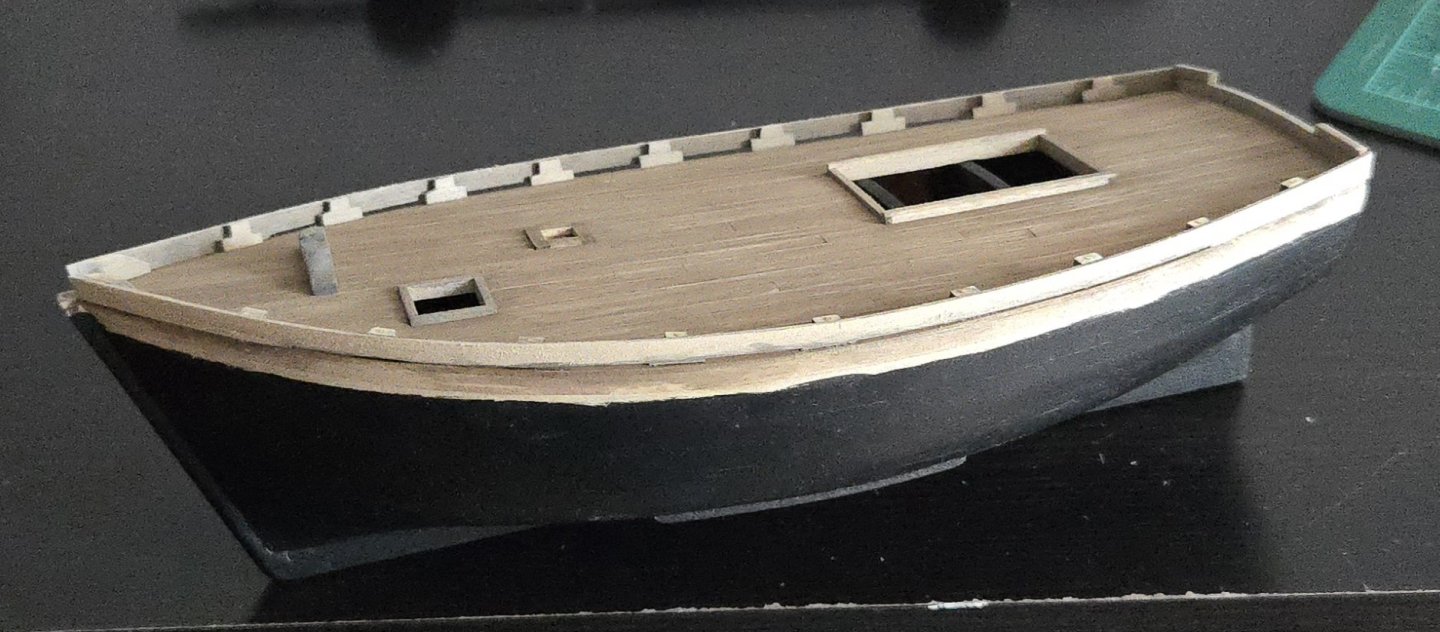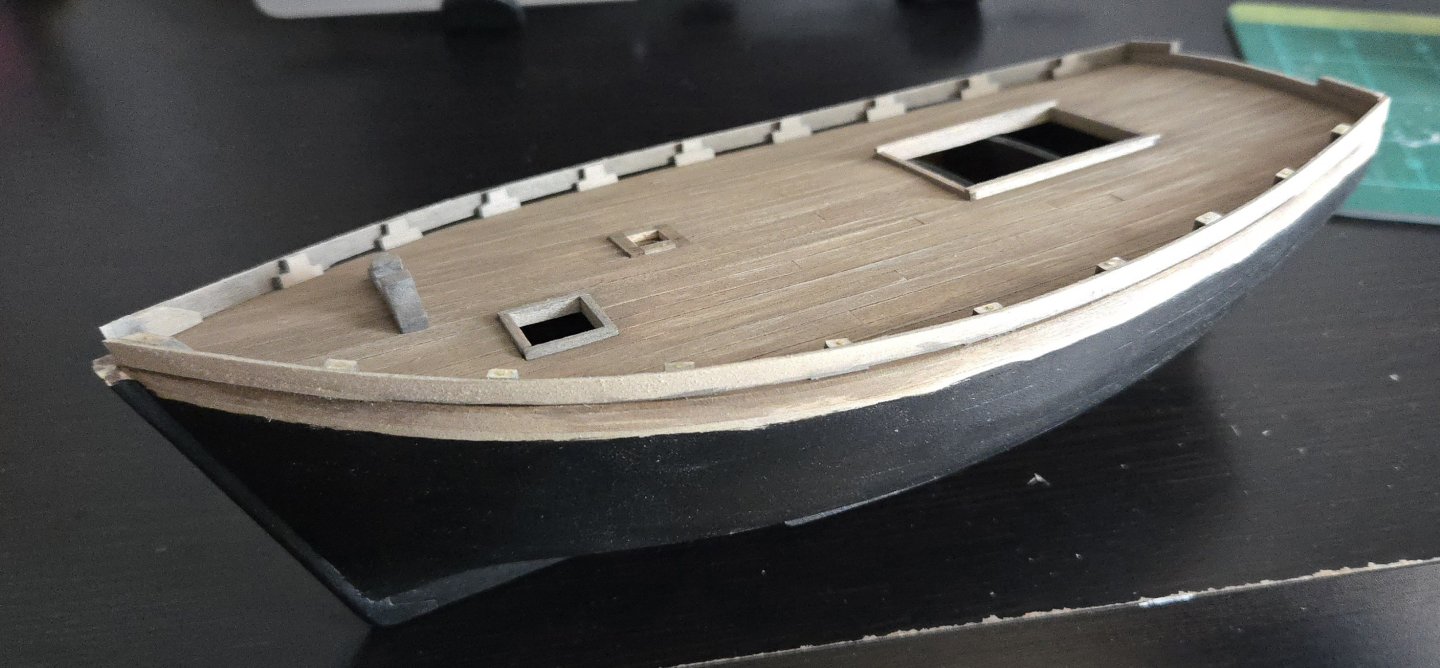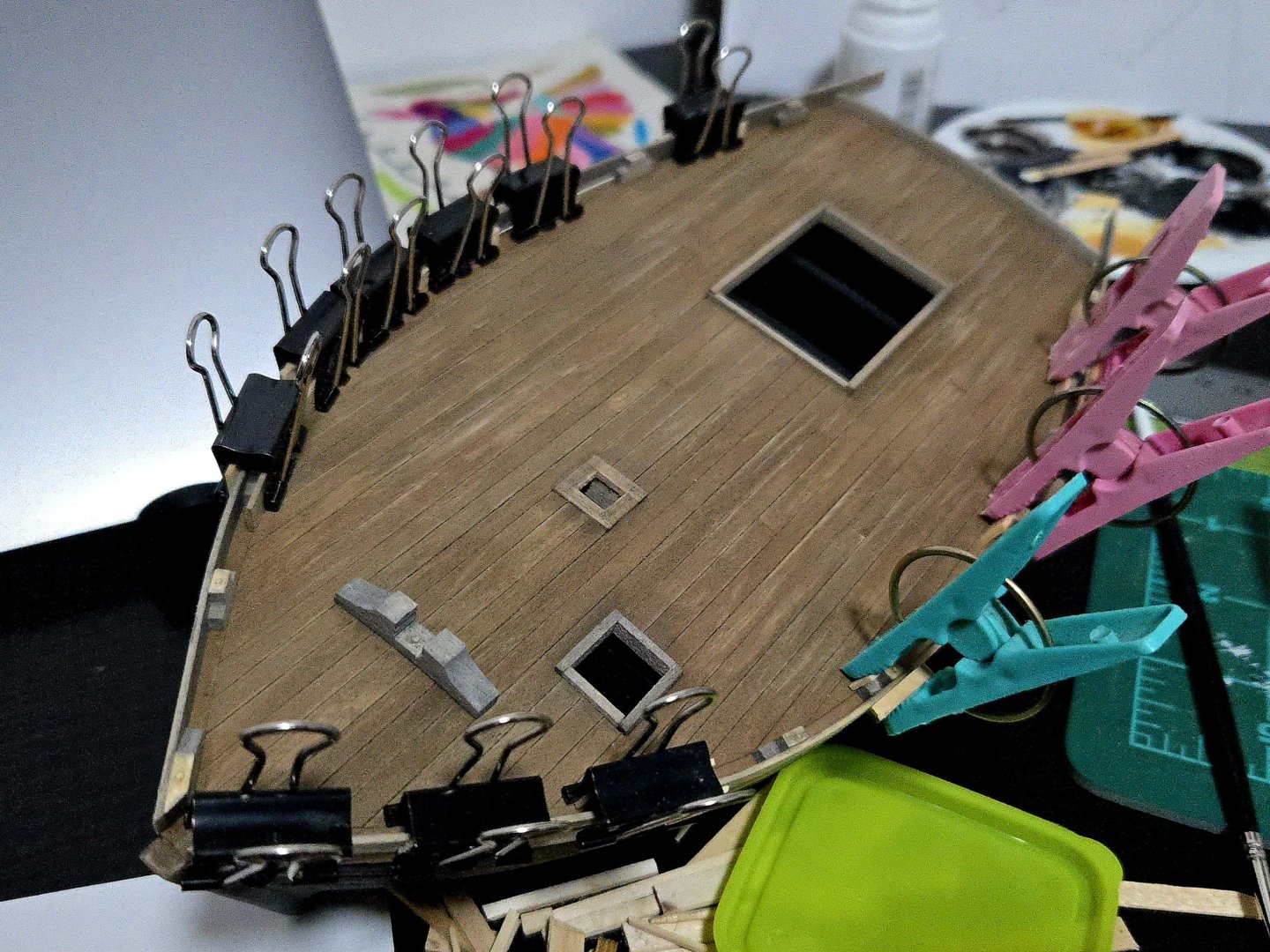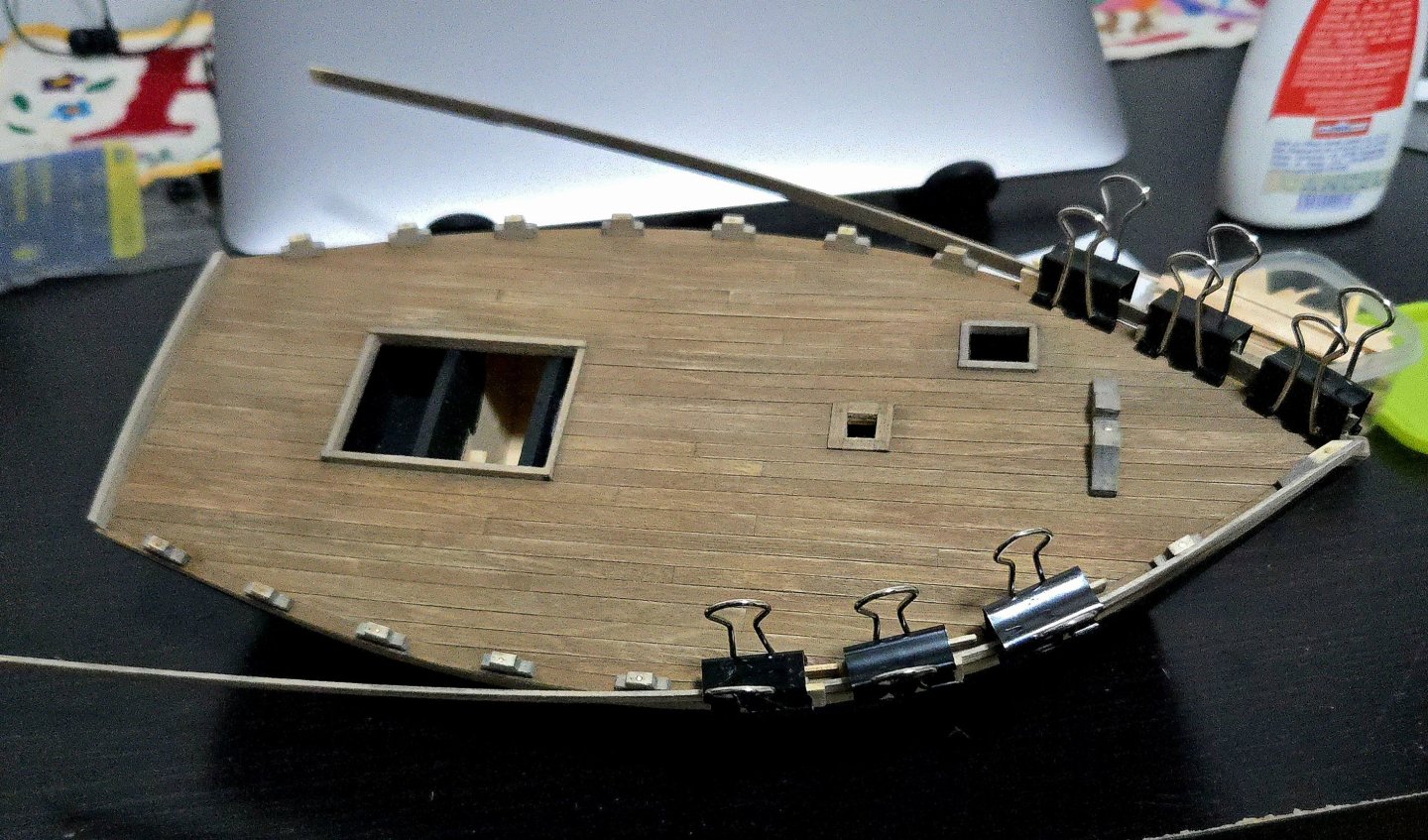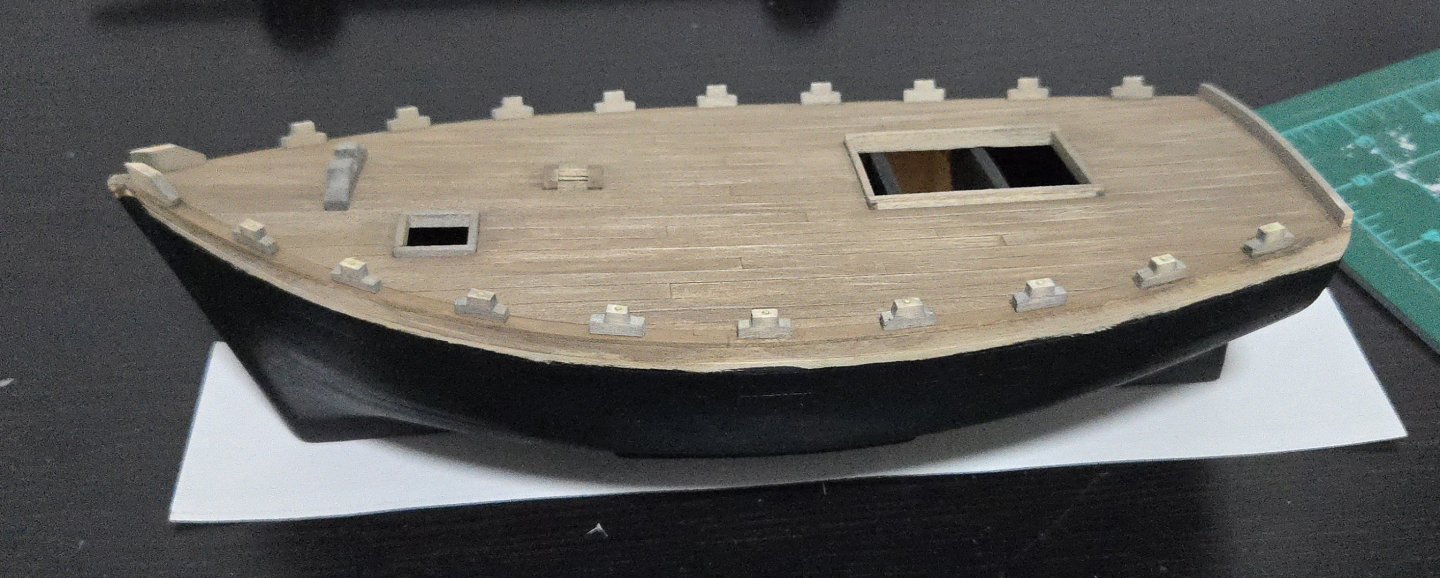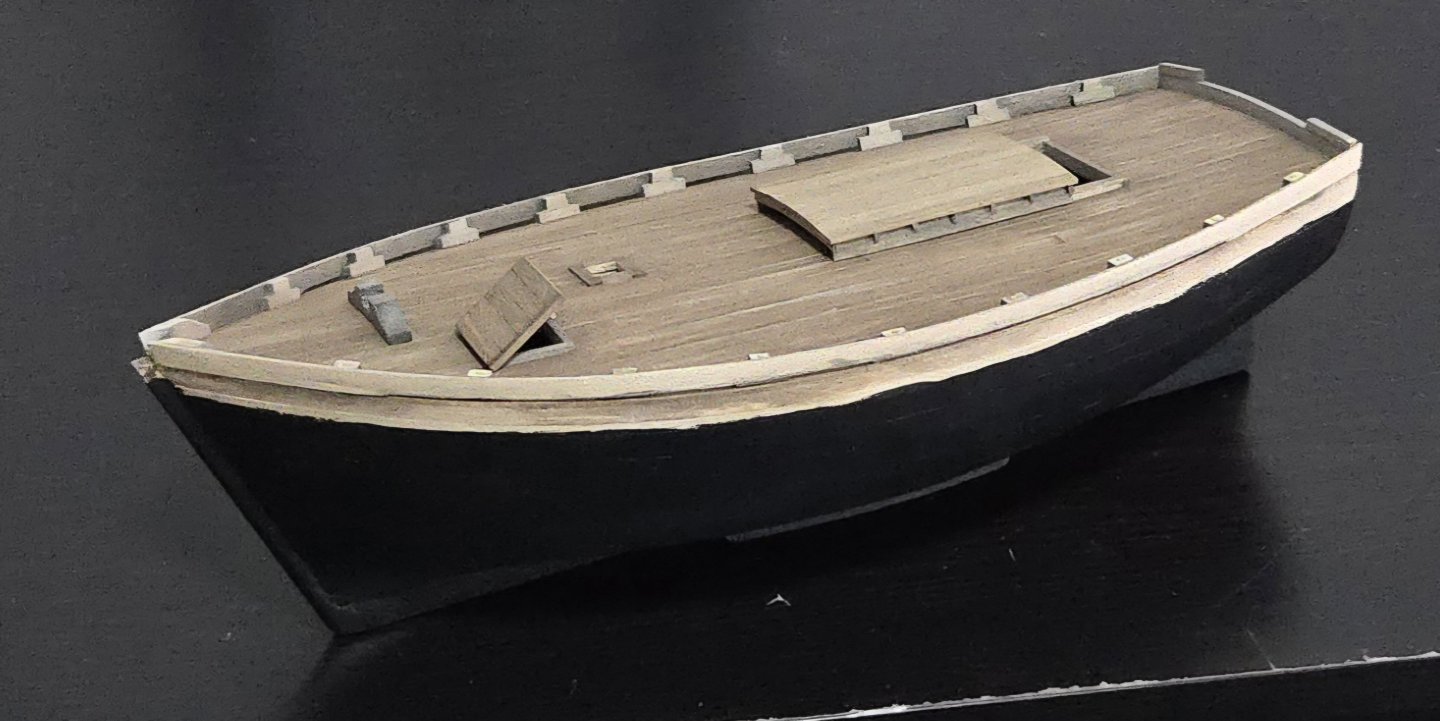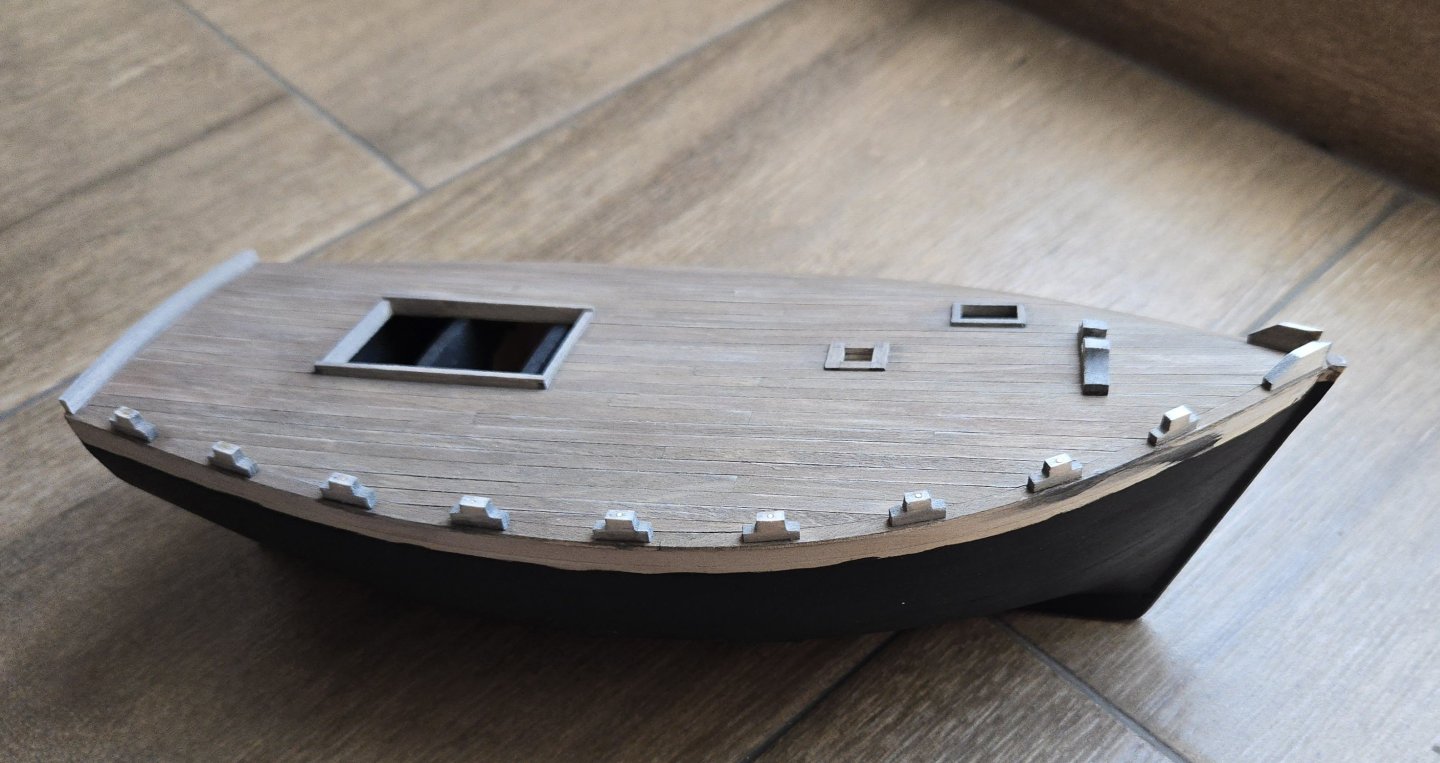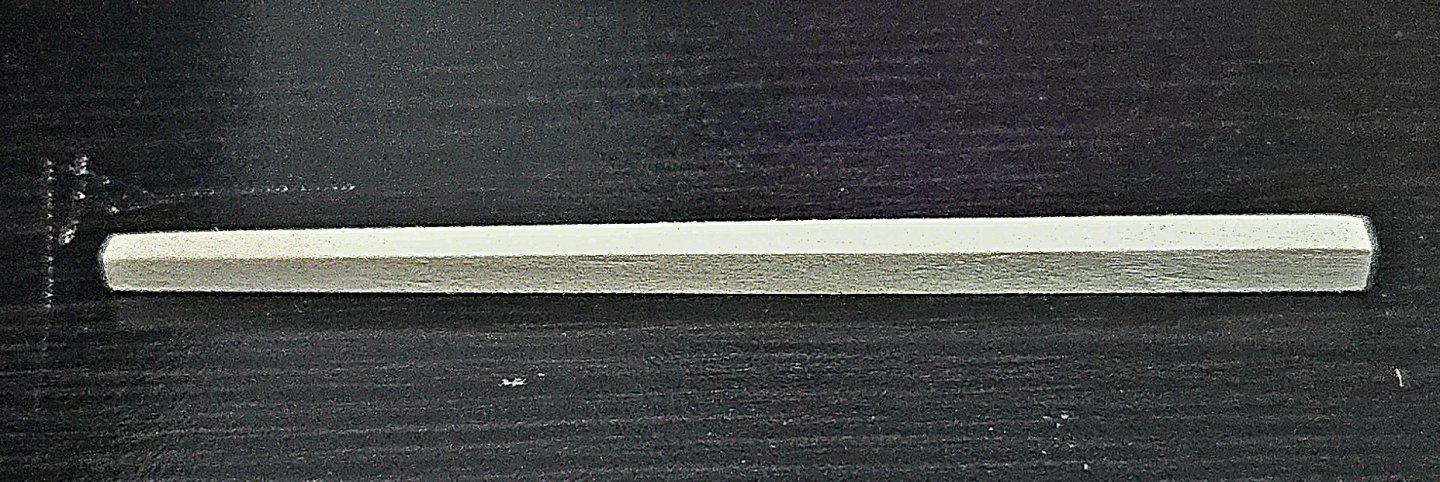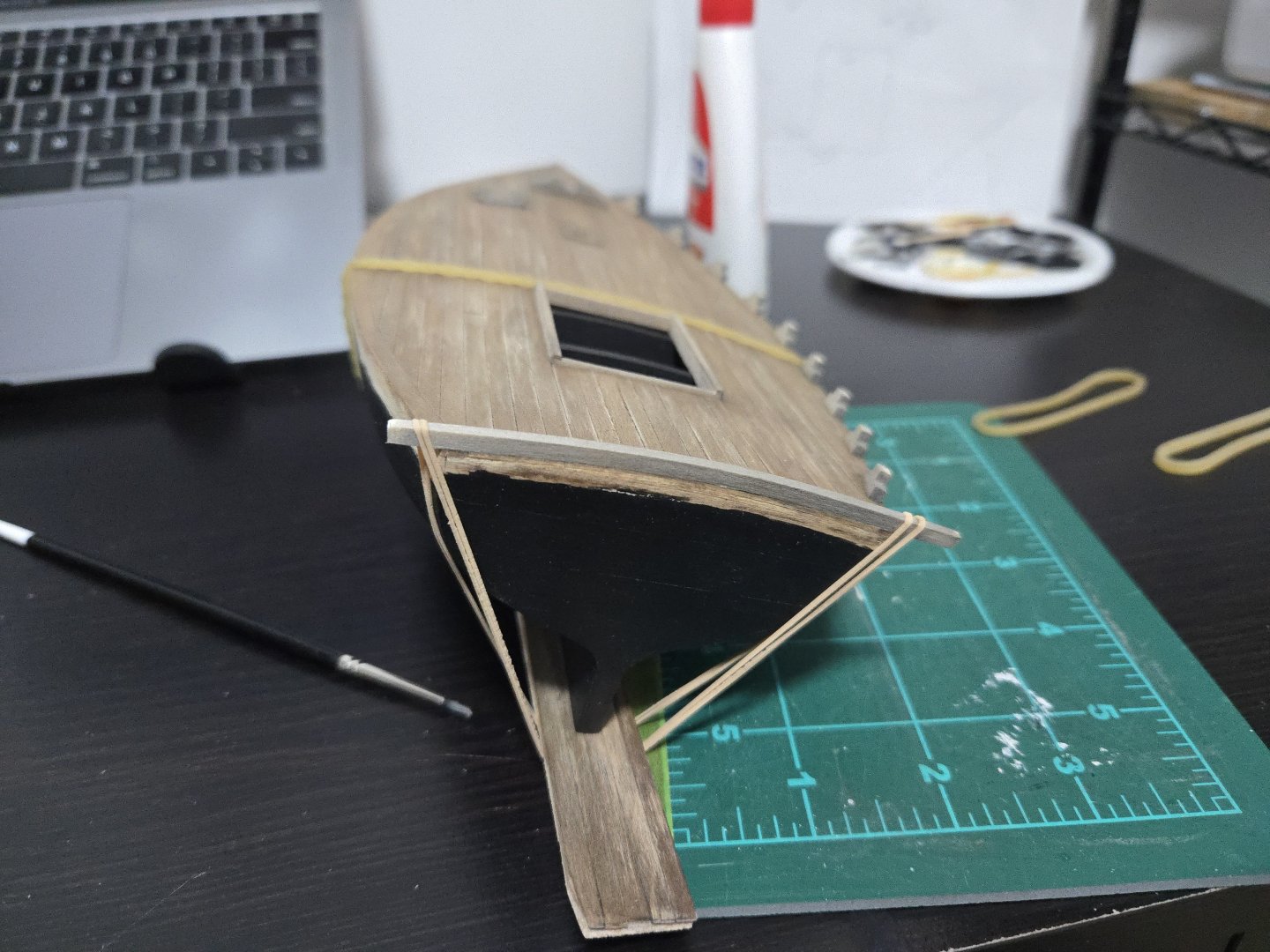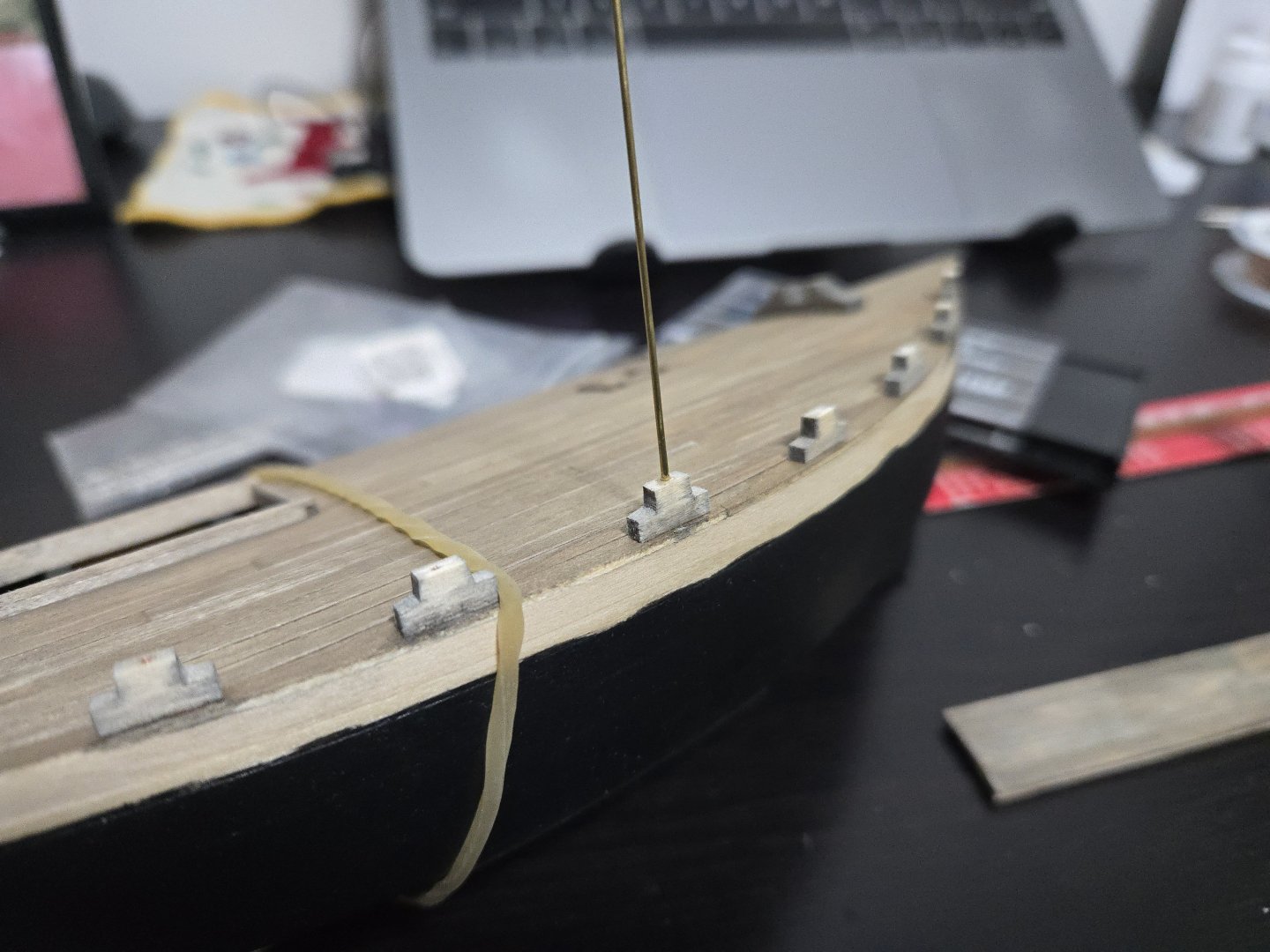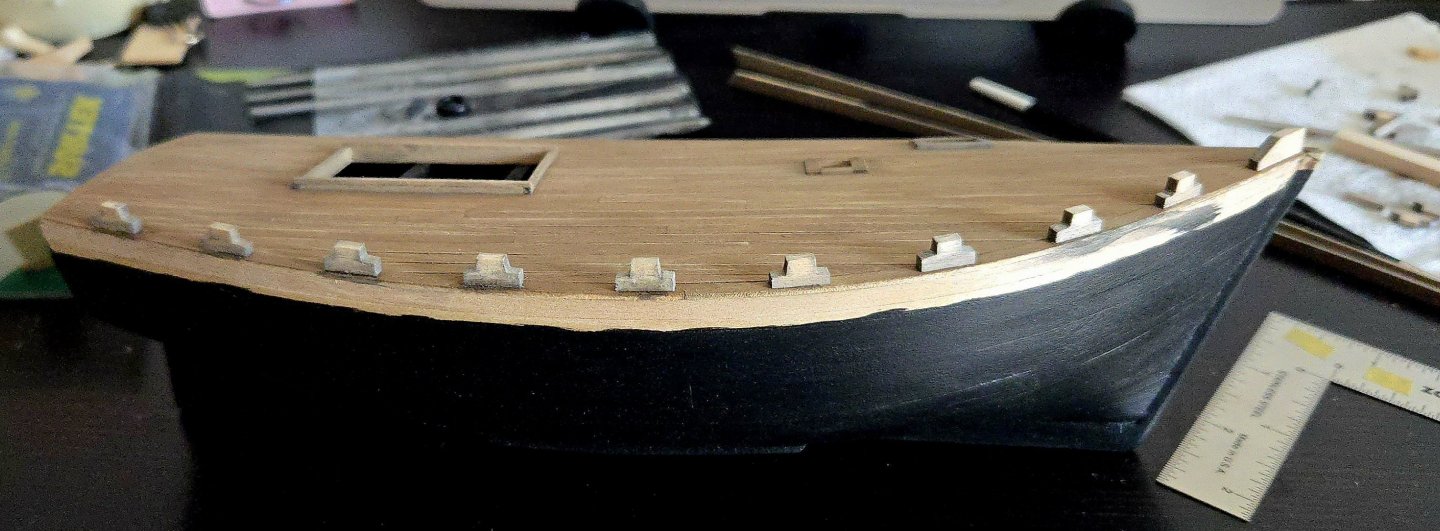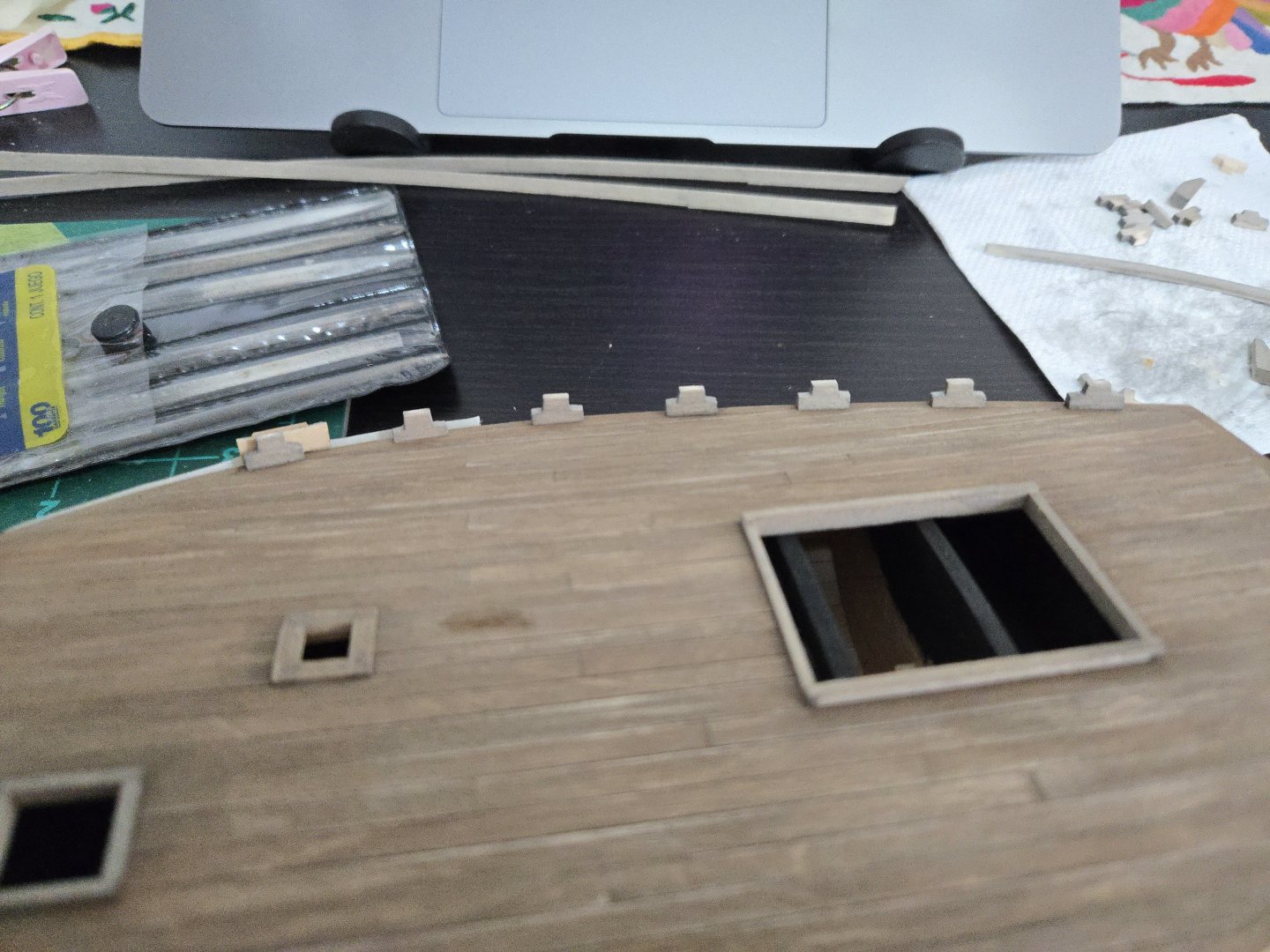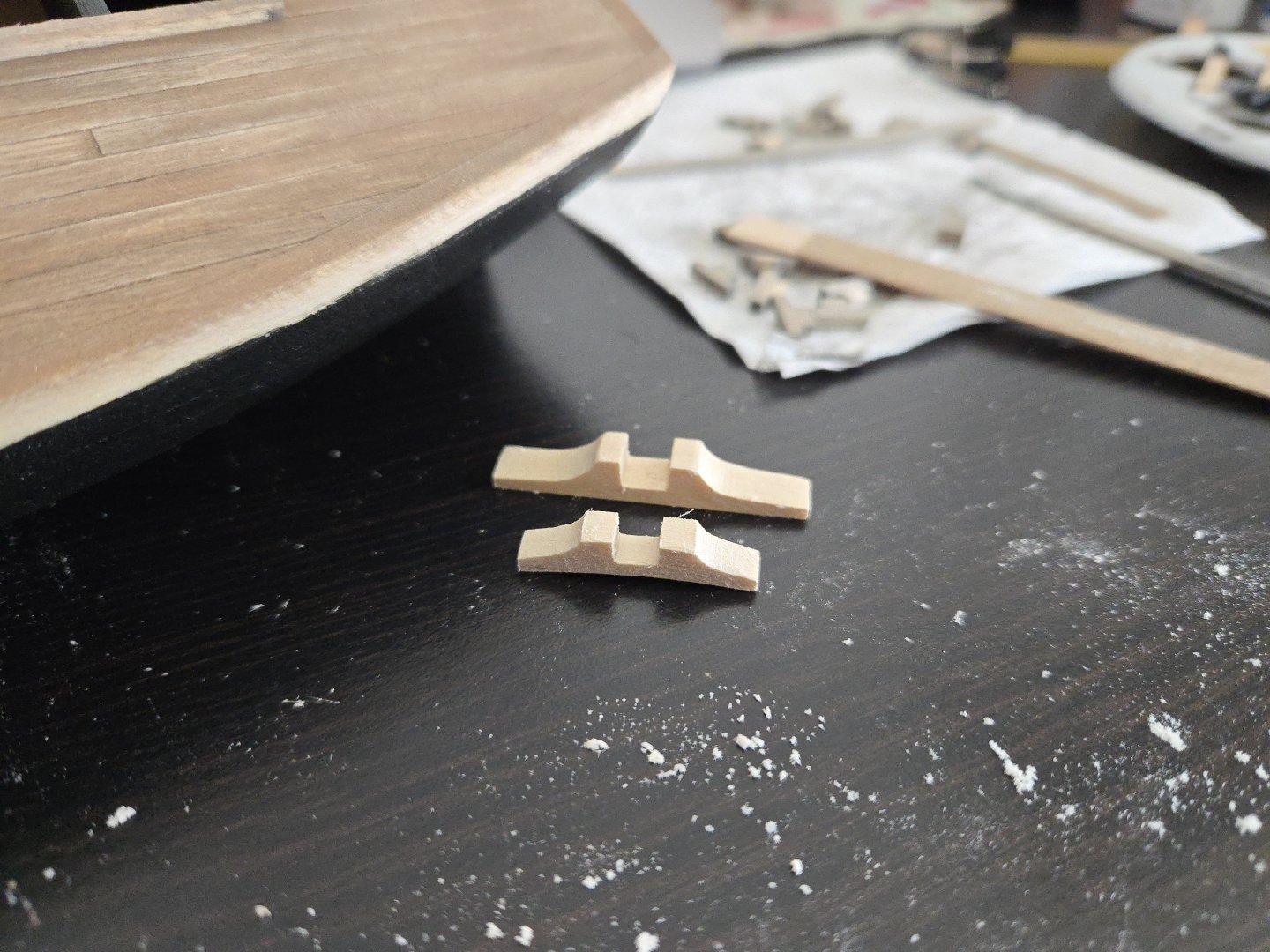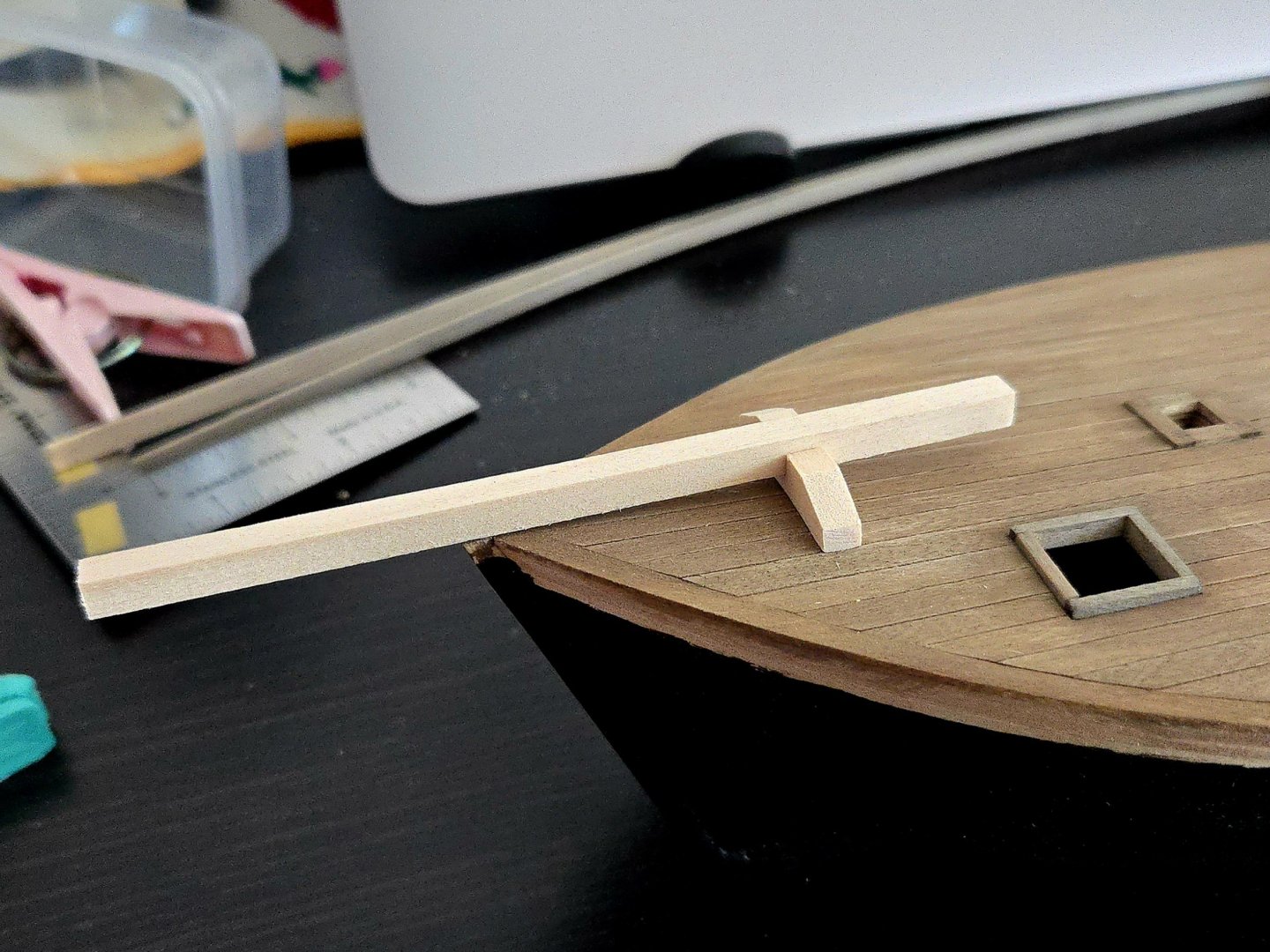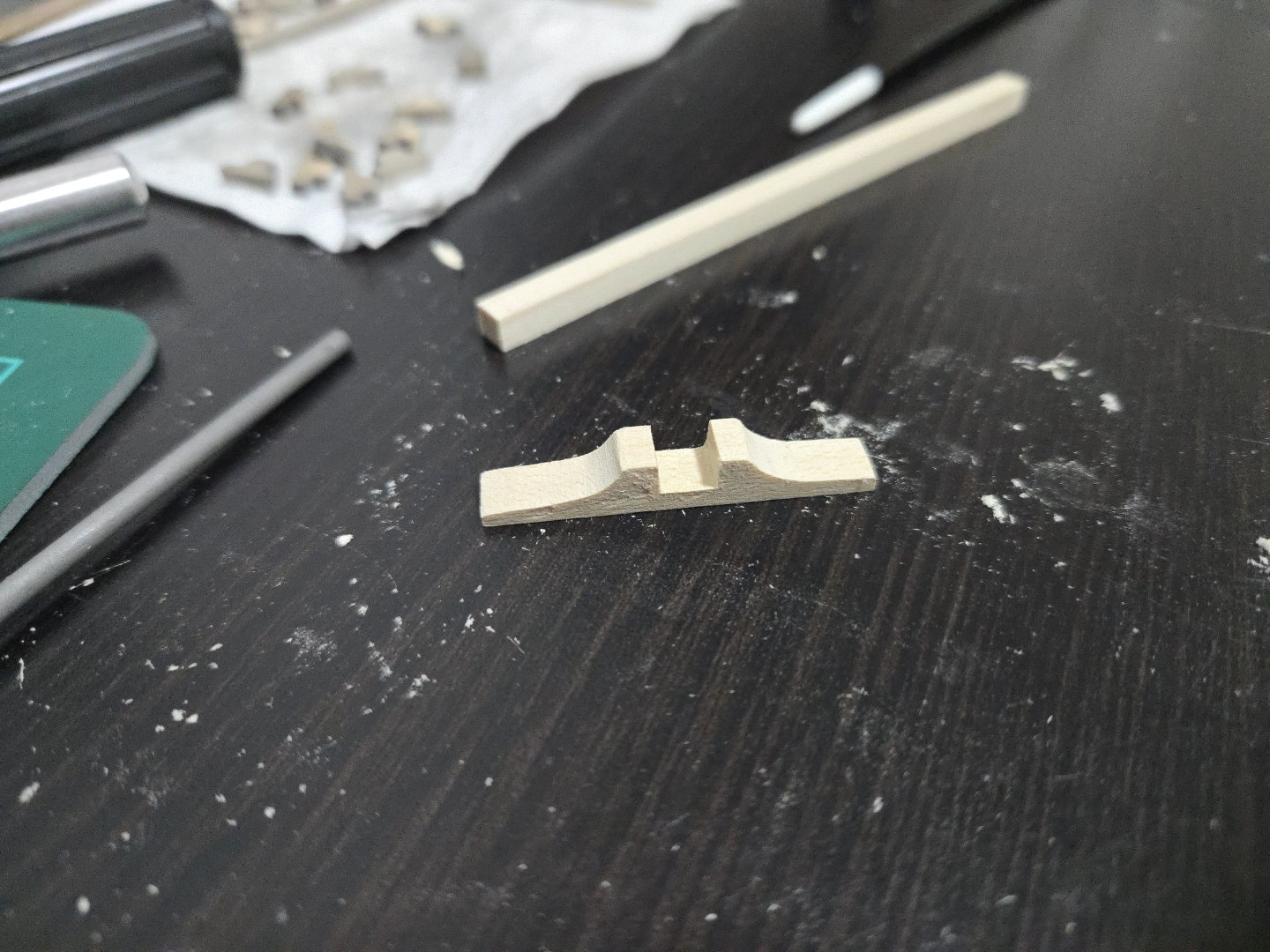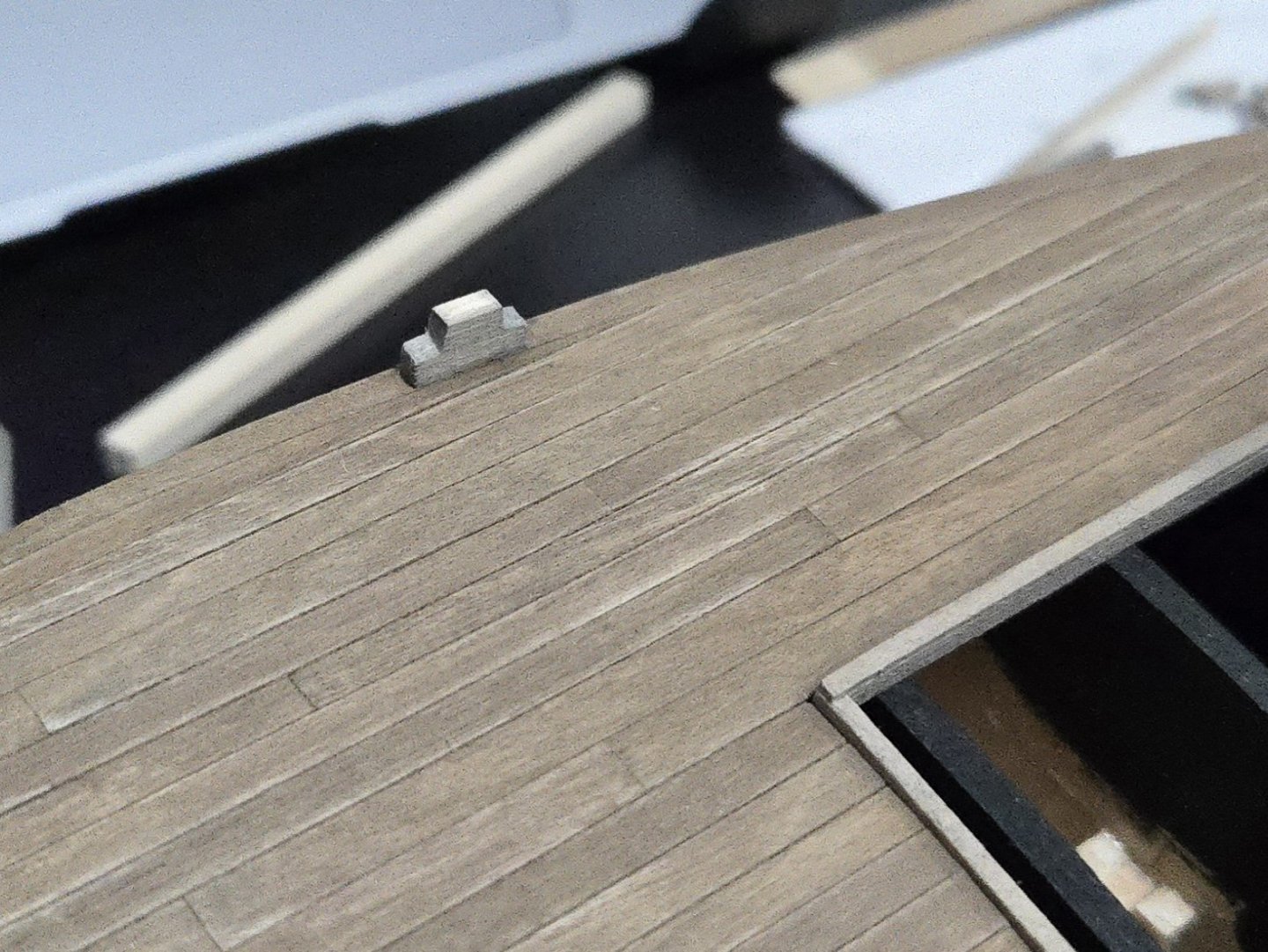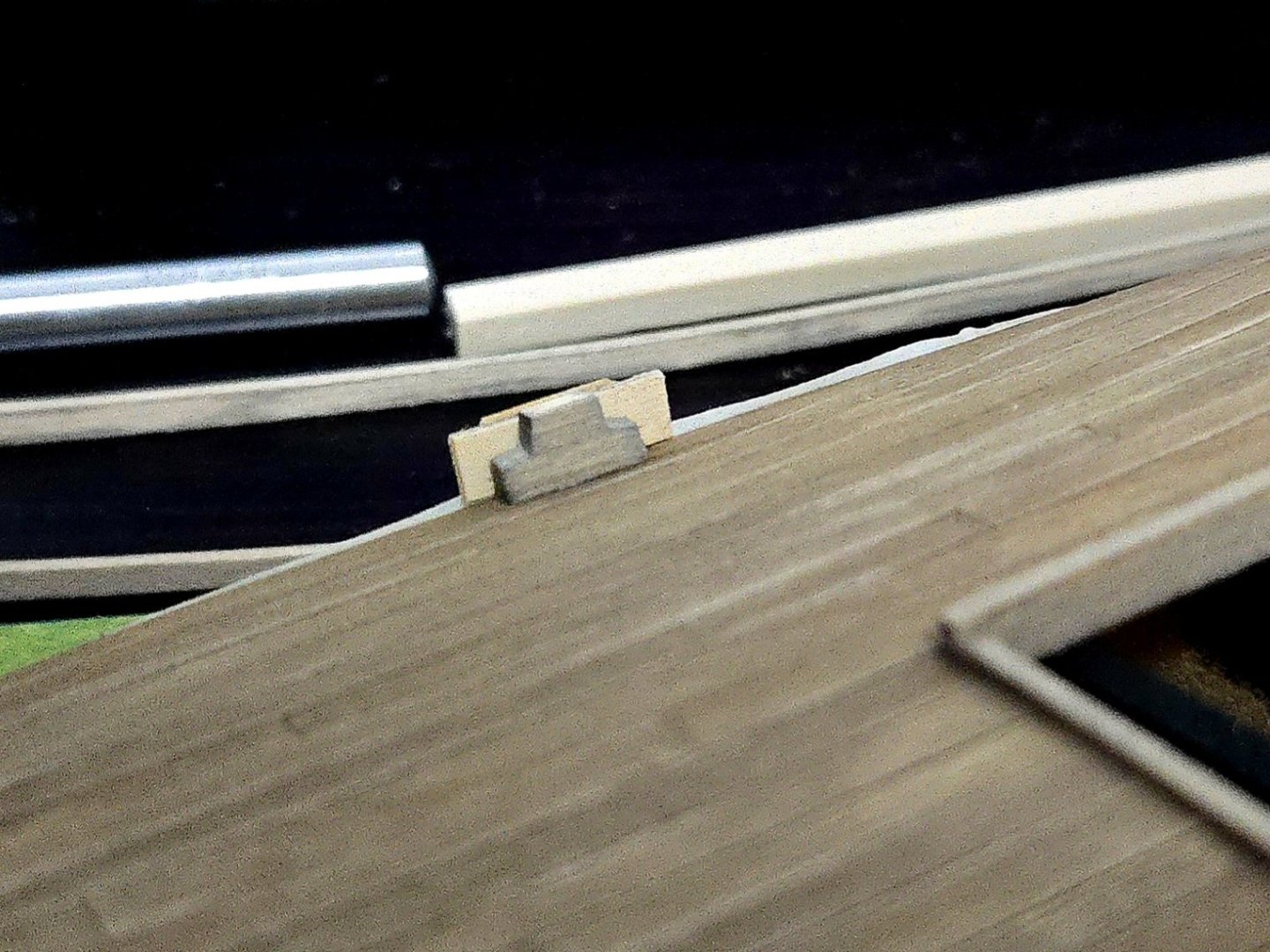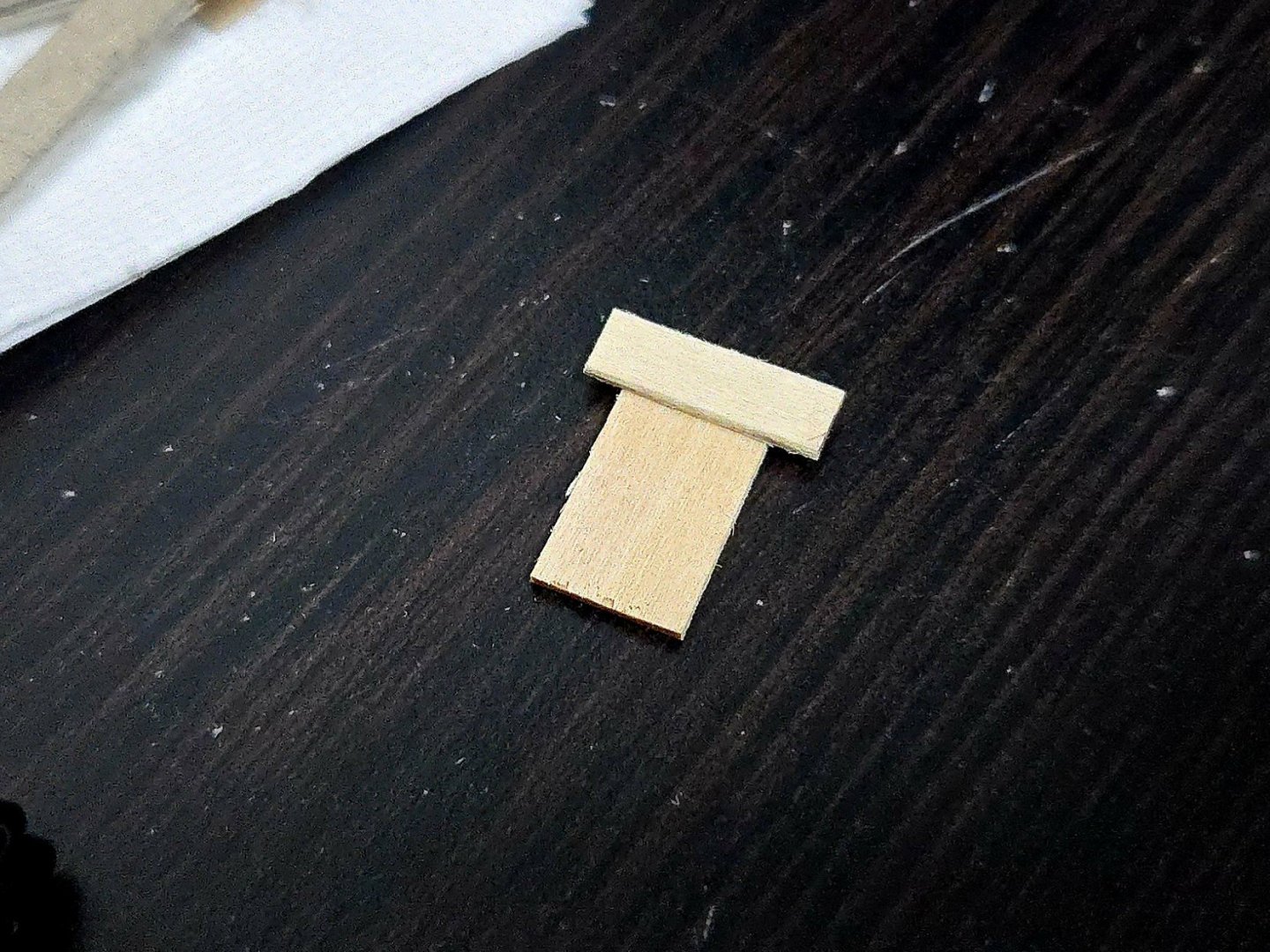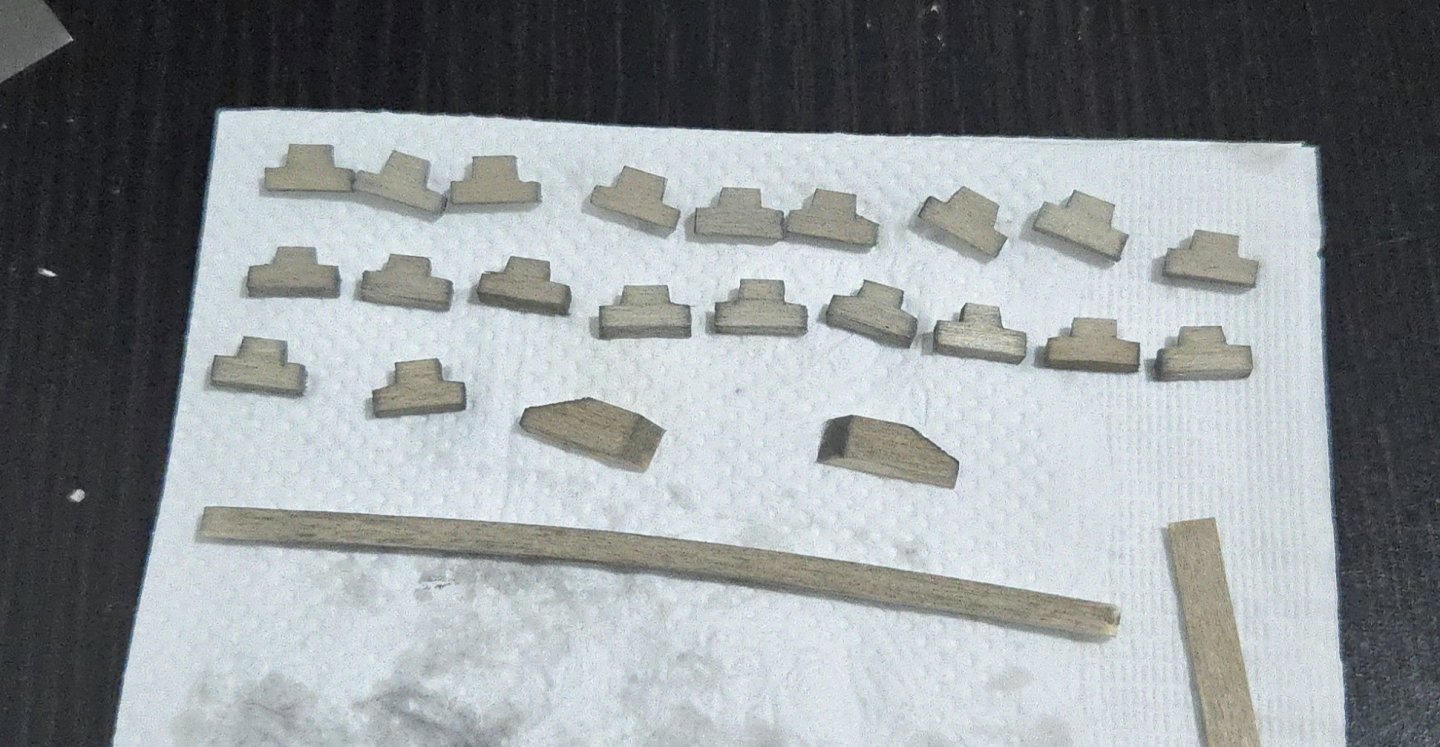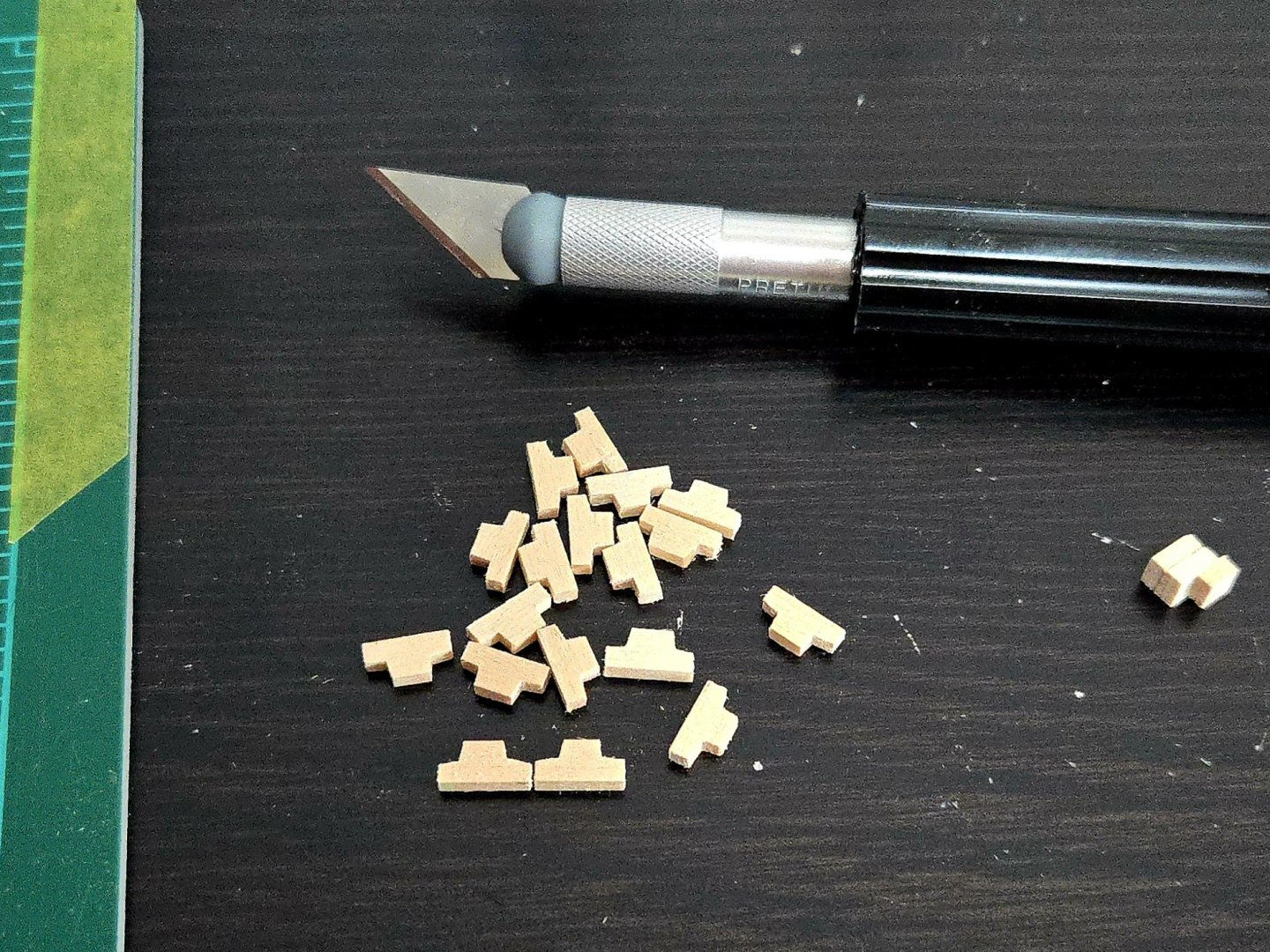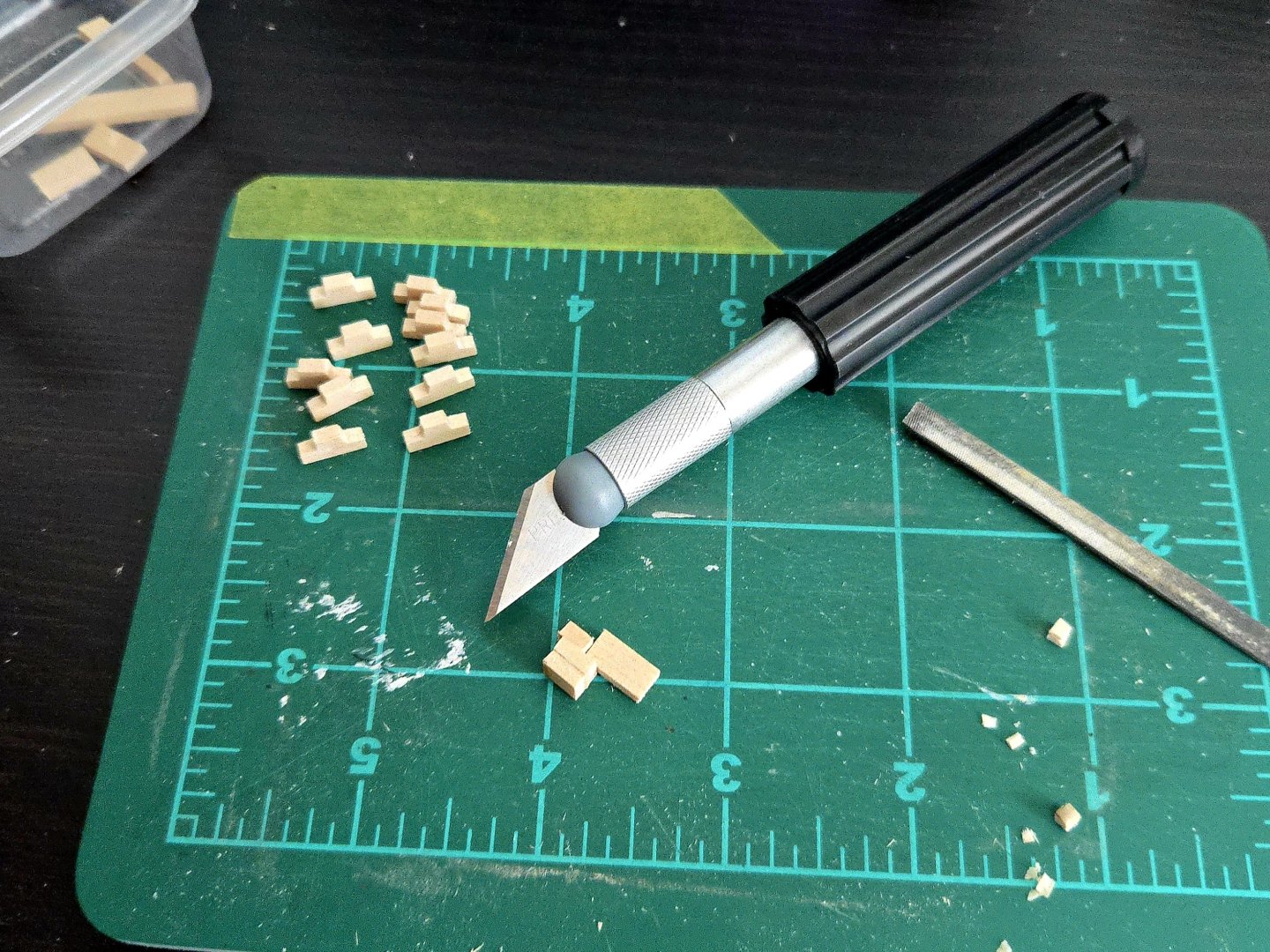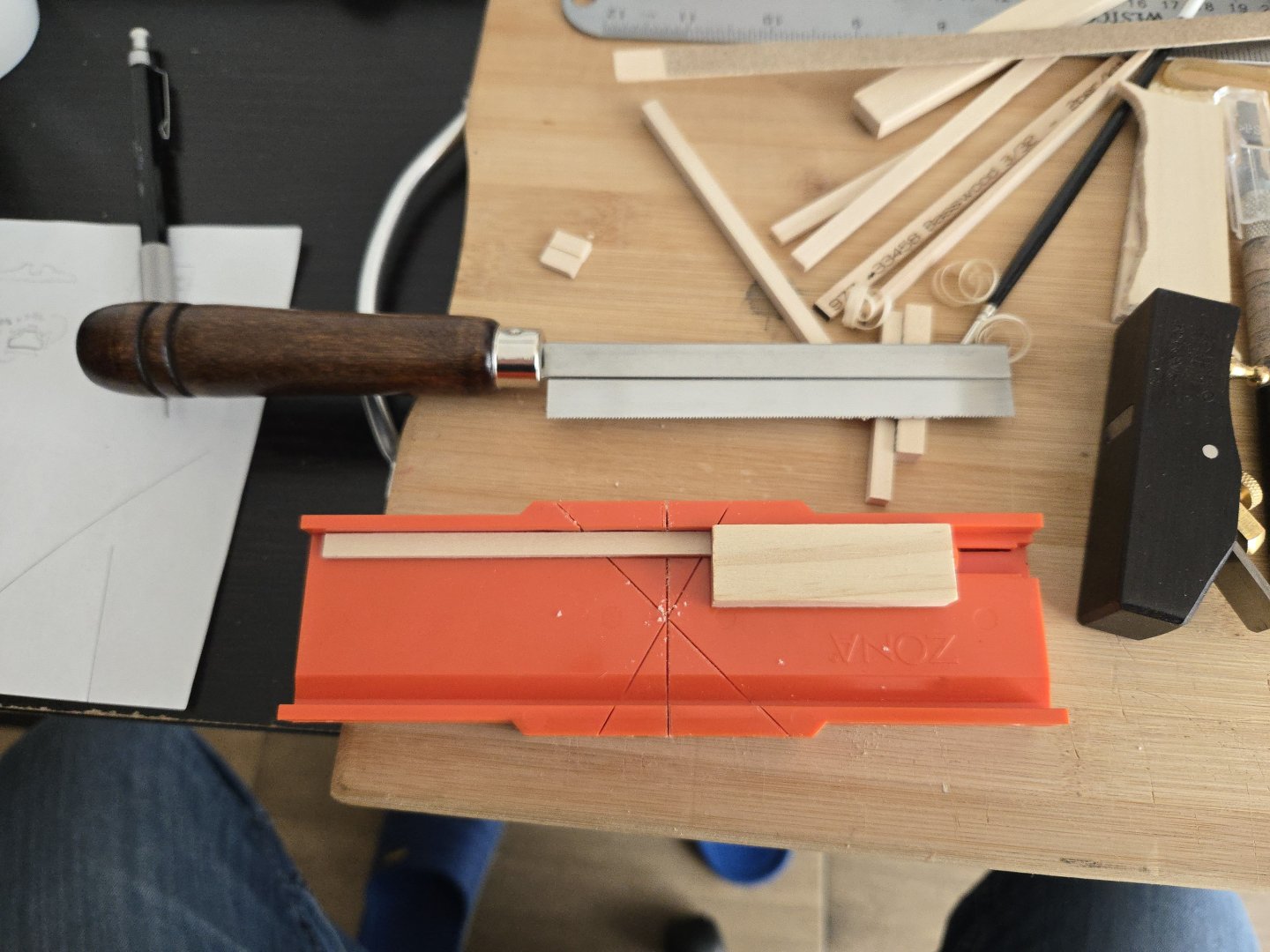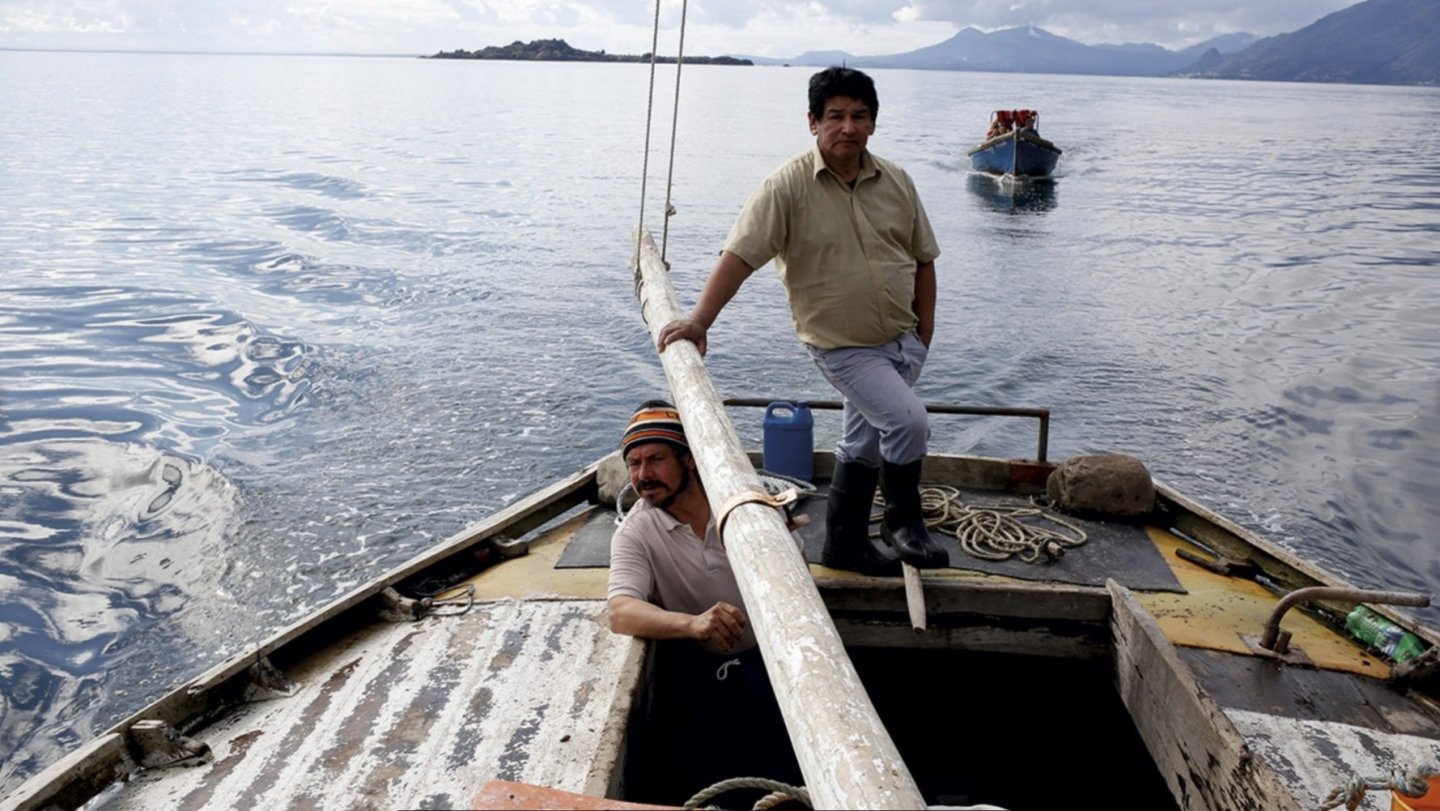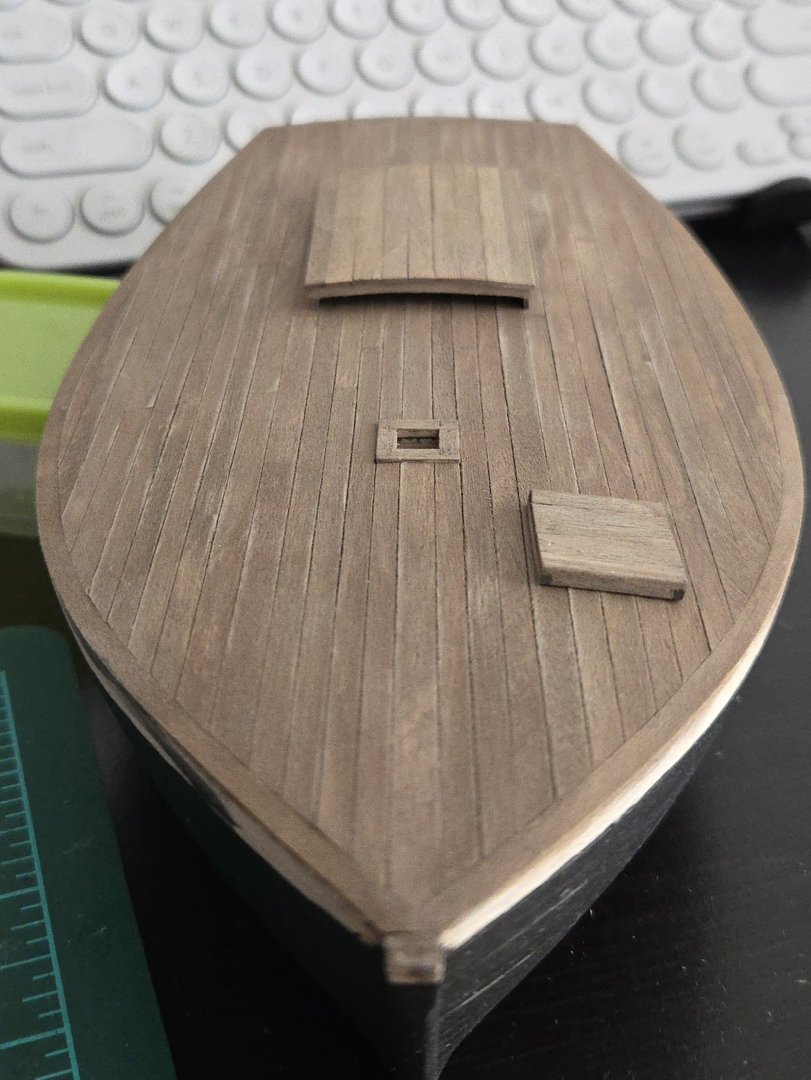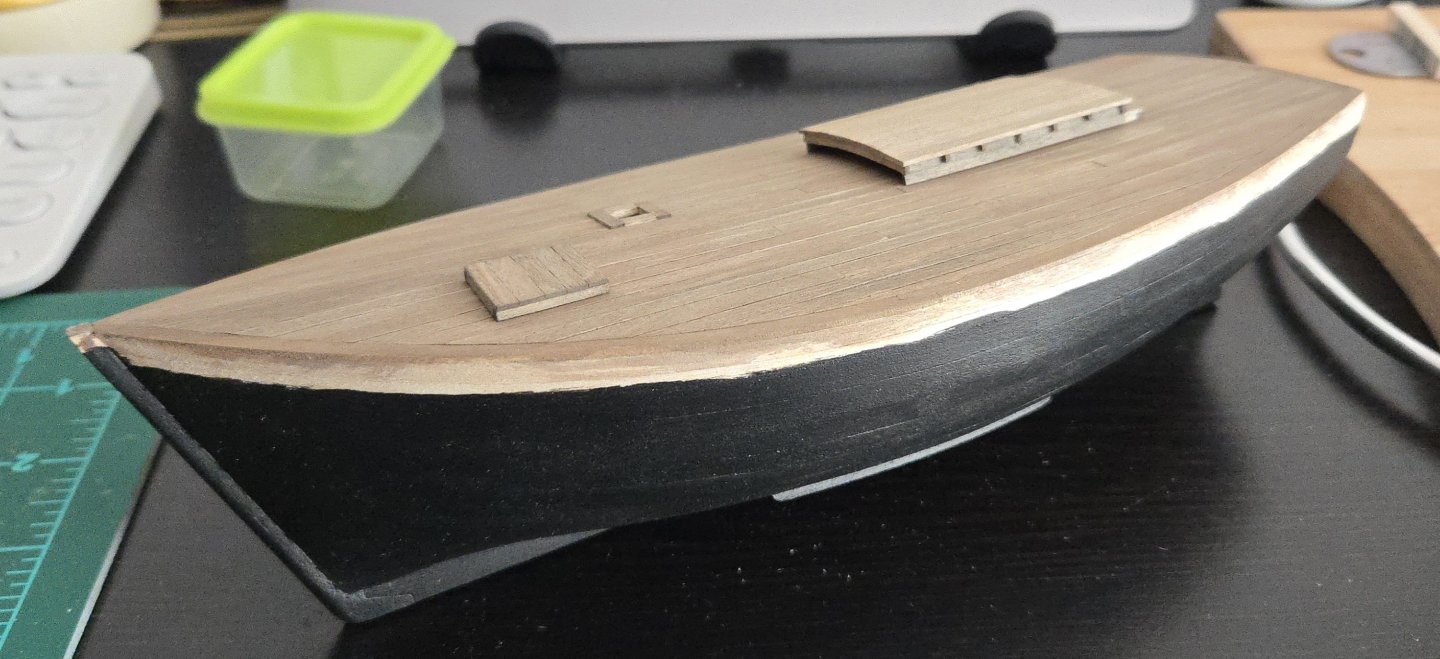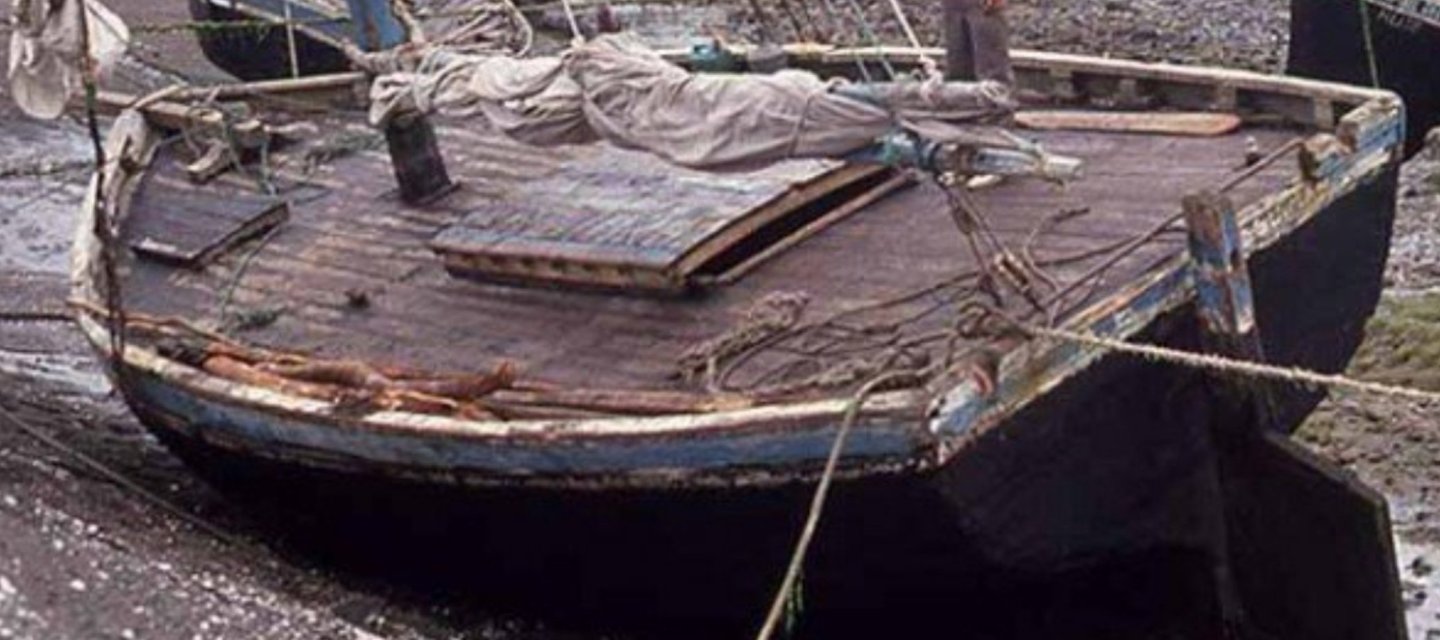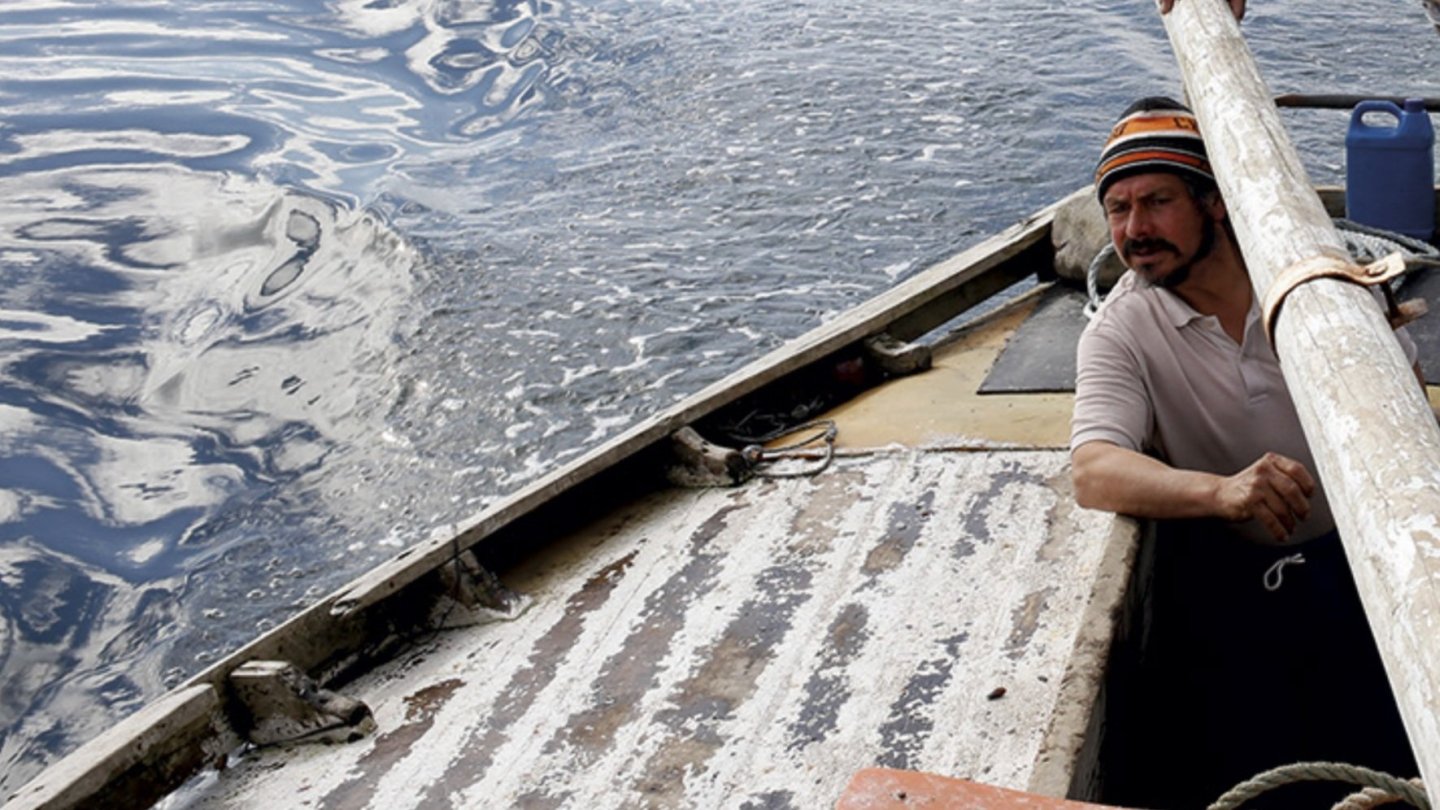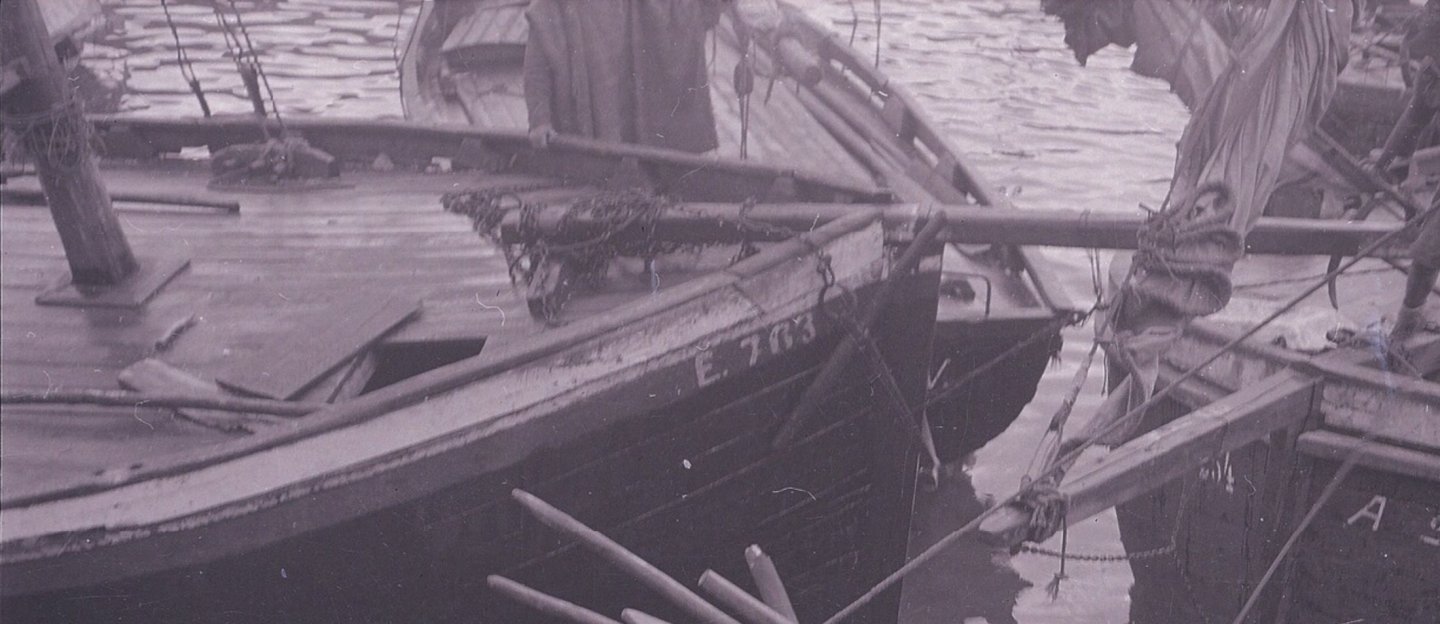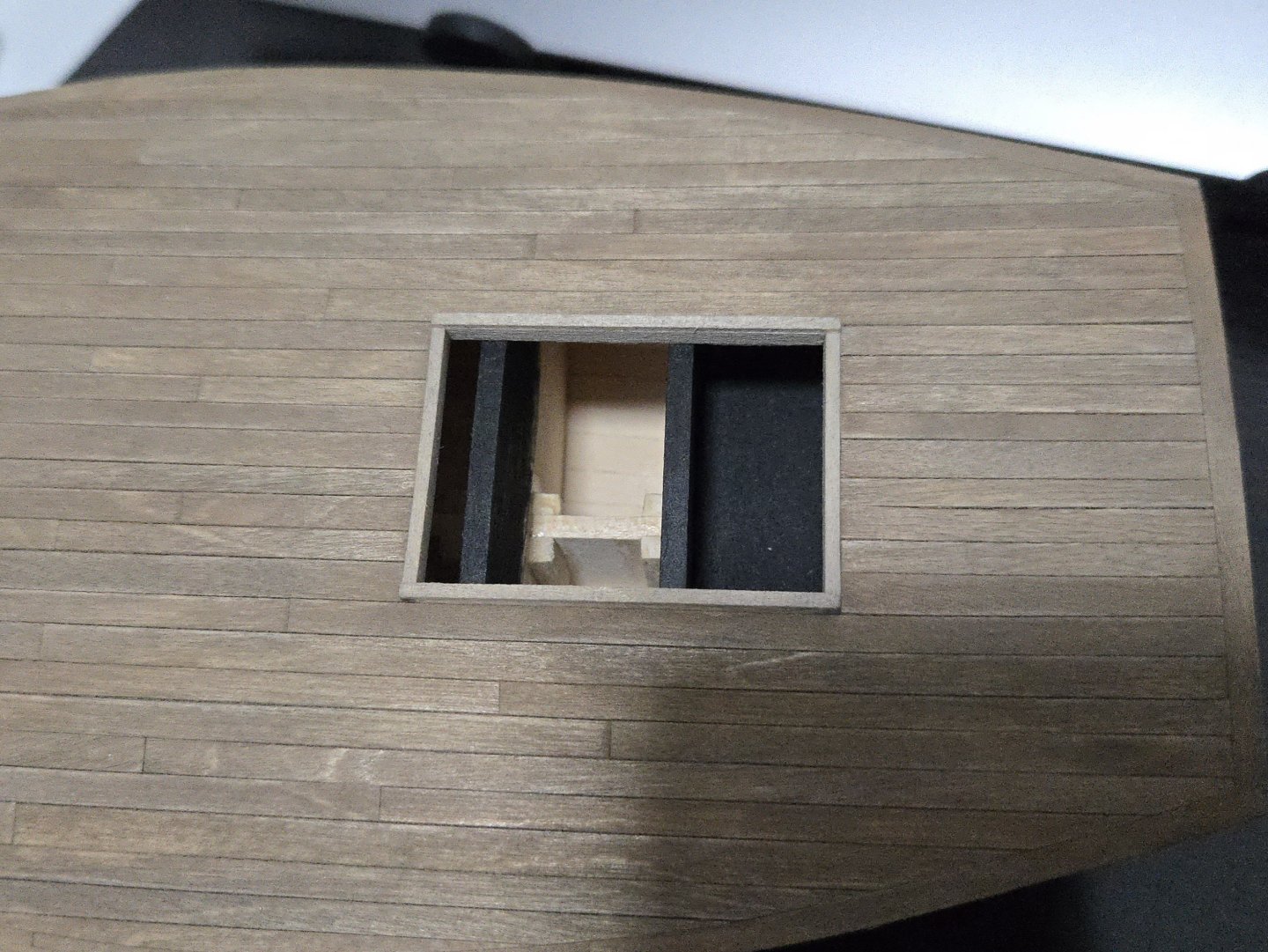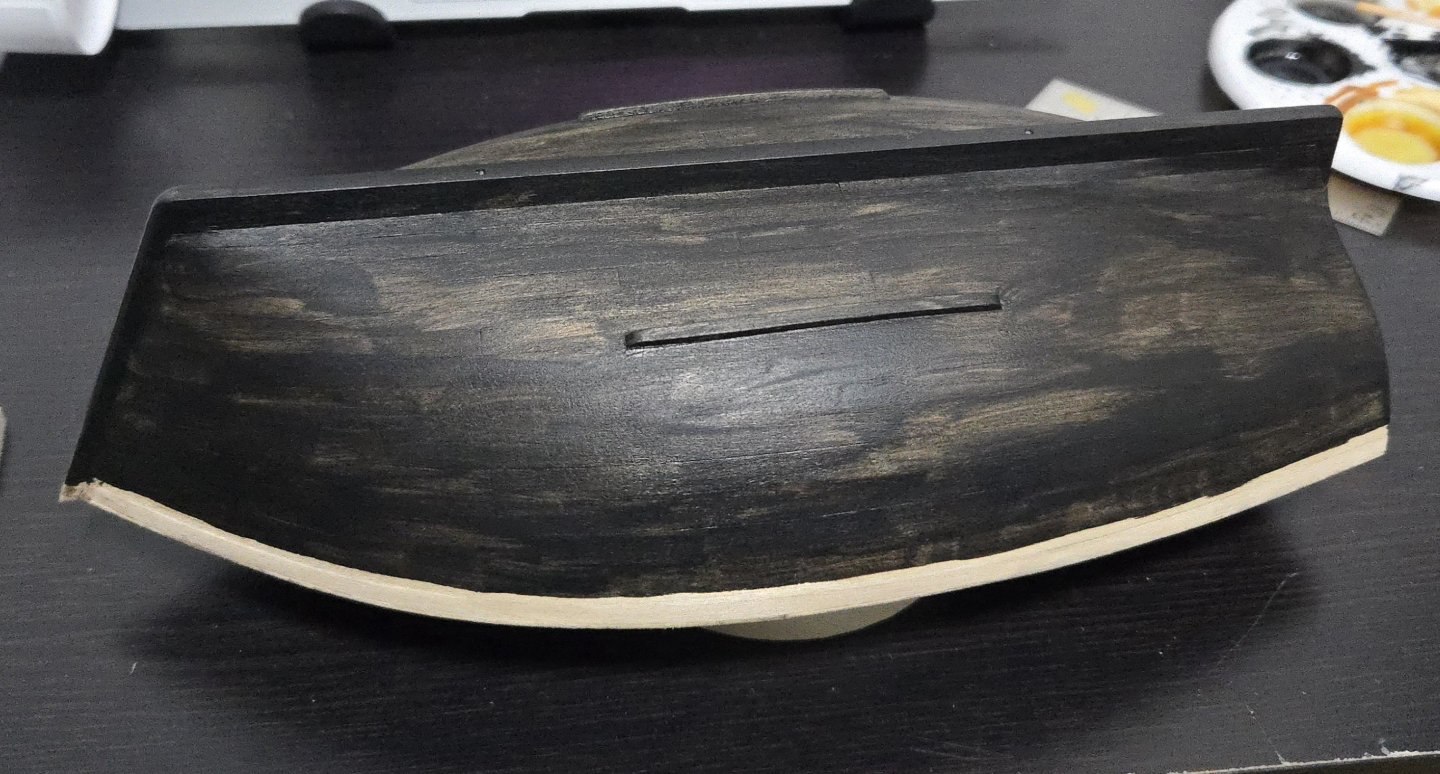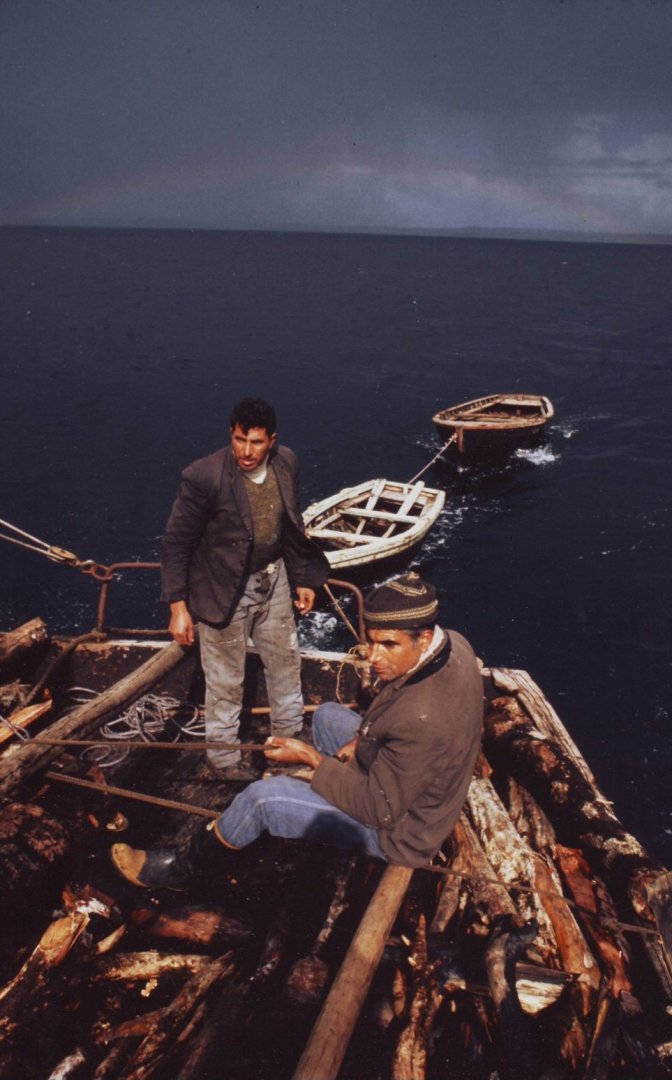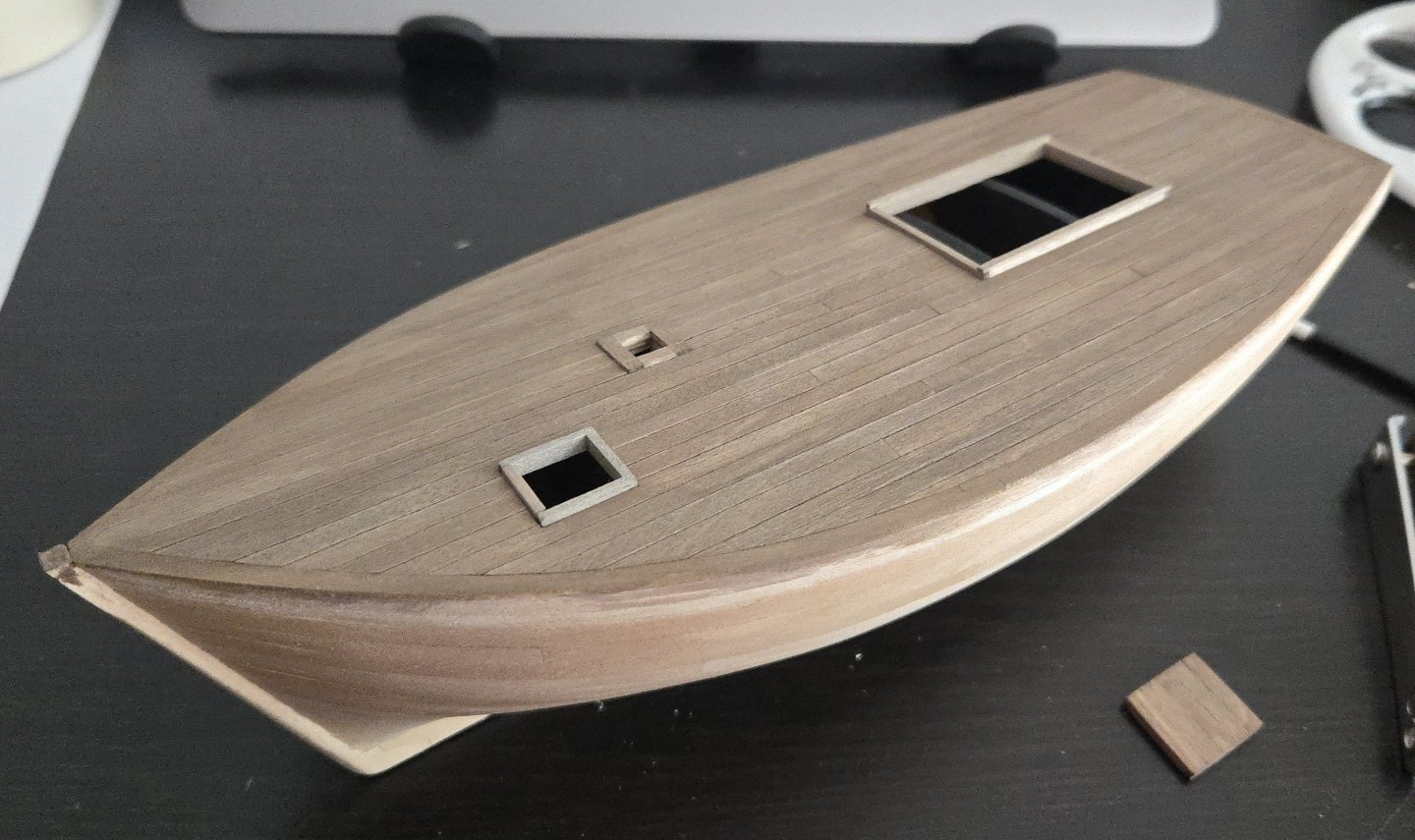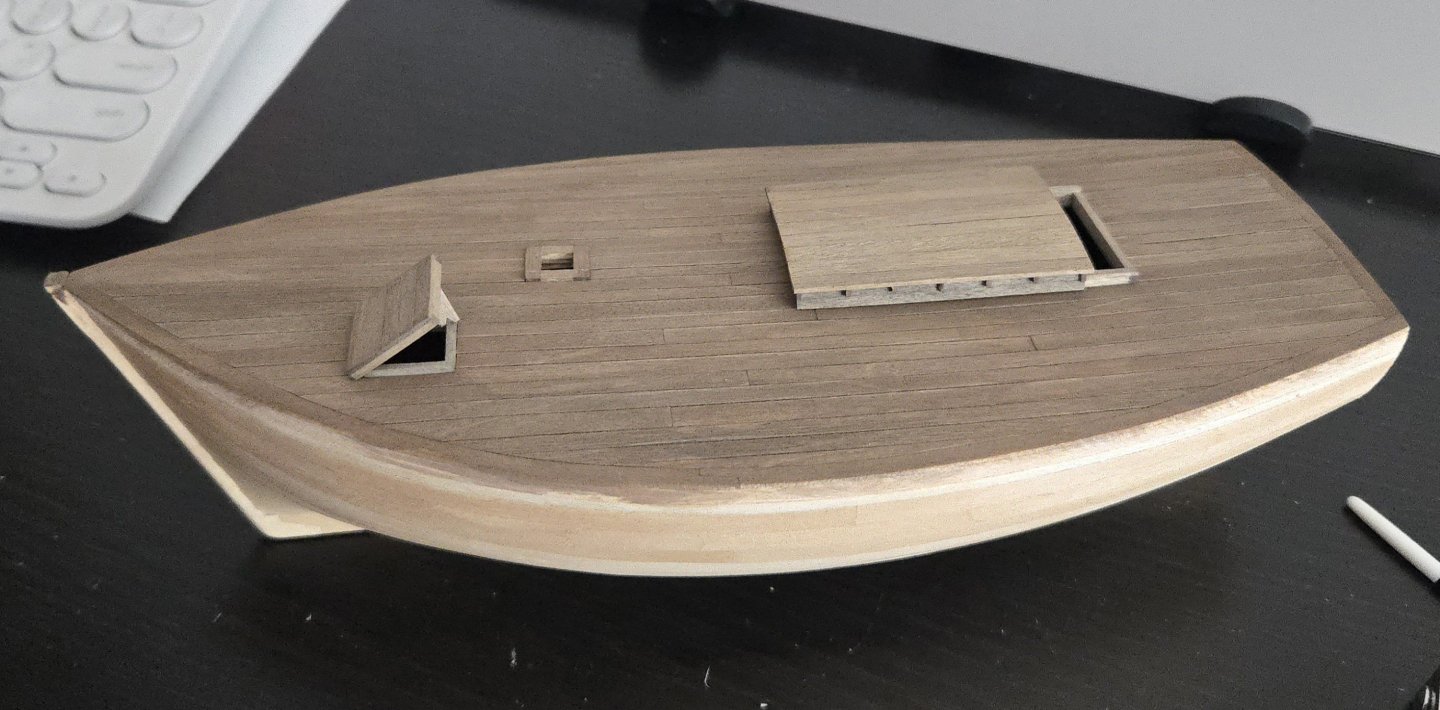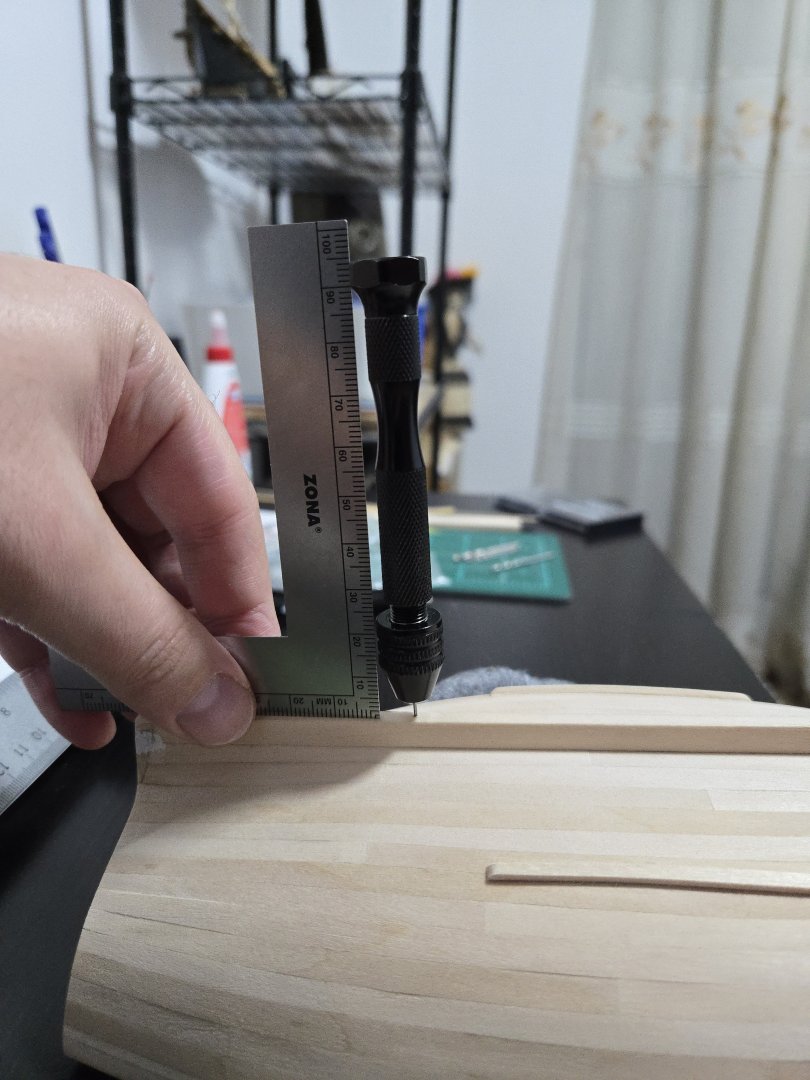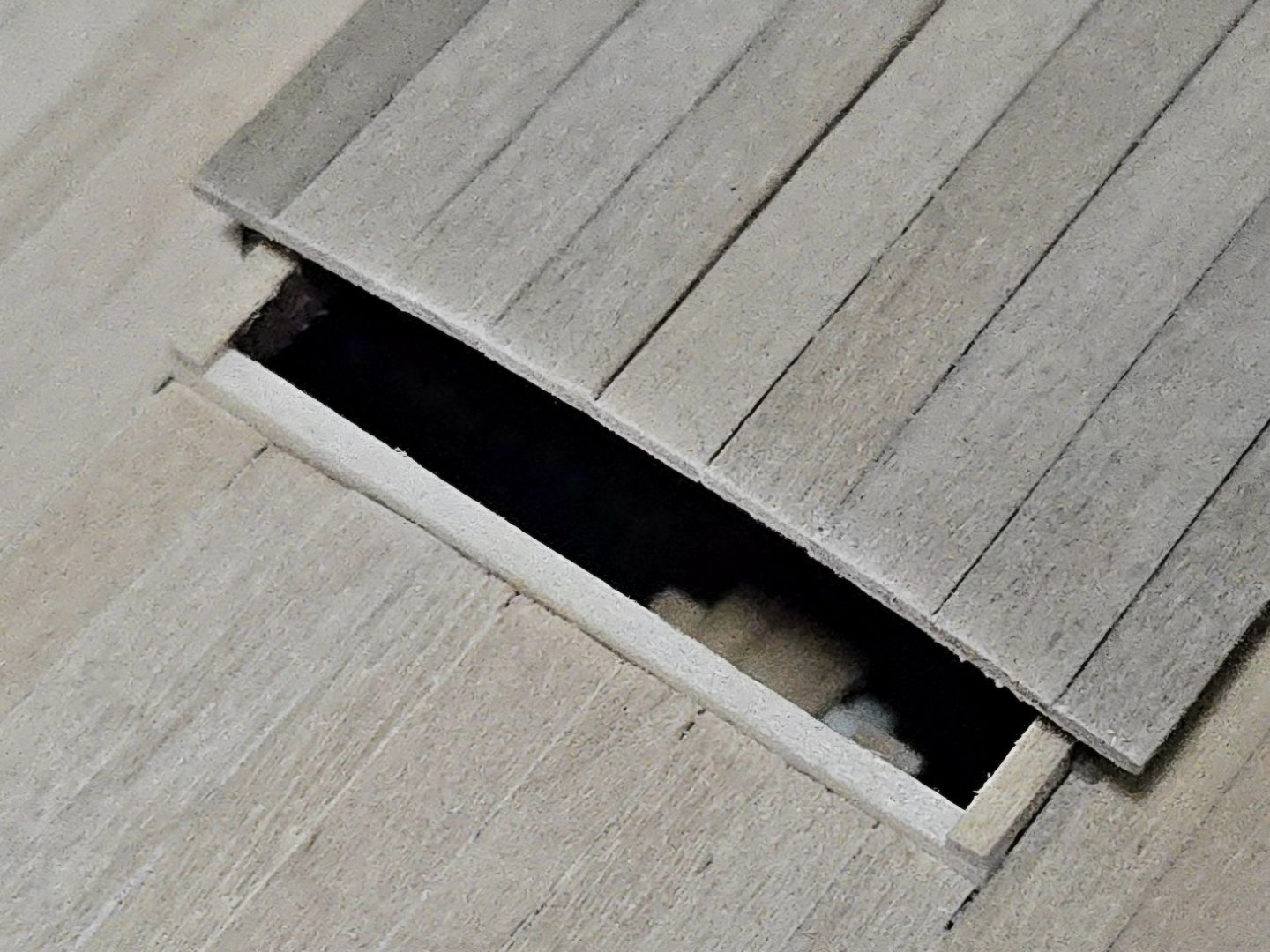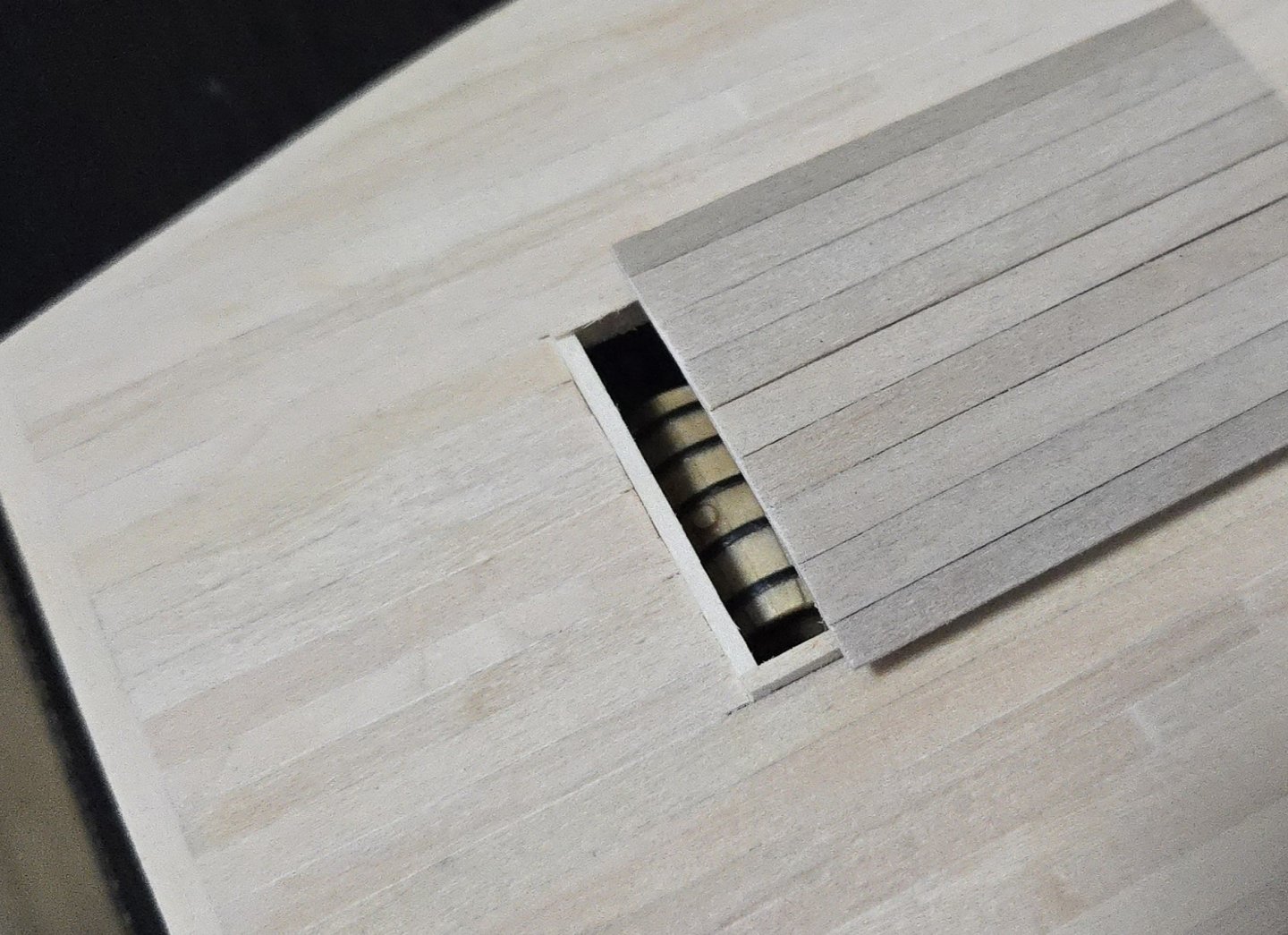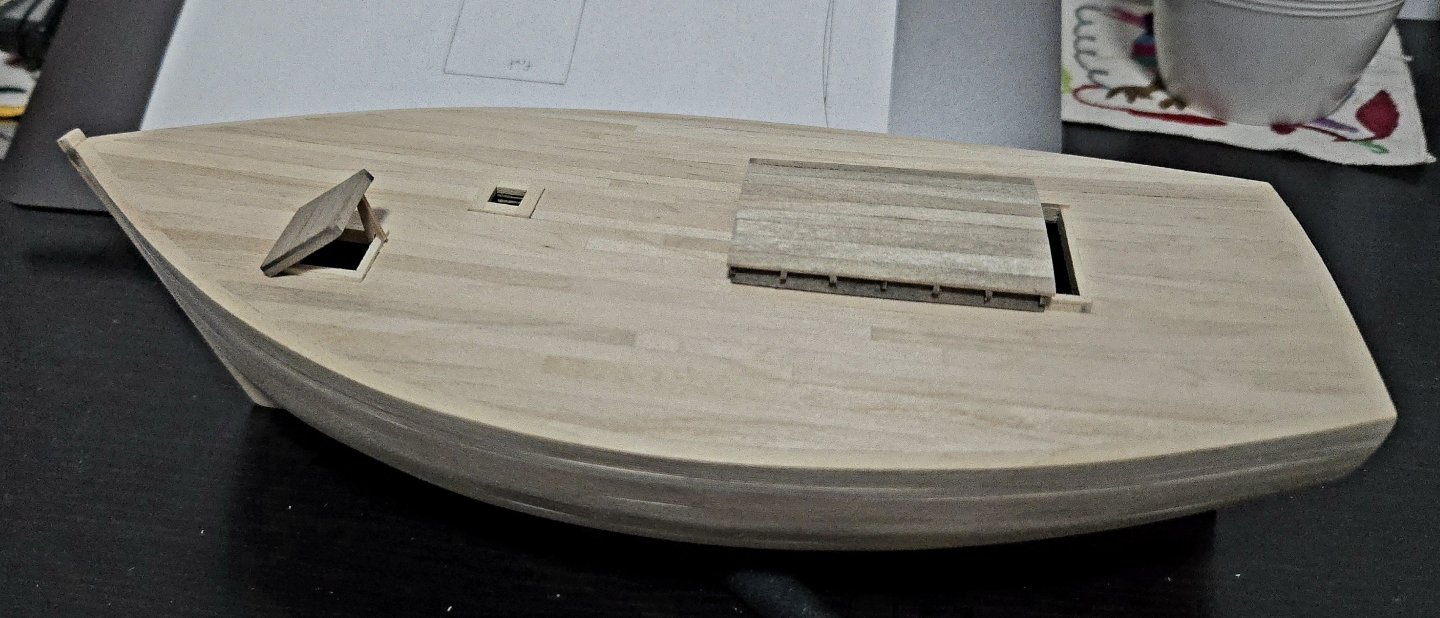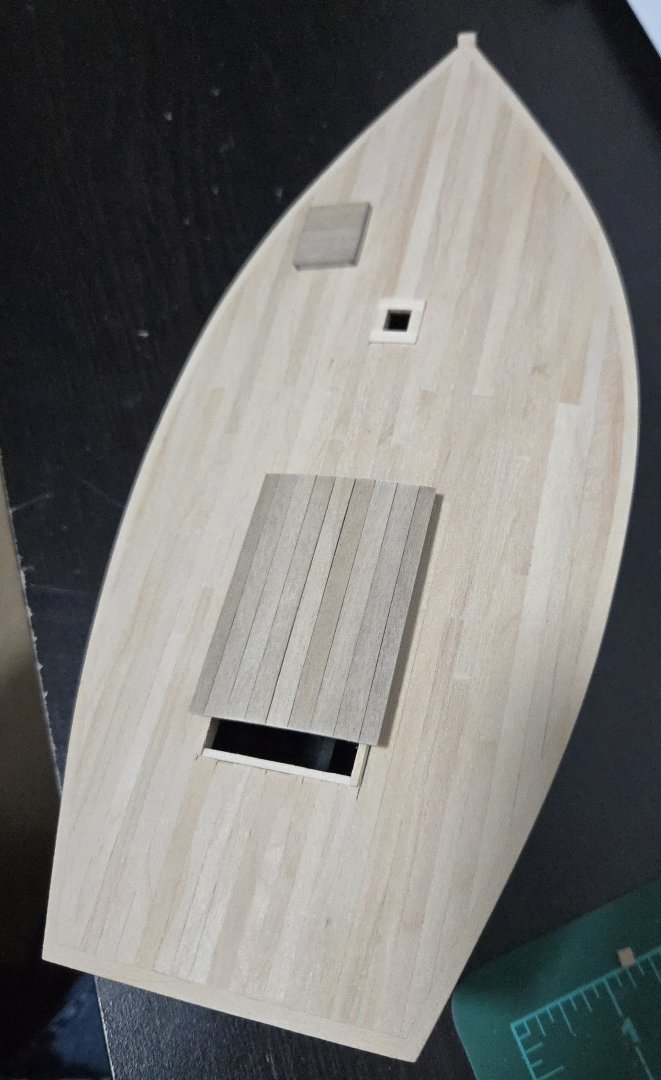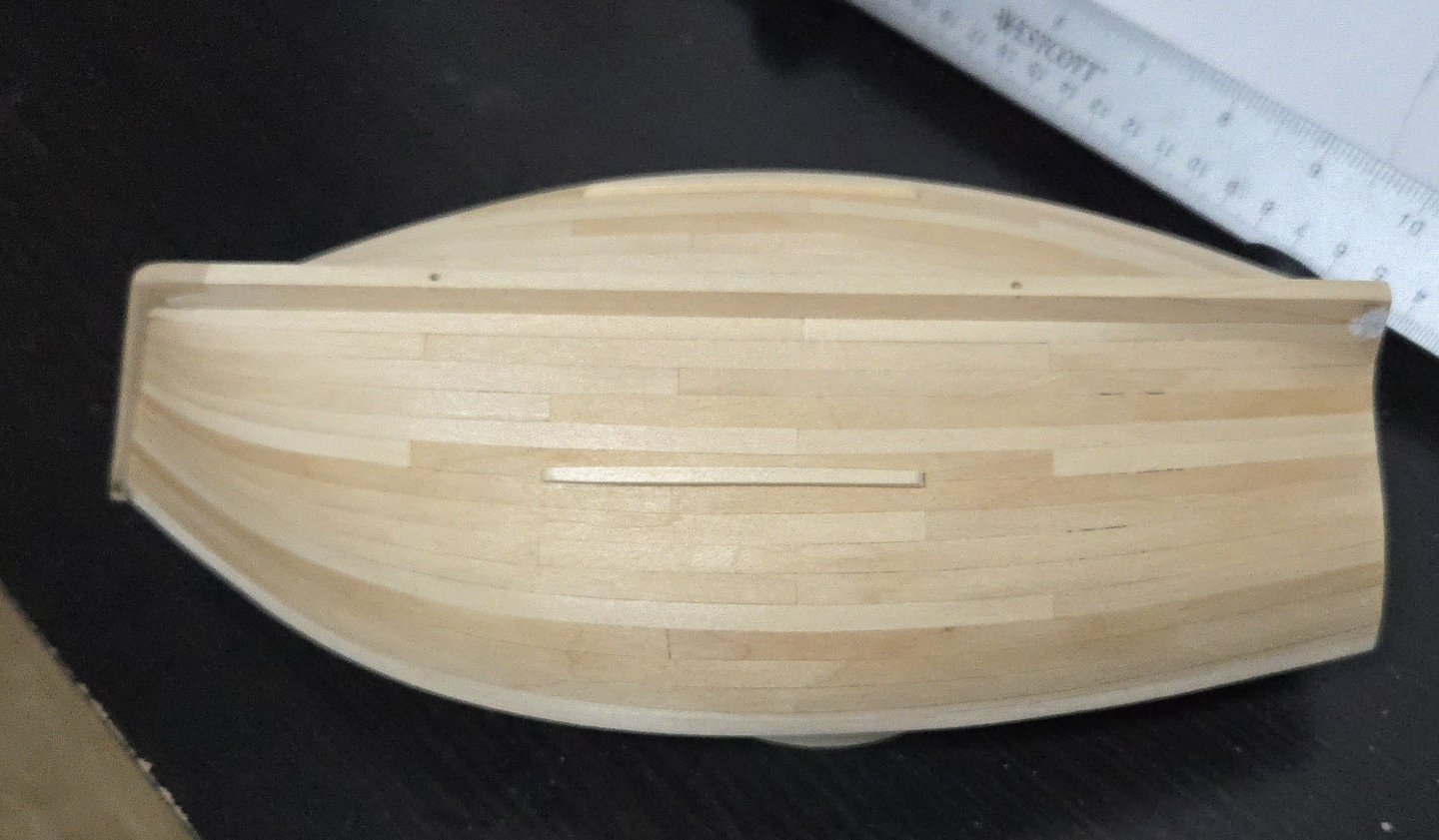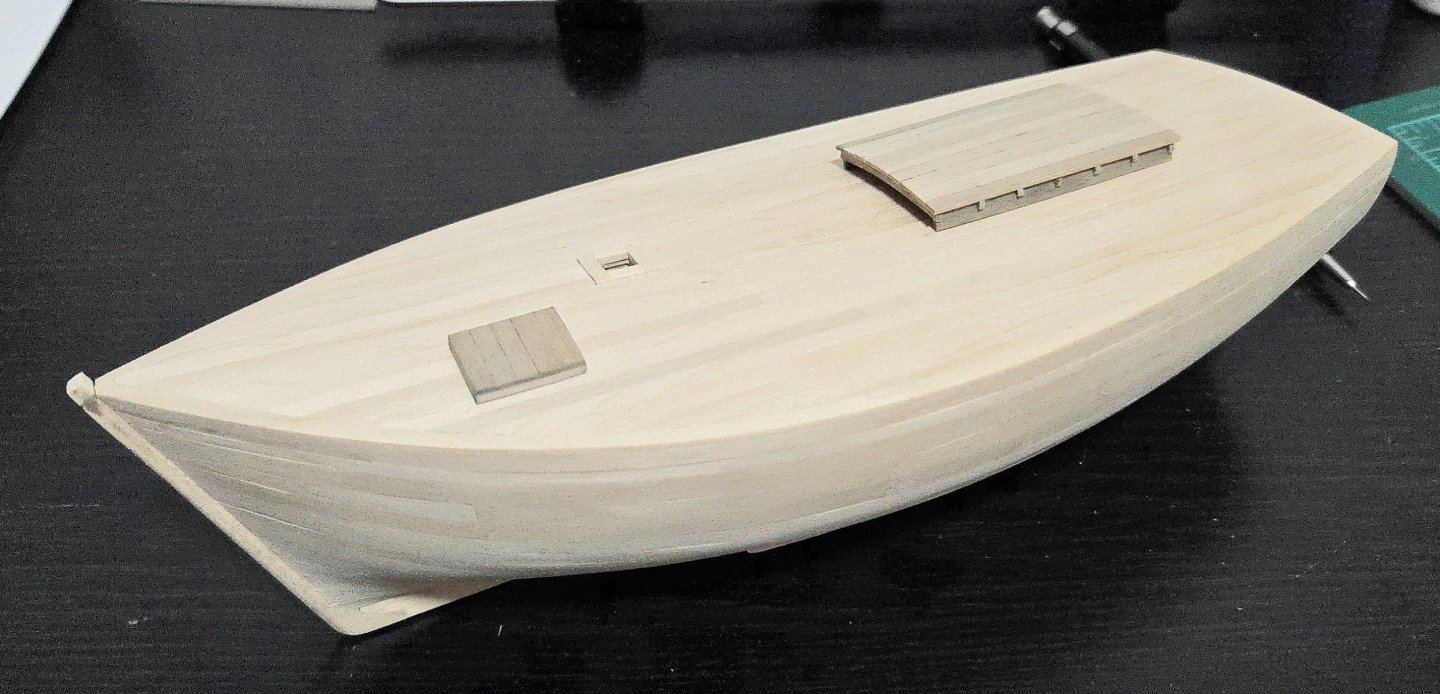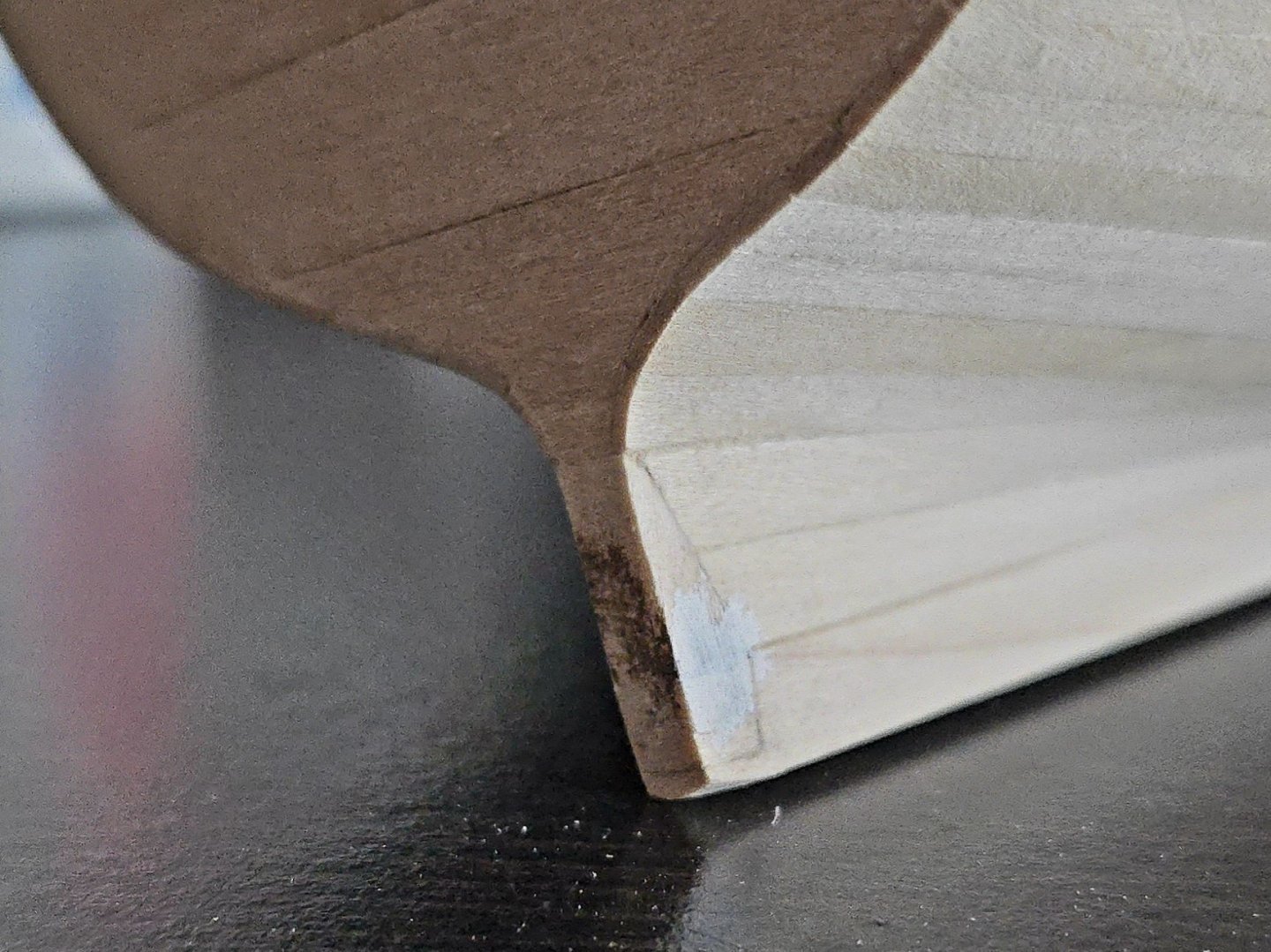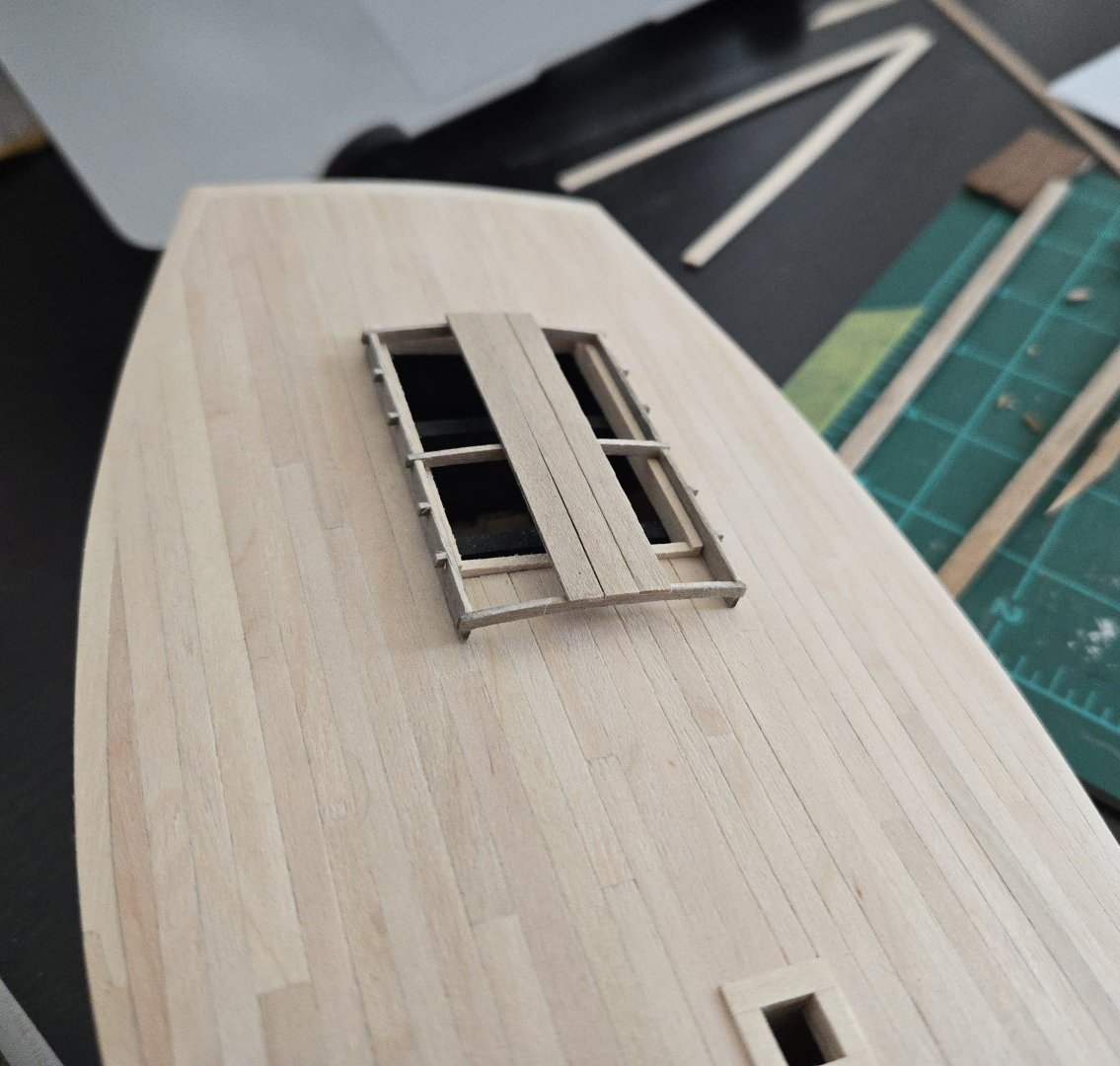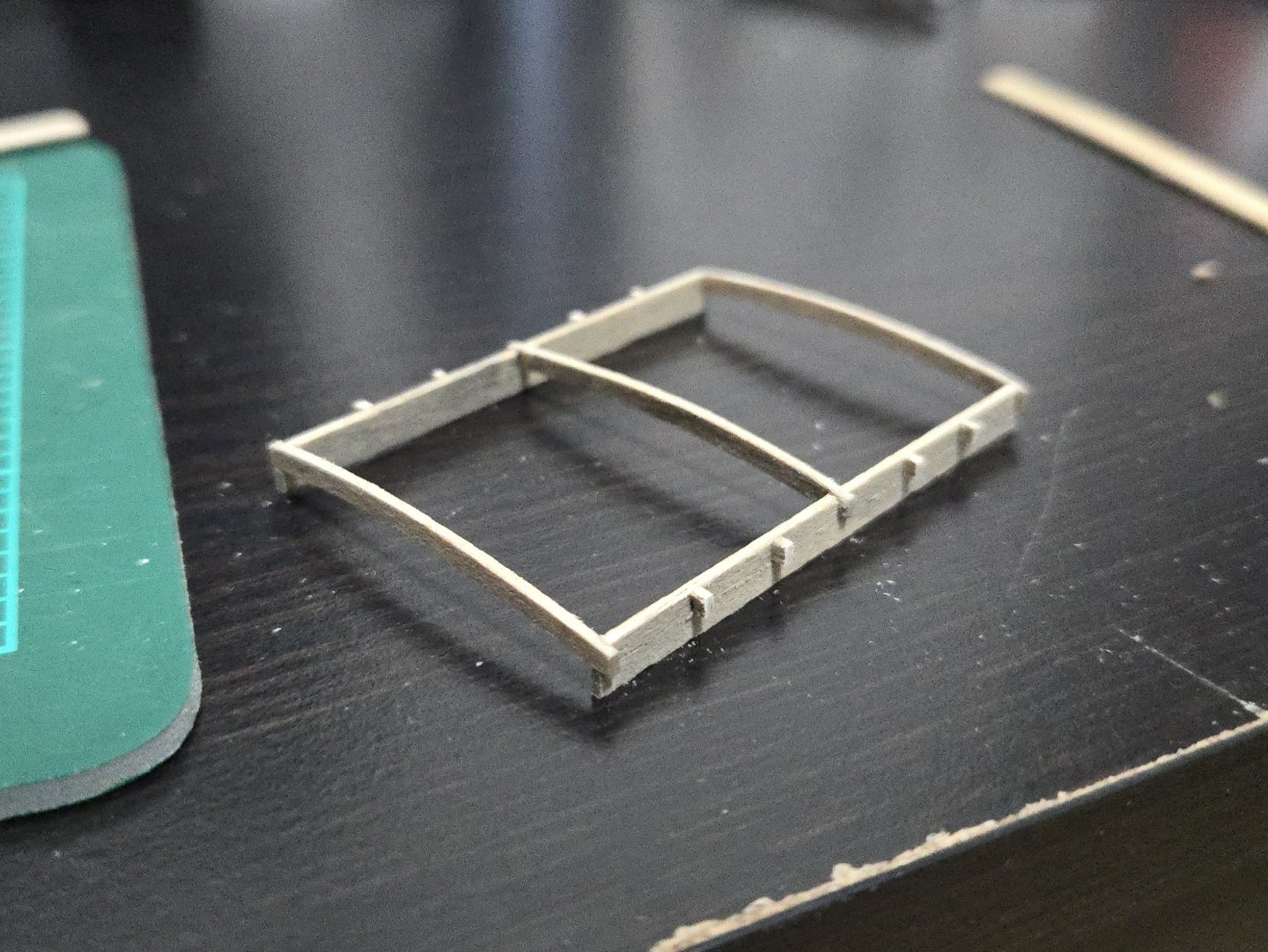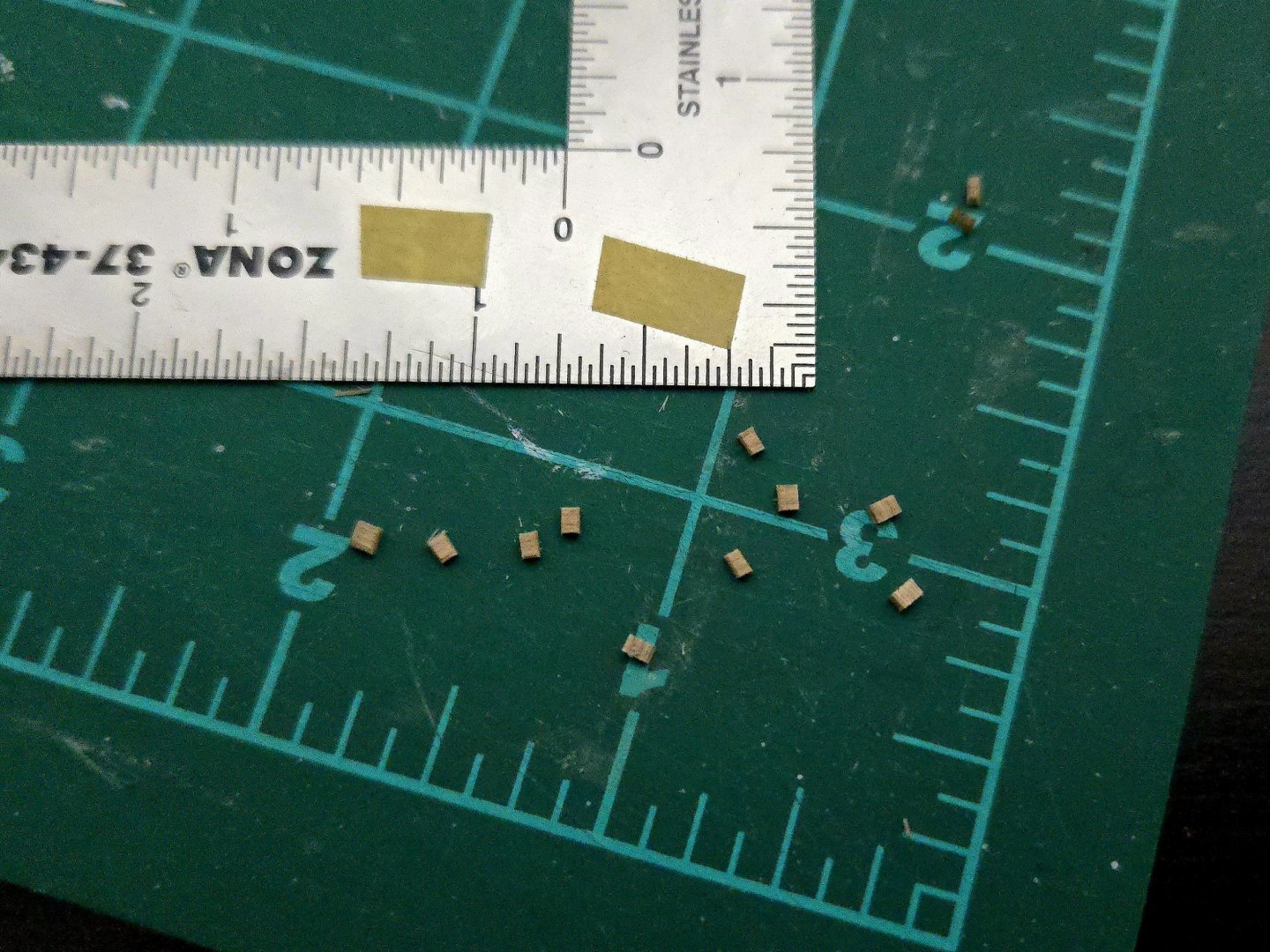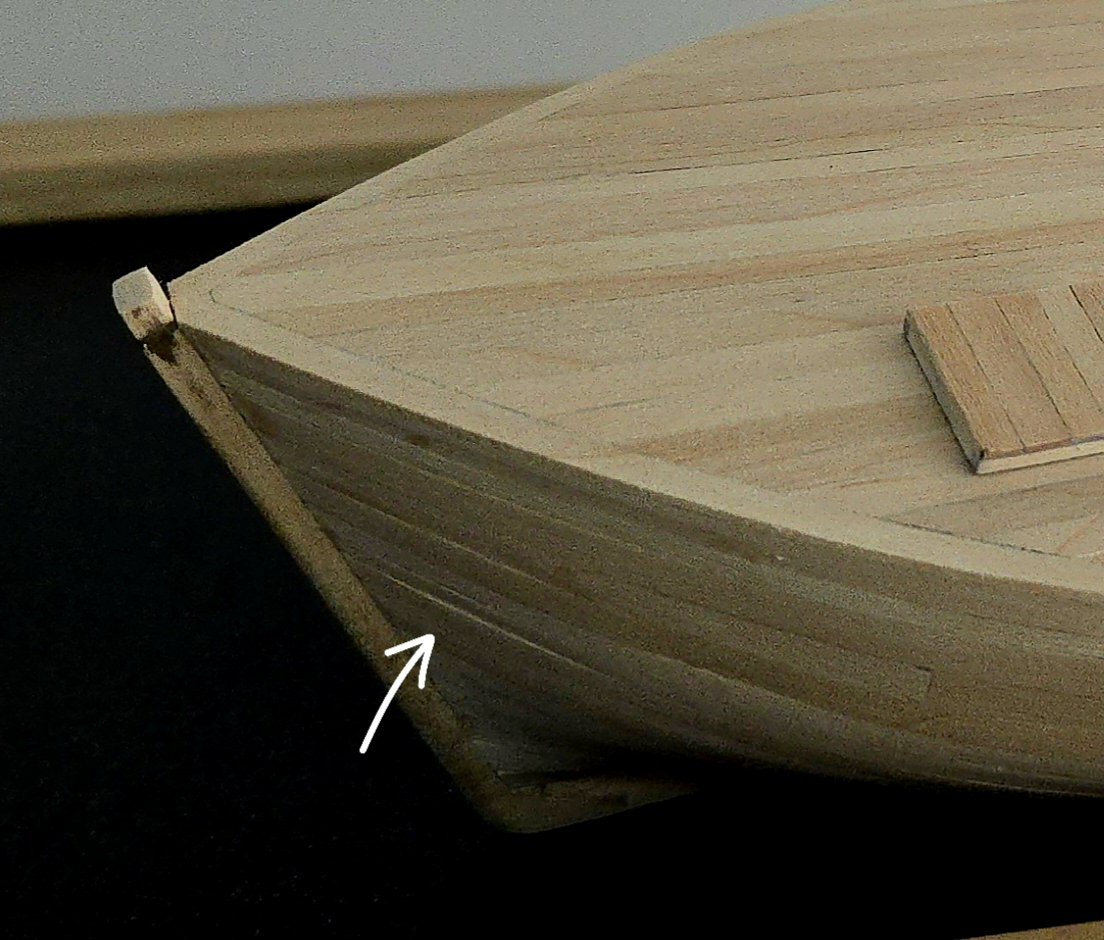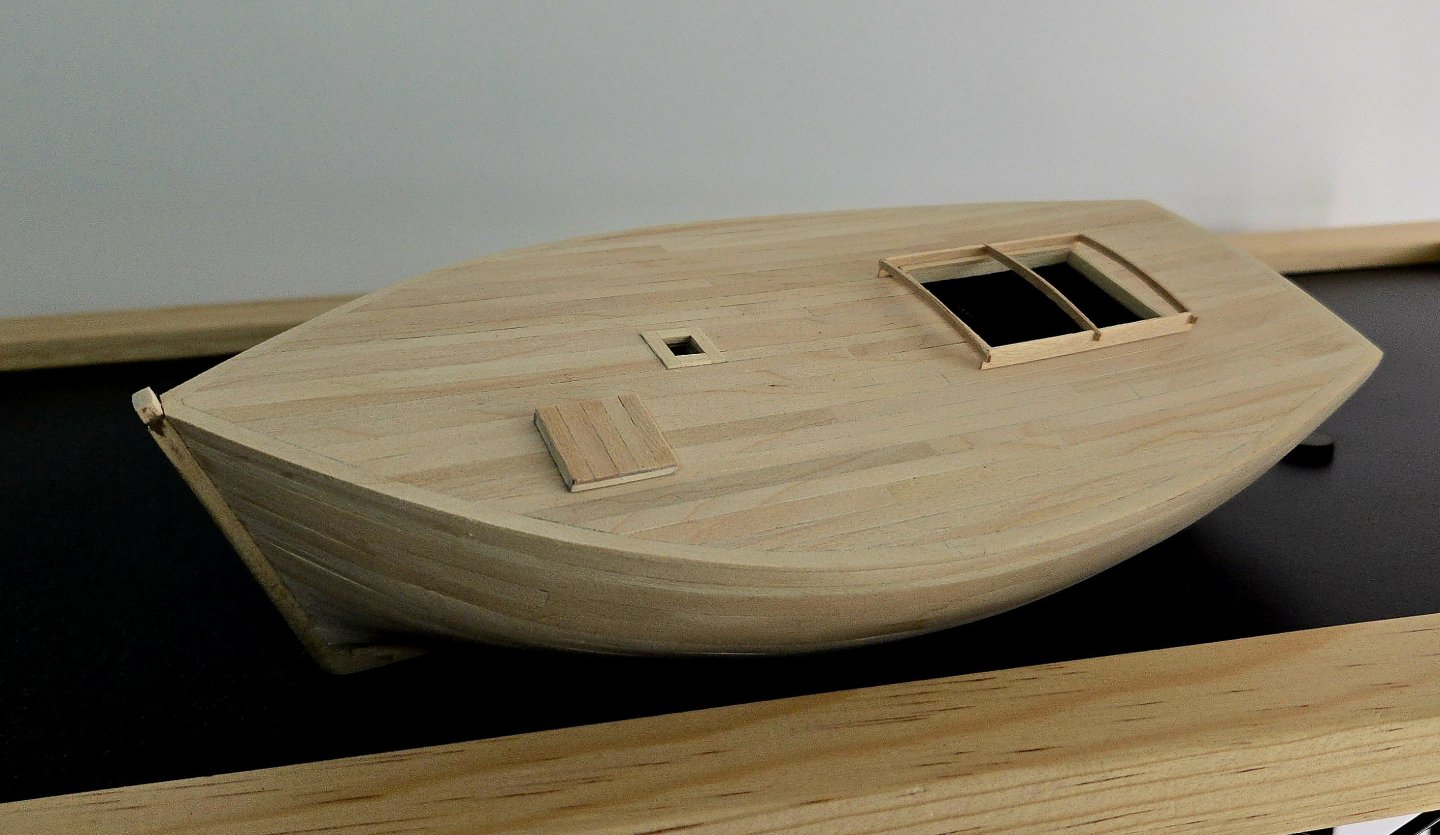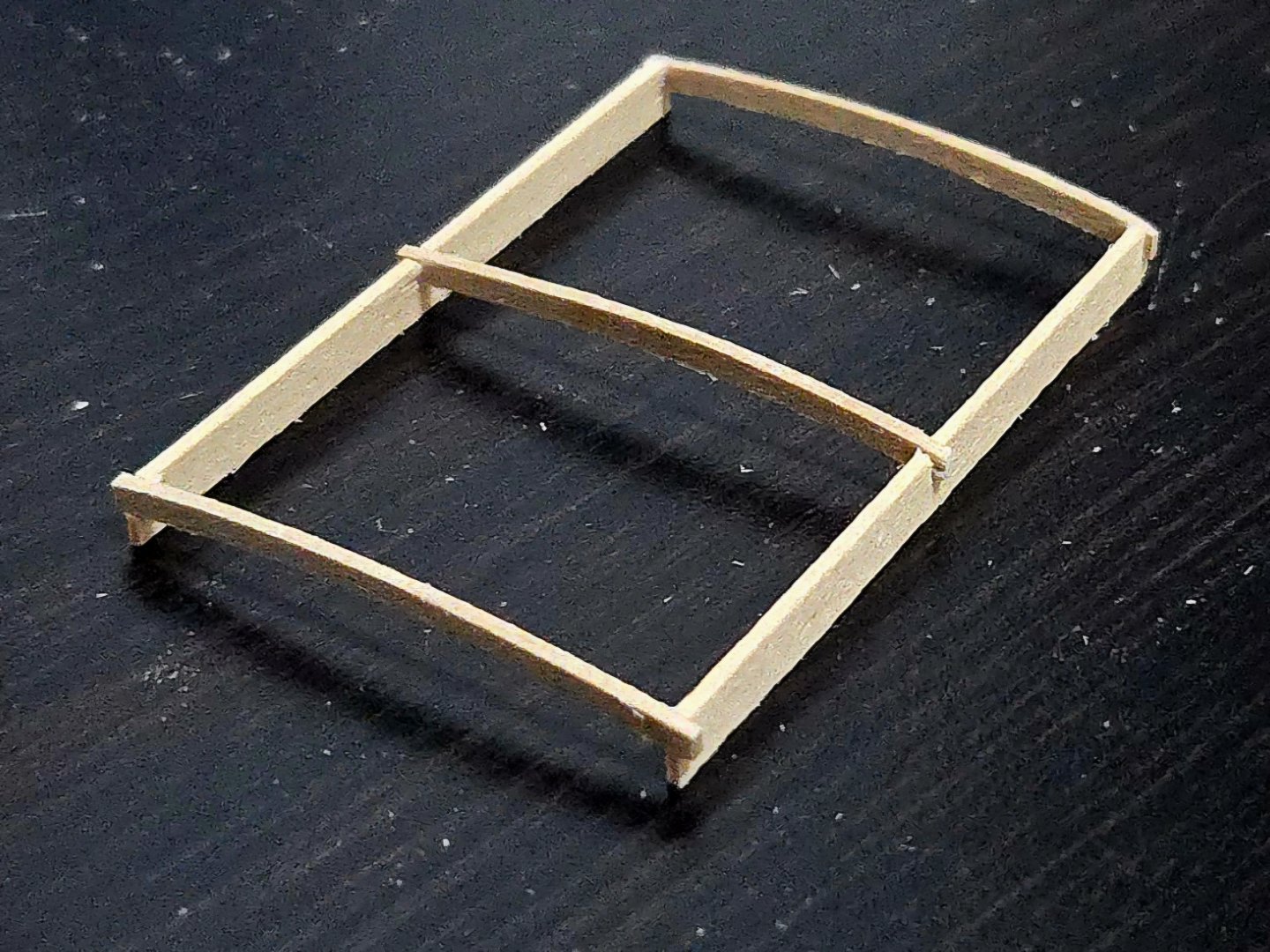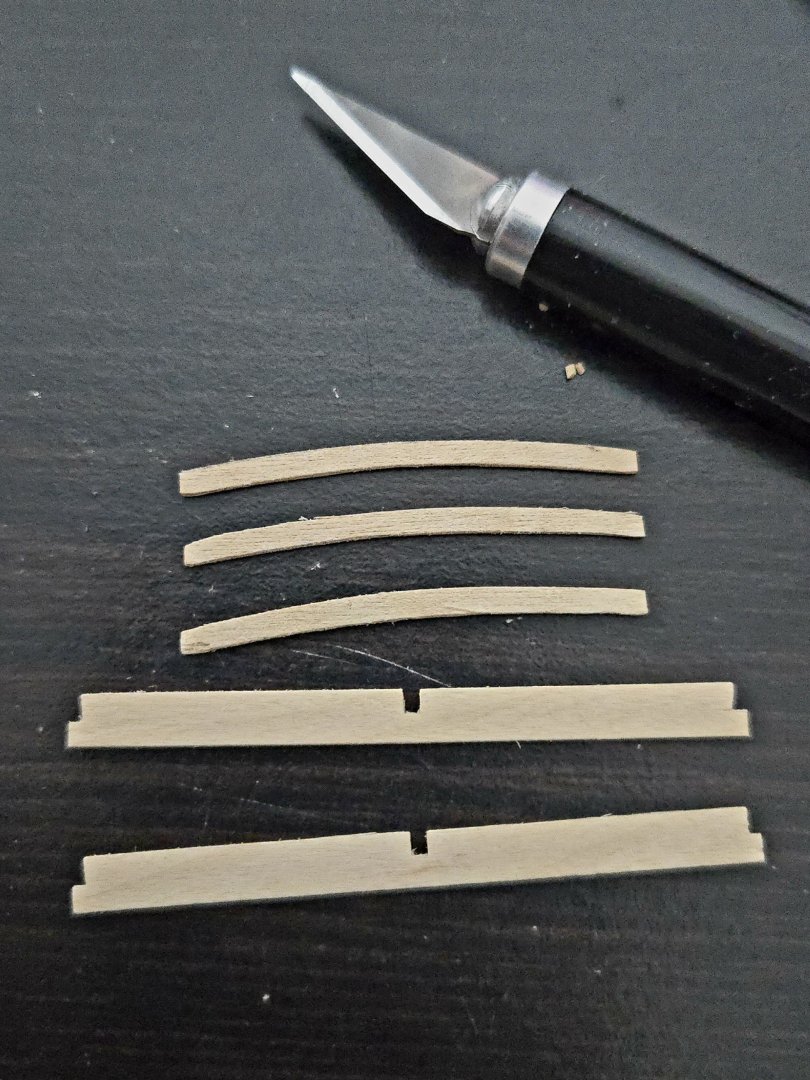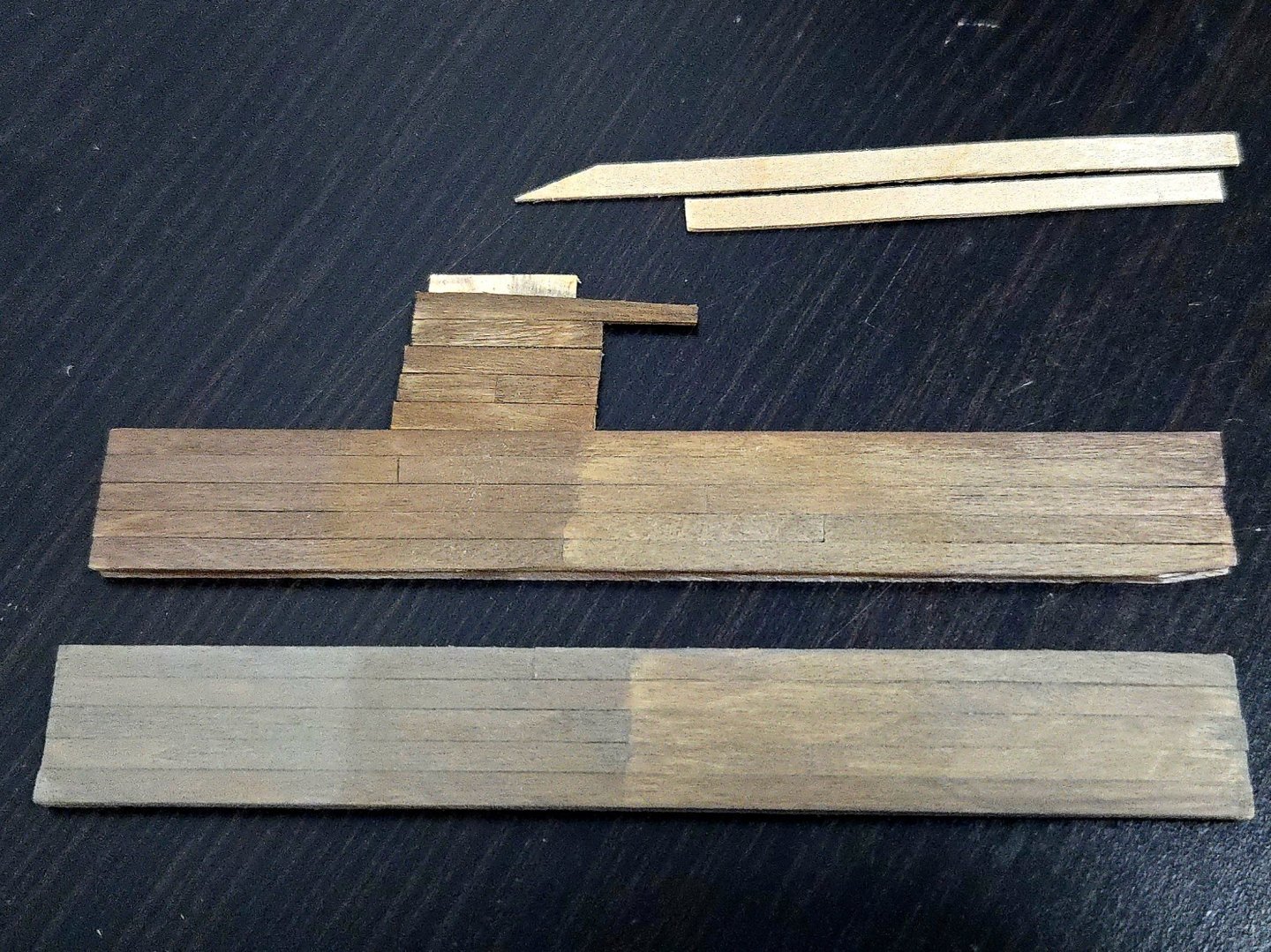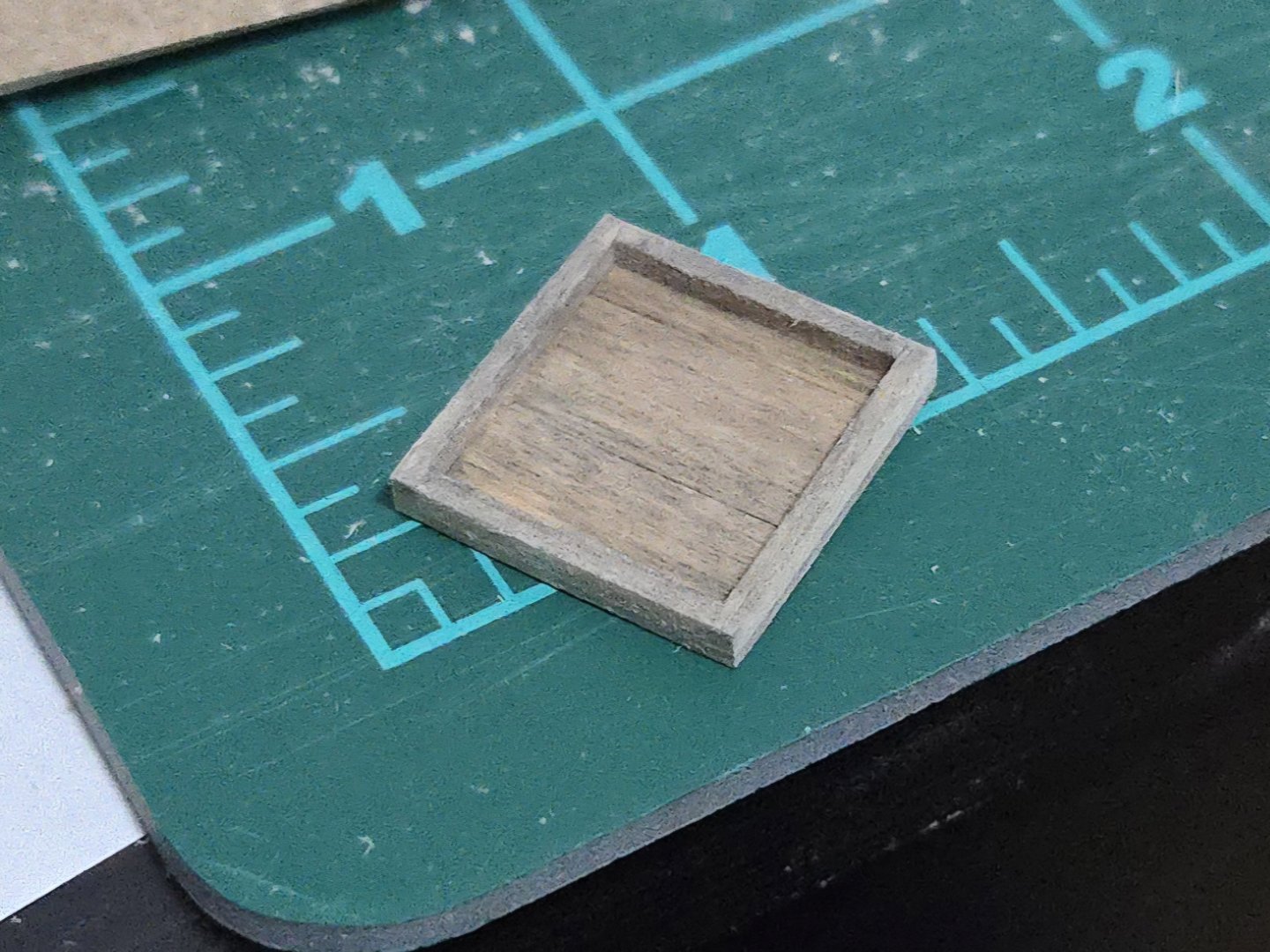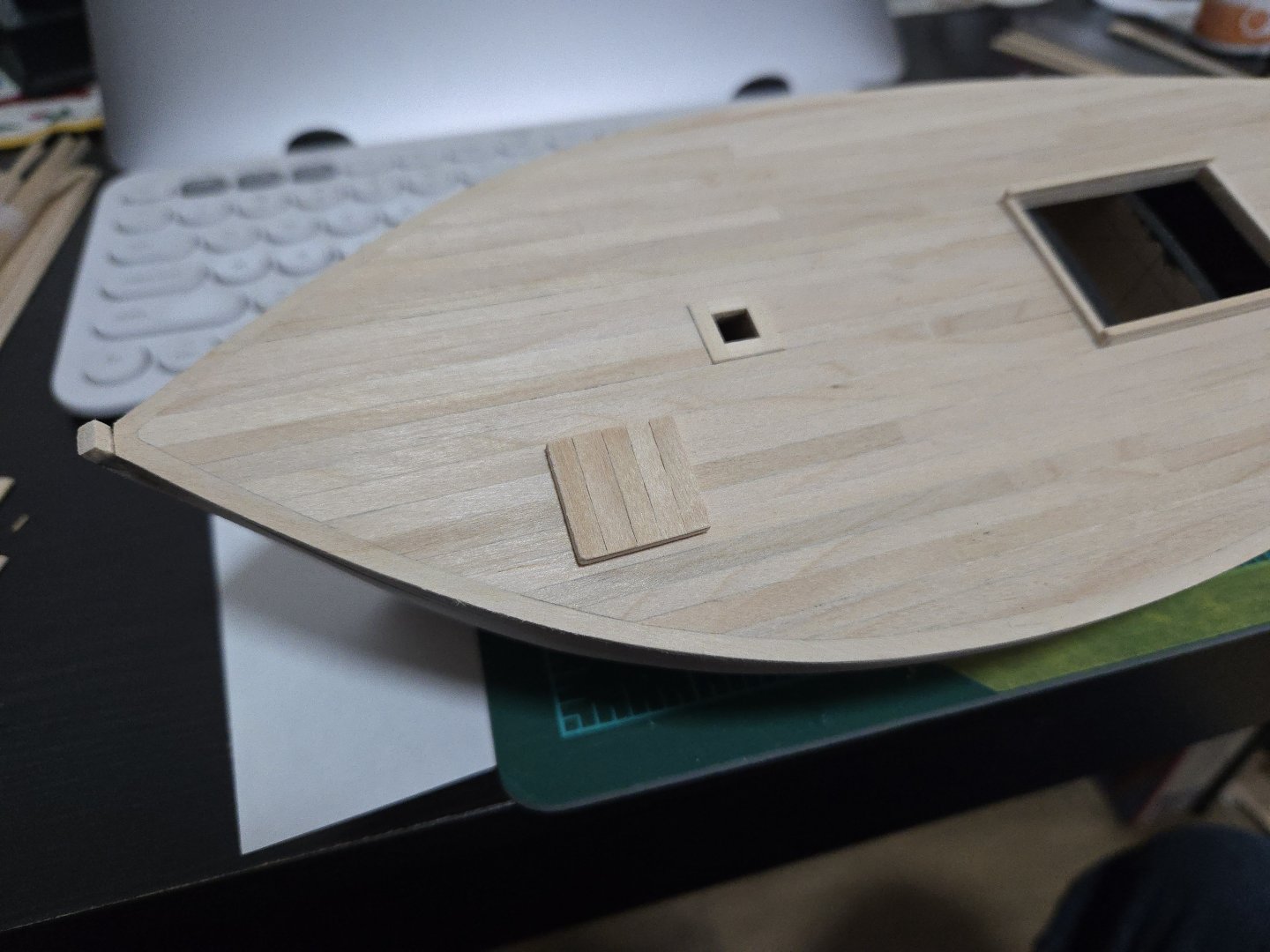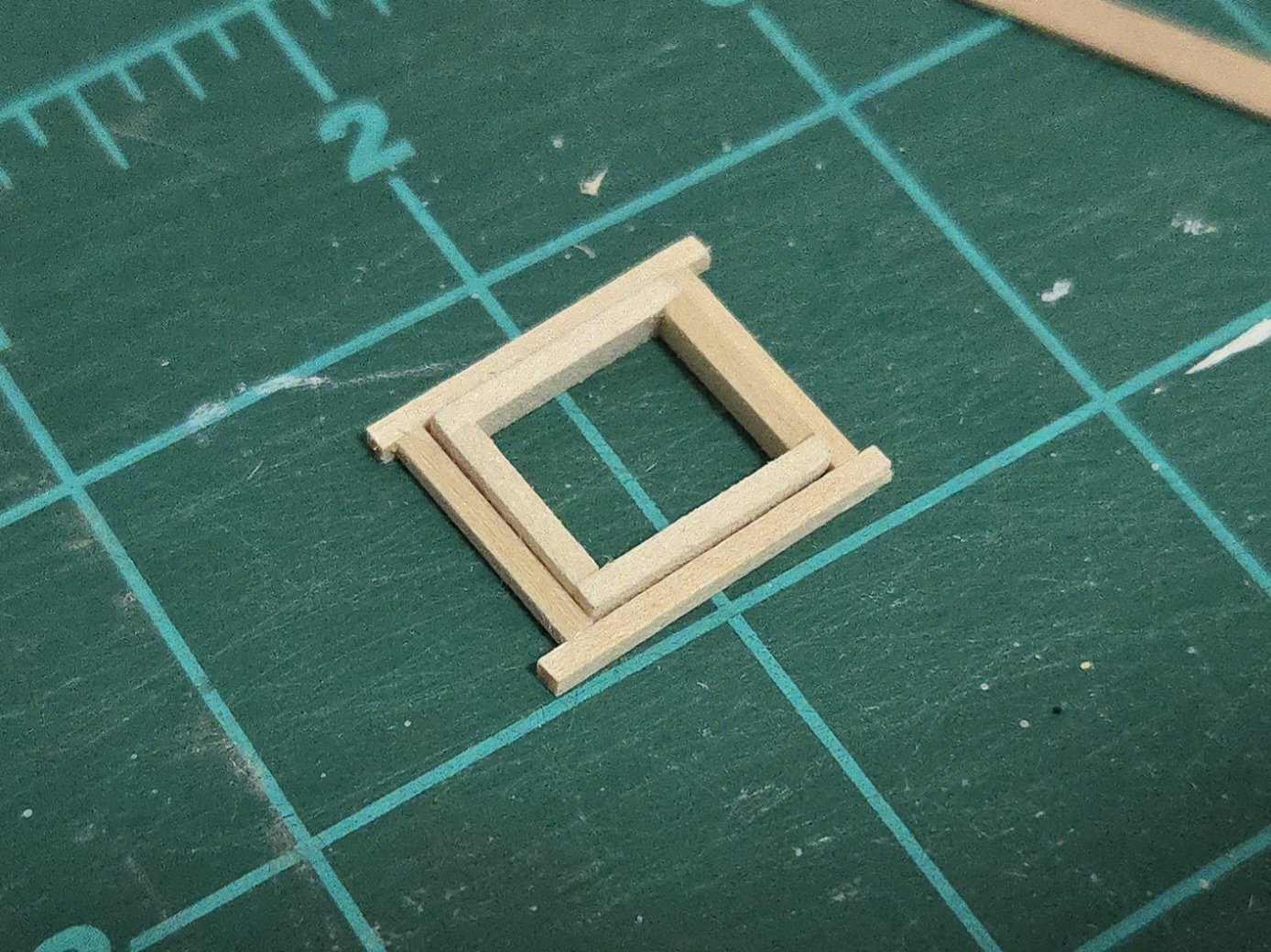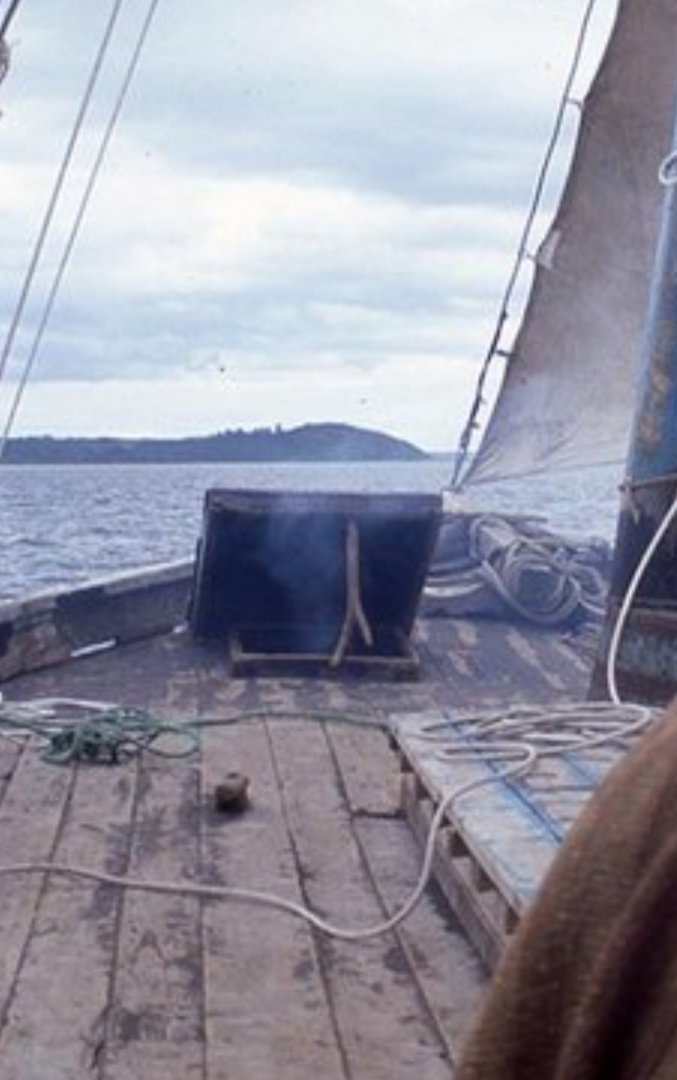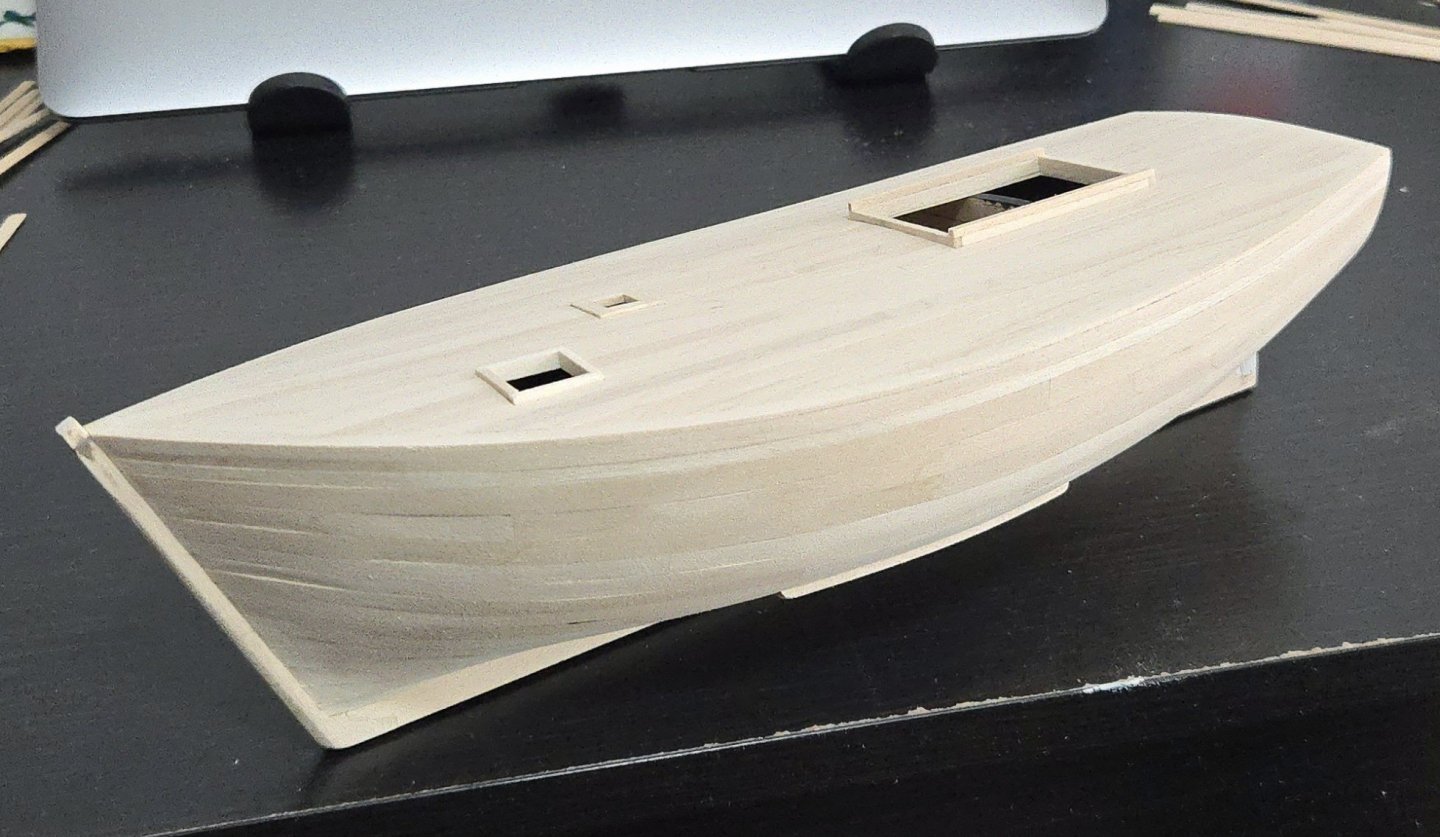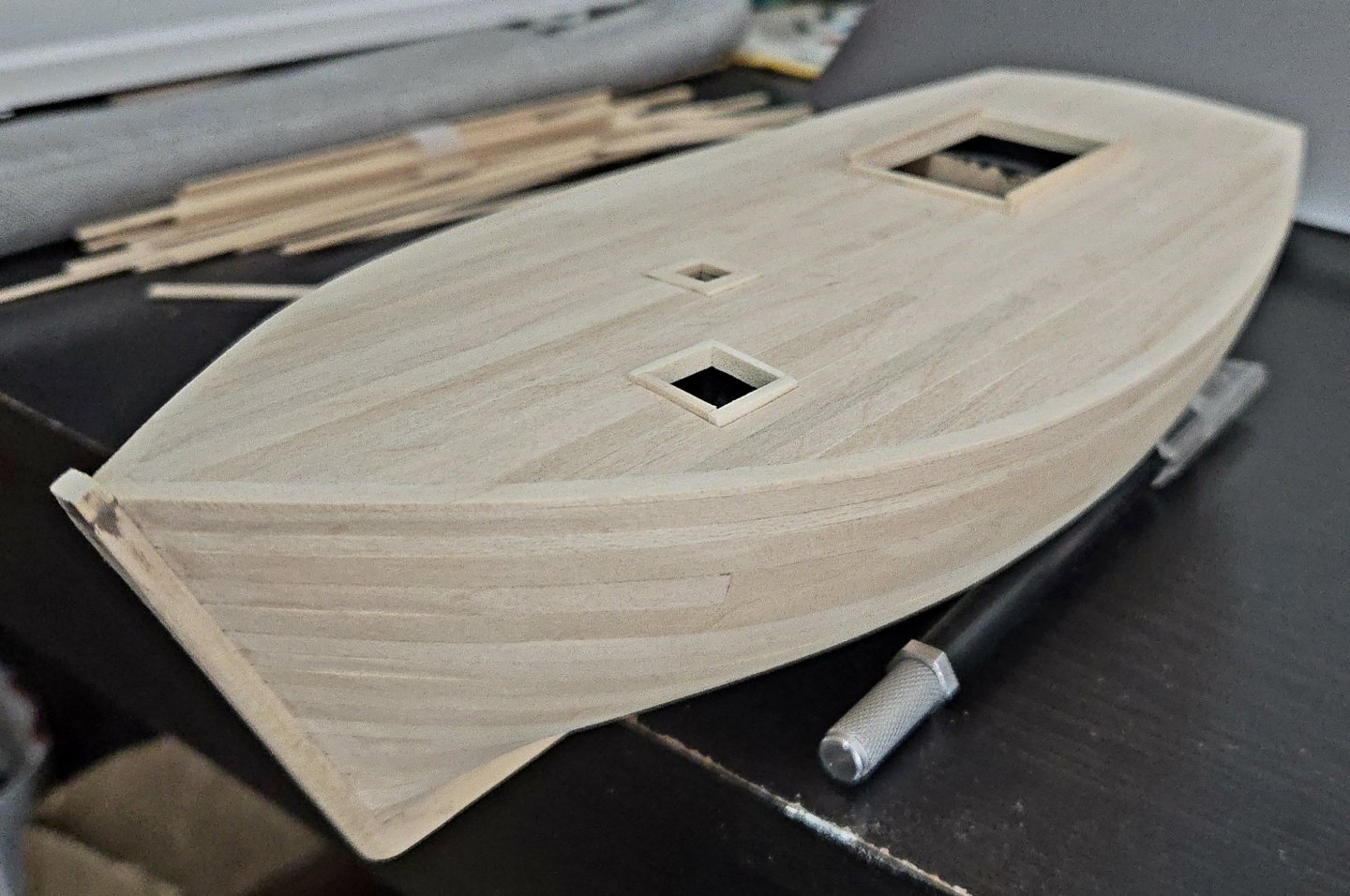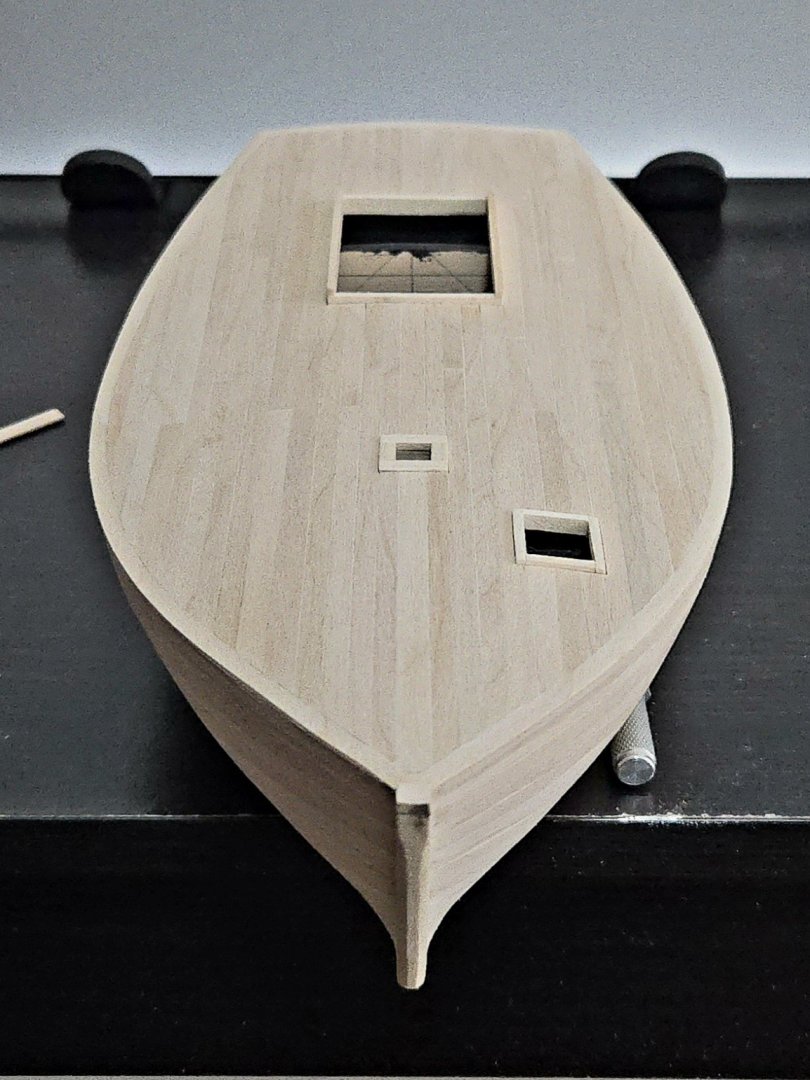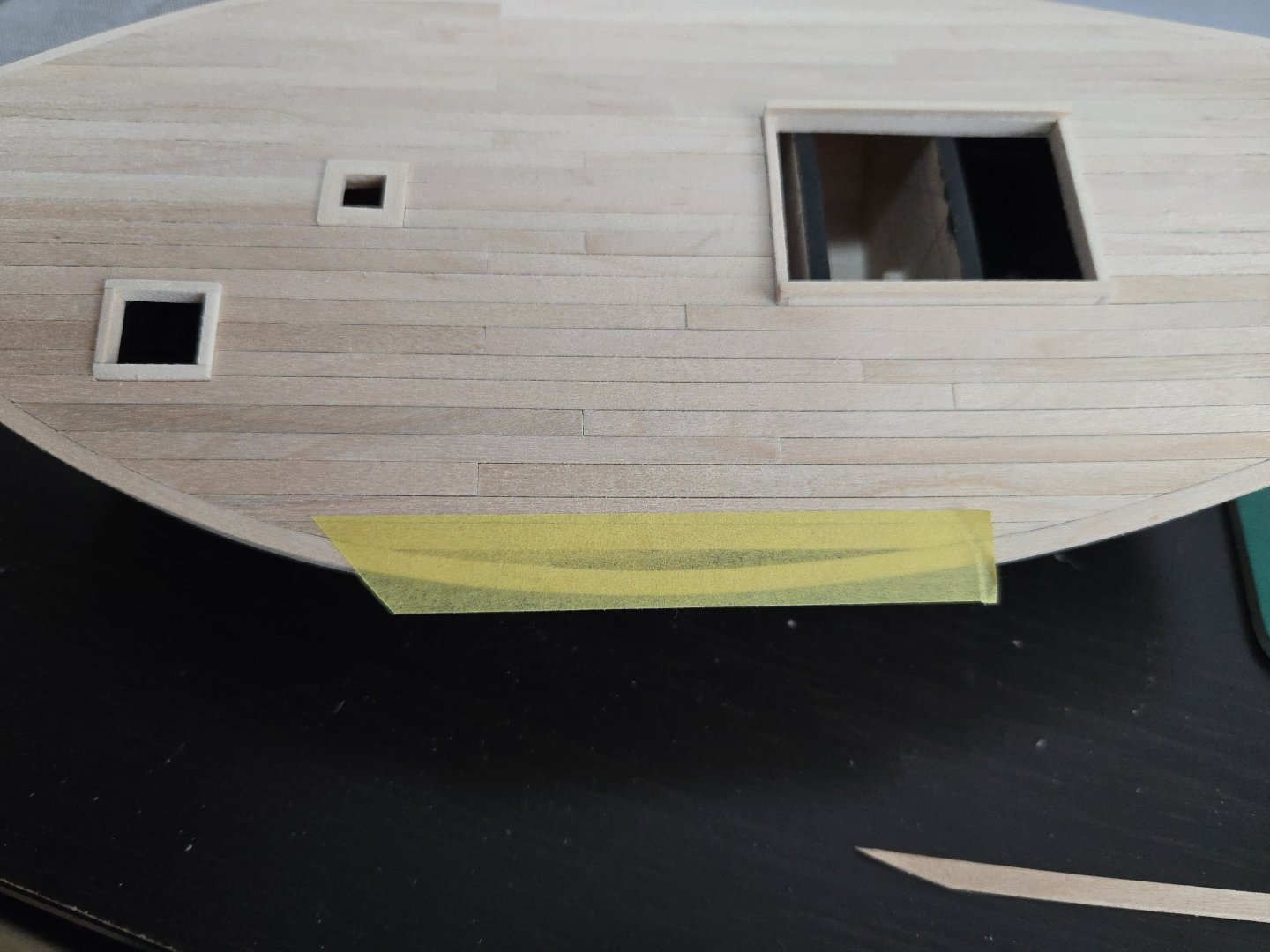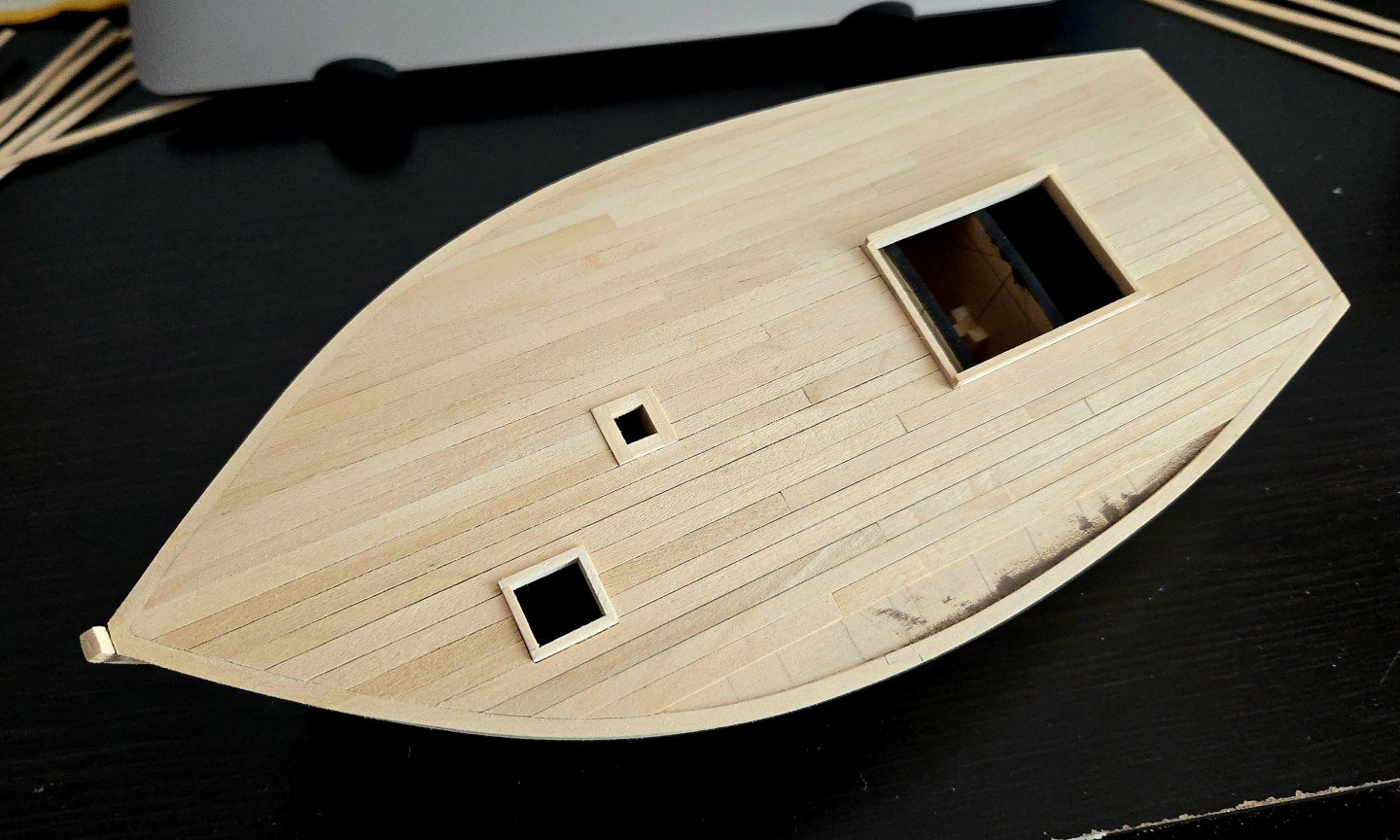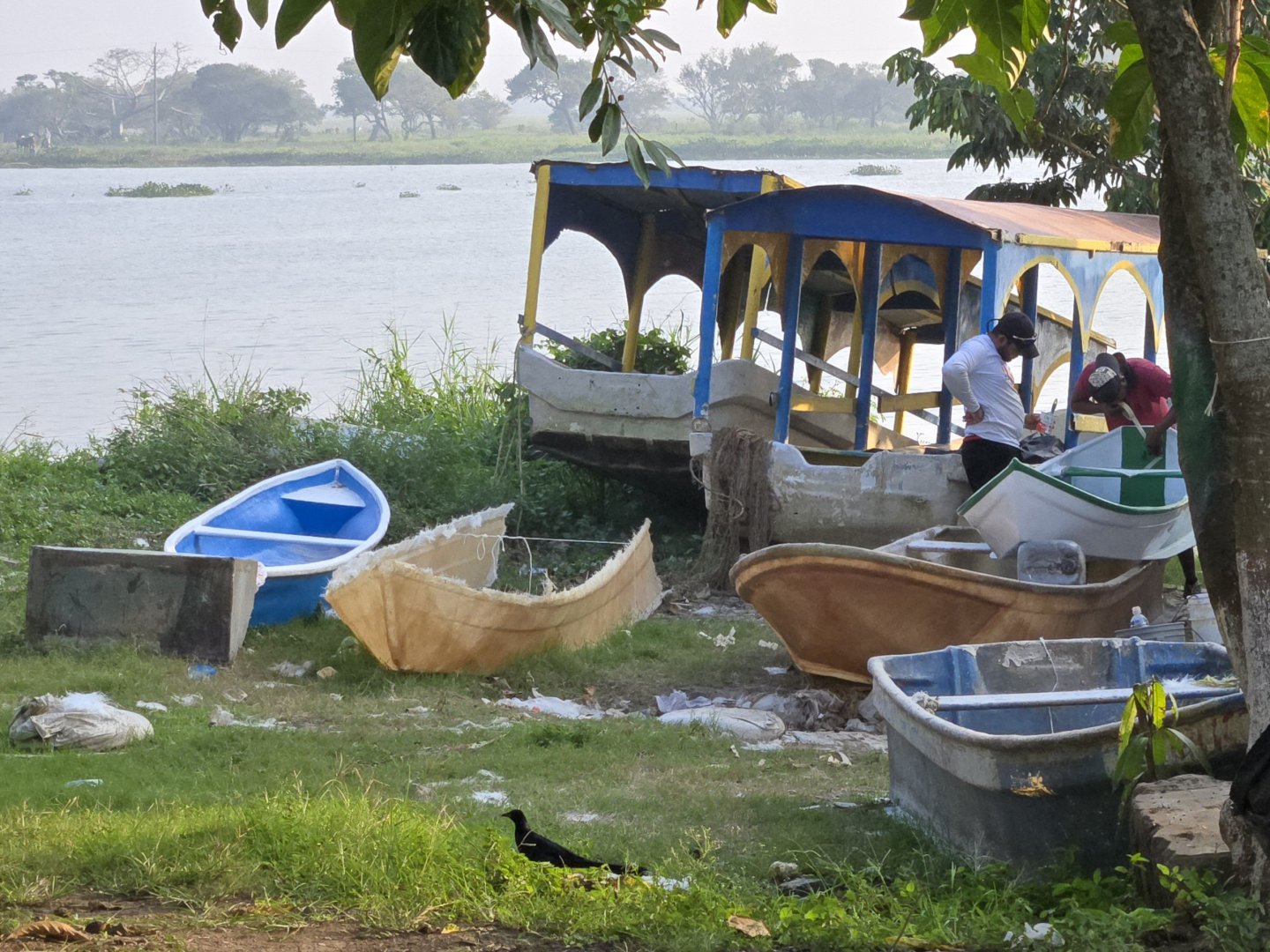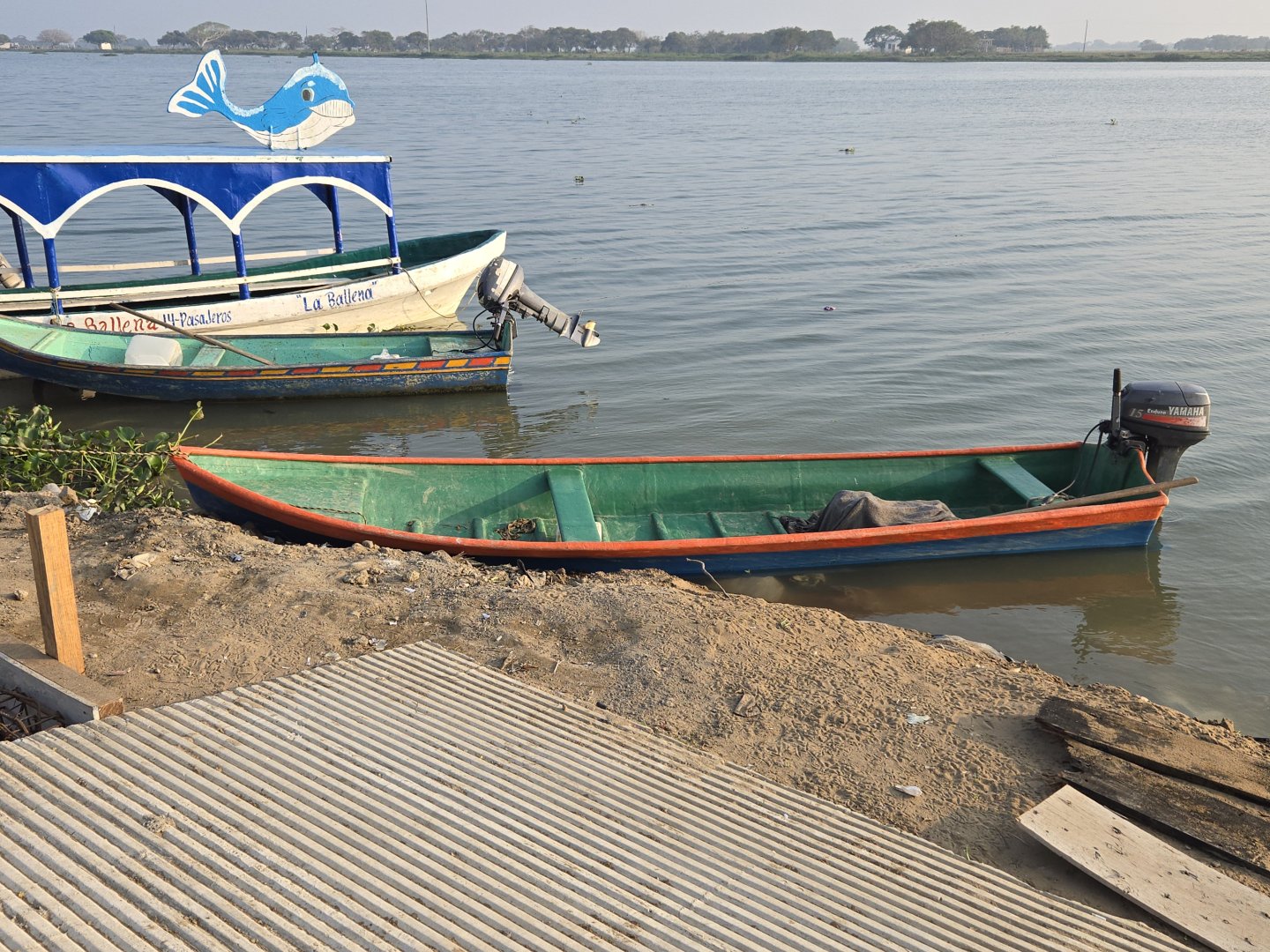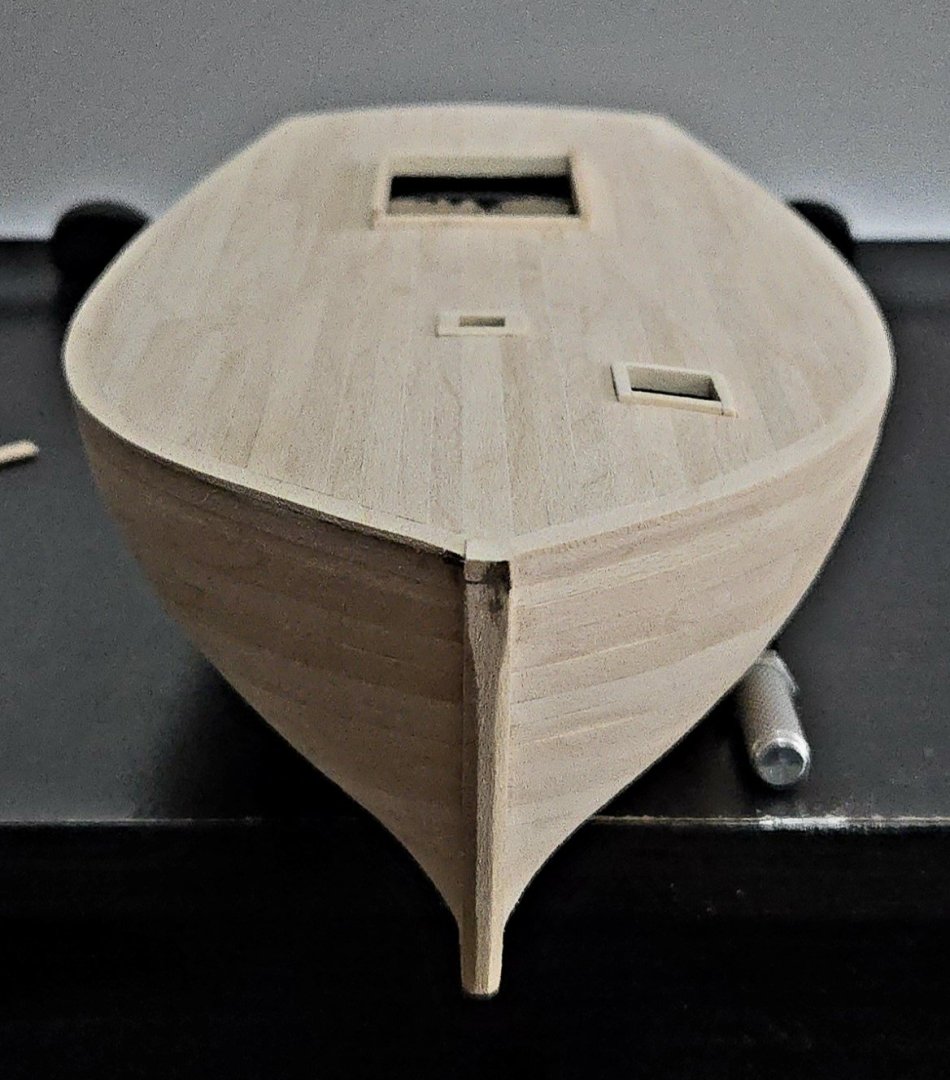-
Posts
1,309 -
Joined
-
Last visited
Content Type
Profiles
Forums
Gallery
Events
Everything posted by JacquesCousteau
-
Thanks, Keith and Wefalck! At this point, the model looks more like a boat than ever. Gluing and pinning the port stanchions (and knightheads) was a much faster process than on the starboard side. Especially pinning them, I did a much better job this time of making sure the hole was sufficiently cleared before gluing in the pin. Adding the bulwarks took a bit more time. I started at the bow. I realized that the wood needed to take a bit of a curve upward in the middle of the hull to fit properly, so I dampened it and clamped overnight so it would take the proper shape. I then worked my way back, cleaning up excess glue as I went. Finally, I added the corner pieces of the aft rail and trimmed off the excess bulwark length. Next up, I need to paint the topsides and add the cap rails. Based on photos, some lanchas didn't have cap rails, but most did, plus they'll cover the brass pins in the stanchions. I wish I had copied the templates for the covering boards, that would make this much easier. With hatch covers temporarily placed:
- 312 replies
-
- Chile
- Latin America
-
(and 6 more)
Tagged with:
-
I think that's what they did, but I haven't found a clear photo. Many of the more recent lanchas for which better photos exist have lower bulwarks with less prominent stanchions. To pin the stanchions in place, I started with wire (covered in superglue and inserted into pre-drilled holes). But after only a couple I realized that the wire was extremely difficult to push into the hole, as it obviously bends very easily. So I switched to a thin brass rod. This worked better, but still has a tendency to get stuck before getting to the necessary depth. I also added the stern rail, first leaving it overlength for ease of gluing and later cutting to size. This will form the lower level, but there will be a second layer at the corners to meet the height of the bulwarks. I also tapered the bowsprit with a mini plane and sandpaper. Finally, I added the bow stanchions/angled blocks (I'm sure there's an actual name for these) to fit around the bowsprit. Next up, the port stanchions.
- 312 replies
-
- Chile
- Latin America
-
(and 6 more)
Tagged with:
-
Thanks, Chris! I think there's a lot that I could be more precise about, but each build--and each part of the build--is a chance to improve. I've been working on the stanchions. Case in point about imprecision: while I was planning on doing ten stepped stanchions per side (besides the stern rail and the angled blocks around the bowsprit), I slightly adjusted locations while gluing and ended up with nine per side. I decided that this was fine, as this is a slightly small lancha. The bow block is not glued in the photo below. In order to properly fit the bow blocks, I now had to fit the bowsprit saddle, which I had already colored with a gray wash. I ended up placing this a bit further back than given in the plans, and than may have been typical, because I thought it looked better. Nonetheless, I did make sure to find at least a photo or two of lanchas with a similar bowsprit saddle location. The bowsprit still needs to be shaped. Next up, the port stanchions, aft rail, and angled blocks. I also will be testing drilling through the stanchions and the bowsprit to pin these in place with wire or brass rod, as they are not particularly securely glued and I would hate to snap them off by accident.
- 312 replies
-
- Chile
- Latin America
-
(and 6 more)
Tagged with:
-
I realized that there was actually a fairly simple way to make a jig to hold the stanchions at the correct angle. Basically, I took a short length of scrap--I think 1/16-inch basswood, although the thickness doesn't really matter--and glued a bit of 1/32-inch thick scrap to it at right angles, forming a step the thickness of the bulwarks. I'm then able to place the jig at the stanchion location. By holding it right at the edge of the deck/hull, it forms a tangent line to the shape of the hull cross-section at that point, while indicating the correct distance inboard to place the stanchion. The stanchion can then be glued to the deck while placed against the jig. The only problem with this is that there's no way to clean the excess glue between the stanchion and the jig. After it got very stuck the first time and I had to do more paint touch-up than I would have liked, I sealed the jig in superglue to reduce pva's ability to form a strong bond. This still didn't totally work on the next stanchion, so on the third I tried removing the jig before the glue had completely set. There's still a bit of clean-up to do, but it isn't too bad. I've also made the bulwarks from 1/32-inch thick basswood. In photos, I've seen a number of ways of handling scuppers. One of the most common, and the way that seemed simplest to model, was just to have a very small gap along the bottom of the bulwark except at the bow and stern. I used a combination of a mini plane and sanding sticks to make this. I also colored the interior with a dark gray wash. I'm not totally sure what angle the bow ends of the bulwarks should be cut to, so I need to fit the bowsprit to test. The bowsprit is made of 3/16-inch square strip and will be left mostly square, with slightly rounded edges. I still need to add the taper and cut it to the right size. I started work on carving the bowsprit saddle, which has been surprisingly tricky--not only does the top need to be cleanly shaped, but the bottom needs to be curved side-to-side and angled front-to-back to match the deck. My first try, in which I tried to get the top side correct before shaping the bottom, was a failure as the saddle cutout somehow ended up much too large. Not to mention that I didn't really leave myself enough space to properly shape the bottom. For the second try, I got the bottom right first, and then worked on the top, making a lot of use of files to sneak up on the right dimensions. Here it is test-fit: I then further shaped the top to get the proper curves on the sides. The second try is on the bottom in the photo below, with the first attempt above.
- 312 replies
-
- Chile
- Latin America
-
(and 6 more)
Tagged with:
-
@Jim Lad, I think you nailed it! Cutting out the stanchions was a bit time-consuming. Photos of two lanchas--the Quenita, upon which my planset is ostensibly based, and one of Vairo's--both show ten stanchions per side. Having trimmed a length of 3/32‐inch-thick scrap wood to the right height, I then used the razor saw to cut identical lengths, employing a stop for this purpose. I then cut the notches, using a few bits of scrap to make a crude jig to properly measure the sides. A larger, better jig would have been much more exact. However, photos show that the stanchions were often a bit irregular in real life, so I filed this under something to learn from in potential future builds that may be more exacting. I found that a thicker blade worked better for this work. Eventually I had quite a little pile of stanchions. I decided to pre-paint the stanchions, rather than paint them after attaching the bulwarks and risk having the finish ruined by gluestains. Based on Vairo's photos, I am painting them with a gray wash, so that they look lighter than the deck but also a bit weathered. I also made the fore stanchion pieces (which come to a wedge around the bowsprit) and the aft rail. At this point, I'm realizing that I have a bit of a problem. Originally I was going to glue and pin the stanchions in place 1/32-inch inboard of the edge of the hull, and then glue the bulwark to them. However, not only may it be difficult to line up the stanchions like this, but due to the deck camber, the edge of the deck isn't always perpendicular to the edge of the hull, so if I glue the stanchions directly to the hull, they're likely to bulge outward in places. With that in mind, I'm thinking that it may make more sense to make the bulwarks first: curving them with the use of hot water, painting the inner sides with a gray wash, then attaching the stanchions at predetermined points, and only then attaching the topsides to the hull. I'm not sure, though, how well this will work.
- 312 replies
-
- Chile
- Latin America
-
(and 6 more)
Tagged with:
-
Thanks! Yeah, it's definitely a tricky pattern. It looks like there was some sort of sealant placed over the deck that was bleached by the sun and for some reason only wore off along the center of each plank. Meanwhile the wood that shows through varies from a weathered gray to quite dark (possibly damp patches?). Not to mention the panels of some other material placed aft over the deck. It's also worth noting that written sources agree that lanchas usually just left the deck and hatches in bare, unfinished wood. The Marisol del Carmen was a more recent lancha, though, so presumably they applied something to try to better preserve the wood. The full photo is interesting as it shows that the white covering wasn't fully applied on the port side. Interestingly, the hatch coaming looks to be bare wood. There are also other details that aren't very clear--I'm not sure what purpose the big rocks have, for instance, they may be holding down the floor mat placed over the deck? Source: https://www.sigpa.cl/ficha-colectivo/carpinteros-de-ribera-de-lanchas-chilotas
- 312 replies
-
- Chile
- Latin America
-
(and 6 more)
Tagged with:
-
Great paint scheme, it looks excellent!
- 81 replies
-
- Norwegian Sailing Pram
- Model Shipways
-
(and 1 more)
Tagged with:
-
Thanks, Bryan! I actually can't say that I fully recommend that anyone follow my path on painting the deck. When applying the successive washes, I came across a problem that I hadn’t encountered on my tests: with all that water, the deck wood expanded and contracted a bit even though it was glued down. As a result, some small gaps opened up in the planking, and the edges of some planks curved up a little bit. I don't think it looks too bad from normal viewing distance, but if you run your finger along the deck, it's noticeable. I think I should have let the deck dry for several hours, or even overnight, between each wash layer. In the future, I may experiment with fewer wash coats and/or using artist's pastels (people like FriedClams have done amazing things with them). Perhaps using thicker deck planks would have helped, as well. By now, I've mostly painted the lower hull, although I'll likely do some touch-ups and perhaps one last coat later. I've also glued the mast partners and hatch coamings in place, although not the hatch covers yet. I also lightly sanded parts of the deck that would have seen more foot traffic and wear. Next, the bulwark stanchions are an interesting detail. On many other vessels, the stanchions run through the covering boards and are practically extensions of the frames. In contrast, on most lanchas, the stanchions sit on top of the covering boards, and have a wide base narrowing toward the top. The most common shape was a sort of stepped design, seen below in the vessel in the foreground, but some other designs were also used: see the trapezoidal design on the lancha in the background below, for example. Source: https://www.bibliotecanacionaldigital.gob.cl/bnd/629/w3-article-164722.html Another photo showing stepped stanchions: Source: https://www.carlosvairo.com/galeria-puerto-montt-lanchas-chilotas While the stepped design was most common, some other designs were also used, such as those below on the Marisol del Carmen supporting a very low bulwark. Source: https://www.sigpa.cl/ficha-colectivo/carpinteros-de-ribera-de-lanchas-chilotas The plans I have show stepped stanchions. However, while I'll be following the stepped design, I will need to modify the dimensions a bit. The plans show a 7/32‐inch tall (on the model) bulwark that extends up above the bowsprit, leaving a bit of a gap. However, most photos of lanchas (including those above) show the bowsprit level with the bulwarks or with the cap rail. My bowsprit is made from a 3/16-inch square piece of basswood. So, I'll need to reduce the height of my stanchions to 3/16-inch, something I wish I had realized before preparing 7/32-inch wide strips of 3/32-inch thick scrap wood.
- 312 replies
-
- Chile
- Latin America
-
(and 6 more)
Tagged with:
-
Undoubtedly a hard decision, but one that will pay off in the end! I definitely had to fair the bow and stern quite a lot on mine, it's a tricky hull. It's good practice, though--after having done a lot of sanding and shimming on the Half-Hull, I felt confident in dealing with similar issues on my Lancha Chilota scratch-build.
-
Thanks, Keith! I realized that I forgot to mention that I did end up just placing a black board across the bottom of the hatch interior, to keep the keel assembly out of sight. From a couple angles, if the light is just right, you can see the edge off on the sides--it had to be a bit short to fit into the hatch--but it's practically unnoticeable otherwise. My goal is to suggest that, while there is an interior, it's too shadowy to see any details, adding interest to the build compared with battened-down hatches. I've also begun painting the hull. Usually you want to start with lighter colors, but in this case the transition will be covered by the as-yet unmade rub rail, and I won't be painting the topsides until I've built the bulwarks. So, black it is for the lower hull. At the moment it looks terrible and uneven, which I've come to understand is what you want in a first coat. Many, many subsequent coats will follow. The final coat(s) will be with a slightly less intense shade of black, but for the base coats, the tint straight from the bottle works fine. Finally, I've begun looking at some other furnishings. Comparing the plan drawings with photos, some parts--like the bowsprit support--look a little undersized in the plans. I'm less certain about other parts. Does anyone know what a typical rudder thickness for a seagoing, ~30-foot-long boat would be?
- 312 replies
-
- Chile
- Latin America
-
(and 6 more)
Tagged with:
-
Following up: A lot of photos showing decks crowded with cargo show lanchas in port, and you would expect them to usually store things below while sailing. But, there are at least some photos, such as the one below, showing cargo (in this case lumber/firewood) being carried on deck while under sail. I would assume that this was usually only done for short voyages. Source: https://losbarcosdejuanvasquez.wordpress.com/2011/06/14/la-lancha-velera-que-transportaba-lena-y-maderas/ Incidentally, the photo also shows the lancha towing a couple of tenders. I've been considering whether I want to try making one, but work is about to pick up a lot and I may just focus on the lancha itself.
- 312 replies
-
- Chile
- Latin America
-
(and 6 more)
Tagged with:
-
Good question! A lot of lanchas were involved in the lumber trade. Many also carried farm produce to sell at markets. A few sources also reference carrying livestock, although I have no idea how you'd get any large animals in and out of the hold (sheep may be doable, though). The chief problem with showing a cargo in the hold is that the bulkhead limits the cargo to only the rear of the hold. Looking at it from many angles, it's very clear that the cargo arbitrarily stops at the bulkhead, making it look odd--lumber would undoubtedly extend a lot further forward, for instance. That said, I still plan on portraying cargo, it will just be on deck instead of in the hold. Plenty of photos show lanchas with fairly crowded decks, so a bundle of lumber or a few sacks of produce wouldn't look out of place. I've been working on painting the deck. I think it's nearly there, I may just scuff it up a bit in high-traffic areas around the hatch.
- 312 replies
-
- Chile
- Latin America
-
(and 6 more)
Tagged with:
-
Thanks, Keith! I'm considering options for how to handle the hatches. For the fore hatch, I'm fine leaving the interior empty. In actual lanchas, the space ahead of the mast was used for a heating stove and as shelter for the crew, with very minimal furnishings. The hatch opening is small, and with the hatch propped open as below, it's covered enough that it doesn't bring attention to the lack of detail below deck. I should note that the prop is just a bit of notched scrap, and it will be replaced. It also fell in the hatch twice. The main hatch is trickier. If it's open just a crack, the interior looks empty, unless there's direct light, in which case the central spine is very visible, as seen below: I rolled up some tape to test options to cover the spine. First, a barrel from the Syren barrel kit, which I made a while ago for the canoa but didn't end up using. I don't think this looks particularly convincing. I also chopped up a very rough coffee stir stick to try to simulate a shipment of lumber. Unfortunately, it looks a bit odd to only have it in the middle of the hold, and it's pretty visible how it just ends when it reaches the bulkhead, spoiling the illusion of a cargo load. So, I'm considering either closing the main hatch, or just adding a flat piece of wood painted black extending from the spine top out to the sides, so that it will just look uniformly black inside. I also started drilling holes in the keel for the mounting. I'm still leaning toward displaying the model upright, and would need to prep this now before anything is glued to the topsides, but the holes will not be very noticeable if I end up displaying the model resting on its bilge. Drilling was done very carefully, slowly ramping up in size, and regularly checking that everything was perpto the keel. Despite this, it ended up slightly off from perfect, but I don't think it's anything that's beyond the normal slight give of brass piping. Finally, I applied a sealer to the hull below the wales, in preparation for painting.
- 312 replies
-
- Chile
- Latin America
-
(and 6 more)
Tagged with:
-
Thanks, all, for the suggestions. I have to admit that I feel a bit conflicted sometimes between striving to get things as best as I can make them (at least in parts that will be visible on the finished model) and wanting to leave things realistically imperfect, the latter of which can be a bit tricky to get to scale. After considering your comments and thinking about my goal to represent a working boat, I decided against trying to repair the ding in the keel, and to just sand a little more at the bow to minimize the low spots. I also finished planking the main hatch, and applied a base wash to the top of the fore hatch. The next steps will involve making some decisions about how to display the model.
- 312 replies
-
- Chile
- Latin America
-
(and 6 more)
Tagged with:
-
Undoubtedly! Every written account I've seen mentions the crew (who were often all family) huddling below around the stove for warmth against the cold wind. A bit more progress on the main hatch. First, I applied a gray wash to the basic framework, so that I won't have to deal with so many glue stains inhibiting the wash later on. Second, I thought the hatch cover looked a little long (although I think it should be longer than the opening, given that it's open on both sides you'd want some overhang) and the middle beam was a little off-center, so I trimmed the over-long side and reattached the crossbeam. I then added the false crossbeam ends, making them from tiny bits of the same material which I pre-colored with a wash. They were extremely tiny, and I lost a couple when they popped out of my tweezers (thankfully I made extra). Hats off to those of you who work in tiny scales. I glued them to the sides of the hatch cover framework and faired the tops once the glue fully cured overnight, sanding very cautiously. Once the hatch cover is planked, it should trick viewers into thinking that all those crossbeams are there, unless they look closely. I then began planking, again using pre-wash-colored planks. The exterior will receive further coloration later. Finally, two questions: 1) I've been finalizing the sanding of the hull. Unfortunately, there are still a couple low points at the bow (see below). If I add a bit of filler here, will it still leave the individual planks visible once I paint the hull, or am I better off just sanding more? 2) Unfortunately, I dropped the hull on the hard floor while sanding, and it dented the aft end of the keel (see below). I suppose the best way to deal with this would be to cut out a larger squared-off chunk around this, replace it, and use sanding and filler to get rid of the cut marks?
- 312 replies
-
- Chile
- Latin America
-
(and 6 more)
Tagged with:
-
Thanks, all! I've never used sanding sealer under an acrylic wash before, so I decided to test how it looks with some scrap decks. I also was curious as to whether I could achieve an acceptable color with solely acrylics instead of alternating layers of stain and acrylic washes. On both scrap decks, the left half was left untreated before painting, while the right half received a coat of sanding sealer followed by a light fine-grit sanding. The top scrap deck was colored with alternating acrylic washes using colors directly out of the paint jar. For the bottom, I mixed specific colors and made washes out of them. For the top scrap deck, the four combos are, from left to right: 1a) black and dark brown washes on untreated wood, 2a) the same but with an added caramel-brown wash, 3a) the same colors as 2a but on wood treated with sanding sealer, and 4a) black and dark brown washes on sanding sealer. For the bottom scrap deck, the four combos are, from left to right: 1b) mostly a dark gray wash with a bit of dark brown wash on untreated wood, 2b) more dark brown wash on untreated wood, 3b) the same as 2b but on sanding sealer, and 4b) the same as 1b but on sanding sealer. Overall, while I quite liked the gray color, I think the top scrap deck looks closest to the brown decks that appear in photos, and 2a looks pretty similar to my favorite result from earlier tests with stains (which is just above the scrap deck in the photo). As a result, I think that I may not need to use stains after all. As for the sanding sealer, I had thought that it would even out the grain. While it did that for the first few layers, I feel like the unsealed wood ended up pretty consistent. I've also made progress on the hatch covers. For the fore hatch, I found several possible construction methods. One, seen below, just uses a few crossbeams to hold the hatch planks together. Source: https://www.memoriasdelsigloxx.cl/601/w3-article-86081.html However, I decided to go with the slightly more complex construction shown below, where a boxlike frame fits around the coaming. The frame will make it easier to prop open the hatch with a stick, as in the photo. Source: https://www.carlosvairo.com/galeria-puerto-montt-lanchas-chilotas I began by making the frame out of 1/16‐inch square basswood strip, building it around the coaming. I then planked it. Photos show that the fore hatch was planked side-to-side. I think it looks slightly bulky in the closed position, but when I hold it open, the size looks better. Finally, the exterior will be colored to match the deck. But I suspect the interior would be a bit less weathered, so I only applied a bit of wash there. The main hatch is a bit more complicated. As seen below, it's open at front and back, and there are lightly cambered crossbeams notched into tall side walls. Source: https://www.carlosvairo.com/galeria-puerto-montt-lanchas-chilotas There should be around 8 or so crossbeams. These posed a challenge: how could I make so many and all consistent? I also didn't want to make them by bending wood, as if they naturally opened a bit, the hatch sides would be pulled out at an angle. Moreover, that's a lot of notches to carve, and the notches are very fragile. My first attempt at the sides had to be discarded when the wood split around the notches. After some thought, I decided that modeling is in part about tricking viewers by taking advantage of what will be hidden on the finished build--like the underside of the hatch. I then carved just three crossbeams--enough to provide a decent gluing surface for the covering--and will glue on the exposed ends of the rest afterward. From the outside, it will look like a proper hatch, but on the inside, it will be greatly simplified. I then glued together the framework. Next up I'll need to fair the top slightly before adding the covering.
- 312 replies
-
- Chile
- Latin America
-
(and 6 more)
Tagged with:
-
Nice job on the frame! You asked about fairing. Looking at the edges of the frames, I think you need to fair substantially more, especially near the bow and stern. Fairing does two things: first, it allows the planking to take a smooth curve without any lumps or low poinrs, and second, it angles the edge of the frame to match the shape of the planking there, so that the plank isn't just barely glued to a corner but can be properly glued with more surface area. Generally when fairing, you'll leave very little of the laser char on the edge of the frames (although you usually want to leave a little, as otherwise you may deviate from the frame shape). The best way to see if you've faired properly is with a batten--a long, thin, flexible strip of wood. Place the batten along the frames and check if it contacts all the frames, if any are too high and need to be sanded more, and if any are too low and need to be built up. Then repeat at different distances from the keel, covering the whole hull. I think that fairing more at the bow would give you more surface area to affix your plank, too. Also, you mentioned that you're planning on planking first one side, then the other. I'd recommend instead placing a plank on each side in turn. Otherwise, if it's not balanced, the pressure of the planking can warp the underlying structure and twist the hull, which cannot be fixed later. You're off to a good start, and this site has lots of resources and information, some a bit buried in other build logs. Looking forward to following along with your build!
- 51 replies
-
- bounty jolly boat
- Artesania Latina
-
(and 2 more)
Tagged with:
-
Very cool, the parts look great! Another option might be, if you haven't already checked, to see if a public library near you has a makerspace. I was able to use one during my most recent visit to the US to laser-cut parts for an upcoming build. They taught me how to use the software, the only cost was for the materials. They also had a CNC router and a 3D printer, although I didn't use them, and my wife had fun learning how to use their Cricut machine. Depending on what's available near you, it could be another good option, although it sounds like Print A Thing was very fast and reasonably priced.
-
Looks like a tricky hull to plank!
- 90 replies
-
- Friendship Sloop
- bluejacket shipcrafters
-
(and 1 more)
Tagged with:
-
I have yet to visit the Caribbean, although I hope to someday. It's interesting what gets taken up and what doesn't. About a month ago, I visited the small river town of Tlacotalpan, Veracruz. In the 19th century, it was a relatively important port, where goods from Oaxaca were brought by trajinera barges (which interestingly have very little in common with the trajineras of Mexico City) to be transferred to ocean-going ships, but river trade declined after the construction of a railroad across the isthmus of Tehuantepec. Today fishing for local markets is a common activity, and fishermen have totally adopted locally-made fiberglass boats. Interestingly, they favor smaller, narrower vessels than the pangas I've seen elsewhere, while fishermen in the nearby seaport of Alvarado use both types. Below, the smaller vessels are in the foreground, while the tour boat at back left is the type of panga I've seen elsewhere. Boatbuilding in Tlacotalpan: Back to the lancha: while finishing planking the deck, I sanded down the already-complete starboard side. As can be seen below in comparison with the unsanded port side, sanding really made a difference and got rid of most of the unevenness. Continuing on the port side, I finally was down to the last plank, which turned out to be slightly smaller than its starboard counterpart. Rather than the trial-and-error method I had previously used, I decided to follow my hull planking method and use tape to mark out the plank. This helped in getting the rough shape, but there was still a lot of trial-and-error testing, sanding, and testing again. Finally, it was on. I was then able to remove the hatch coamings and mast partners and sand the deck. I still need to use a finer grit of sandpaper on everything. Next, I need to build the hatch covers, which with the coamings will be stained and painted the same as the deck.
- 312 replies
-
- Chile
- Latin America
-
(and 6 more)
Tagged with:
About us
Modelshipworld - Advancing Ship Modeling through Research
SSL Secured
Your security is important for us so this Website is SSL-Secured
NRG Mailing Address
Nautical Research Guild
237 South Lincoln Street
Westmont IL, 60559-1917
Model Ship World ® and the MSW logo are Registered Trademarks, and belong to the Nautical Research Guild (United States Patent and Trademark Office: No. 6,929,264 & No. 6,929,274, registered Dec. 20, 2022)
Helpful Links
About the NRG
If you enjoy building ship models that are historically accurate as well as beautiful, then The Nautical Research Guild (NRG) is just right for you.
The Guild is a non-profit educational organization whose mission is to “Advance Ship Modeling Through Research”. We provide support to our members in their efforts to raise the quality of their model ships.
The Nautical Research Guild has published our world-renowned quarterly magazine, The Nautical Research Journal, since 1955. The pages of the Journal are full of articles by accomplished ship modelers who show you how they create those exquisite details on their models, and by maritime historians who show you the correct details to build. The Journal is available in both print and digital editions. Go to the NRG web site (www.thenrg.org) to download a complimentary digital copy of the Journal. The NRG also publishes plan sets, books and compilations of back issues of the Journal and the former Ships in Scale and Model Ship Builder magazines.



